- About Katie
- Application Essays
- The Journal
- Join Thousands on My List


31 of the best class presentation tips for students
Katie September 20, 2022 communication , grades

By Katie Azevedo, M.Ed.
Giving class presentations is just part of the school experience. Some students dread presenting to their classmates, and others prefer class presentations to written assessments. If you’re new to this, or if you’re just looking for some ideas, I share my best class presentation tips for students in the post below.
Class presentations often involve a visual component, and an audio and delivery component. The tips in this post are for class presentations that involve SLIDES, such as Google Slides or PowerPoint. Therefore, I break down the class presentation tips for students into the following categories:
- text and content
- Audio and delivery class presentation tips
- Bonus class presentation tips to up-level your game
Class presentation tips for VISUALS
The following tips will enhance the visual component of your school presentation. The strategies are further categorized by format, text, and images.
Class presentation tips for slide FORMAT
The visual format of your presentation must be clear and easy to read.
1. Use a slide deck.
This class presentation tip is obvious, but I can’t leave it off the list. If you’re presenting to your fellow students, you will need some kind of visual representation of the information you’re delivering. Very rarely will you present to your class without slides. Google Slides and PowerPoint are the two primary products to make slides.
2. Use the right number of slides.
Class presentations in high school and college will likely be 5 minutes or less. Follow your teacher’s guidelines, of course, but generally, students will use 1-2 slides per minute. (That would be 5-10 slides for a 5-minute presentation.)
3. Use an appropriate slide template and theme.
PowerPoint and Google Slides come with default slide templates (themes). Most of the default templates are suitable for class presentations, and so you should be fine choosing one of those. You can also find templates on the free version of Canva. I like slidesgo.com for free templates (it’s not sketchy – I’ve personally used it. I also like SlidesCarnival.com but you have to import the templates into Canva first, and then export them from Canva into Google Slides or PowerPoint.
4. Use clear fonts.
Pick your font based on clarity, not creativity. Your audience should be able to read your text effortlessly and from the back of the classroom. Here are some rules:
- Avoid cursive / script fonts
- Avoid writing in all capital letters
- Avoid fonts that are entirely in italics (slanted)
5. Use a maximum of two fonts.
Stick to two fonts: one for headings and titles, and one for body text. More than two fonts make your slides hard to read.
6. Use 3-4 colors.
Stick to a basic color palette of no more than four colors. It’s fine to use images that are outside your color scheme, but besides images, avoid too many colors. Most default templates stick to four colors or less, so you’re safe if you use a pre-made template.
7. Use high-contrast text-on-background combinations.
Your text needs to stand out from the background color. Black font on a white background or white font on a black background provides the highest contrast and best readability. This website here provides excellent information and examples about color combinations.
Class presentation tips for slide TEXT and CONTENT
8. start with a simple title slide..
Your teacher will likely require a title slide in the syllabus. Even if it’s not required, make one anyway. A title slide should be simple: the name of the presentation, your name, and a simple graphic or image.
9. Include a roadmap slide.
A roadmap slide (I made up that term, but it works) is like a table of contents. It tells your classmates what they will learn from your presentation. Even if your presentation is only 6 slides long, a roadmap slide can be helpful. Below is an example.

10. Include enough white space.
White space is the blank space that doesn’t contain text or images. White space is very important for readability. In the image below, you can see the impact white space has on readability.

11. Use bullet points.
Whenever possible, use bullet points instead of complete sentences. Most slides should include no more than 5-6 bullet points. If you need to say more, continue the bullet points on another slide.
12. Leave some text off the slides.
Your slides should include minimal to moderate text that you will elaborate on during your class presentation. In other words, don’t cram the slides full of everything you want to share on the topic. The only exception to this rule is if you are not verbally presenting to the class, but are instead just sharing the slides with your classmates to view on their own.
13. Include examples.
Examples make most things clearer. When possible, include an example for all your main points.
14. Include statistics and other quantitative information.
Use numbers in place of text when you can. Numbers and statistics can be easier for your audience to process. Example below:
- Instead of saying this: There is one-third as many Giant Pandas living in 2020 as there were in 2014.
- Say this: Giant Panda population in 2140 = 1864 | Giant Panda population in 2020 = 600 [ source ]
15. Include a summary slide
Consider adding a final summary slide to your class presentation. This is an excellent strategy because it will increase your audience’s understanding of your main points. The text on this slide should be in bullet-point format. The information on this slide might align with the information on your roadmap slide.

Class presentation tips for slide IMAGES
16. include an image or graphical element on each slide..
Every slide should have some kind of graphical element to complement the text. Some slides might even have an image and no text. (You would explain the image in your verbal presentation to the class.) Note: be sure to cite all images.
17. Use images / graphics for illustration and emphasis, not decoration .
Avoid using images for decoration. Images and graphics should do one of the following:
- Add something valuable to the text
- Illustrate the idea on the slide
- Represent the idea on the slide
- Emphasize an element of the slide (such as underlines, stars, etc.)
18. Resize and reformat images.
Resize images and graphics to fit the scale of your slide. It should be big enough to see clearly, but still allow for plenty of white space (Class Presentation Tip #10). You can remove the background of an image using a mobile app, or something like the paid version of Canva or PicMonkey. Again, be sure to cite your images.
19. Use video when appropriate.
If your presentation calls for it, include short video clips. Only use video if it adds value.
20. Use icons for emphasis.
Use icons like stars, 3D shapes, speech bubbles, and arrows to emphasize important text. Keep these icons within your color scheme. You can find free icons within Google Slides and PowerPoint, or you can use Google Images or Canva.
21. Use graphs and charts.
Too much text is confusing. Too many images is boring. Solve this problem by using pie charts, bar graphs and other graphical ways of representing data.
Class presentation tips for SPEAKING
You might have the best slides in the class, but your presentation is not complete until you deliver it to your classmates. The following tips are for improving your audio and delivery.
22. Never read directly from the slides.
Use the slides as a reference, but don’t read word-for-word. How do you do this? First change to the next slide. Then look at it for cues. Next, speak directly to your classmates, making eye contact as your speak. It’s okay to glance back at the slide if you need to.
23. Face your audience.
Your body should always face the audience. Stand or sit either straight on, or at a 45-degree angle. Never have your body square to the presentation screen.
24. Explain the images.
When you present each slide, you should spend some time on the text and some time on the images. If your images add value (which they should), then this should be simple to do.
25. Speak slowly and clearly.
Speak slower than you naturally speak. Practice difficult words until they are smooth.
26. Use verbal transitions between topics.
When you change topics, use transition expressions such as “Next, we are going to look at …” or “Now, let’s move on to …”
27. Practice more than you want to.
Practicing your class presentation over and over improves your delivery and increases your confidence. Practice in front of the mirror, in front of others, or in front of your camera (to be watched later, of course).
Bonus class presentation tips for students: How to up-level your game
The following bonus tips are for students looking to take their class presentations to the next level. Keep in mind that some of the ideas below are best suited for college and university students.
28. Provide a printed note-catcher.
An engaged audience is the best audience. To increase your classmates’ active focus, provide each student a printed note-catcher they can use to follow along with your presentation. PowerPoint and Google Slides both have features that enable you to print out your presentation with the slides on the left and space to take notes on the right.
29. Ask questions and survey your classmates.
Another way to engage your audience is by asking them questions. You can build these questions into the slides themselves, or you can pause your presentation to ask questions before moving to a slide with the answers.
30. Use the Speaker Notes section .
The text on your slides should vary from the words you speak to your classmates during your presentation. Either you practice your presentation so much that you memorize it, or you use the Speaker Notes section on PowerPoint or Google Slides.
31. Open with a question, and close with an answer .
A great class presentation tip for students is to open with a question you pose to your classmates at the beginning, and then close with the answer. You could put the question on its own opening slide and then close with another slide that re-poses the question and features the answer.
For example, if you are presenting on Susan B. Anthony, your question could be Who was Susan B. Anthony? and the answer – which is the point of your presentation – could be Susan B. Anthony was one of America’s greatest champions for freedom and equality of women and slaves. College-level presentations would have more complex question-and-answer pairings than this example, but you get the idea.
Class presentation tips for students – summary notes
It’s important to follow your teacher’s requirements when creating your class presentation. Use these tips and strategies to maximize your grade, impression on the class, and your content delivery – but always consult your syllabus first.
And finally, the greatest tip of all is to PRACTICE. In Tip #27 I emphasize the importance of practicing more than you want to. Watch TED talks and other notable speakers to see how smooth they speak – these presenters have practiced the same presentation hundreds of times. Practice is the key.
More resources
- How to ask for help in school: 4 tips for self-advocacy
- What to do when you’re confused in class
- 5 life skills all students need to be functional adults
Subscribe to ReportCard Newsletter!
Get your FREE download of 25 School Habits and Hacks when you sign up for our monthly newsletter featuring awesome school tricks and tips
I will never give away, trade or sell your email address. You can unsubscribe at any time.
- Health Science
- Business Education
- Computer Applications
- Career Readiness
- Teaching Strategies
« View All Posts
Computer Applications | Microsoft PowerPoint | Microsoft Office | Middle School
The 4 Best PowerPoint Lesson Plans for Middle School
- Share This Article
January 12th, 2022 | 8 min. read

Print/Save as PDF
Middle school computer teachers need engaging Microsoft PowerPoint projects and ideas to teach students. But where can you start?
That’s why we’ve pulled together the four best Microsoft PowerPoint lesson plans for middle school:
- An Introduction to Microsoft PowerPoint
- The Basics of Building a PowerPoint Presentation
- More Features in PowerPoint
- Do’s & Don’ts of Effective Presentations
Before we get into the lessons, it’s important to know where your students stand when it comes to using Microsoft PowerPoint . It’s easy to forget that this may be the first time some students have used it!
To get a quick gauge of your students’ previous experience using PowerPoint, ask them to raise their hands if they’ve used it either at home or for school. Depending on the outcome, you’ll know where to start with your lessons.
If no one raises their hand , you’ve got to start from ground zero -- but at least everyone is on the same page!
If some students raise their hands , your lessons will need to get everyone up to speed, plus challenge students who have used PowerPoint before.
If all students raise their hands , your lessons will end up being a review of the basics, with more time spent on the finer details of creating effective presentations.
For the purpose of this article, the following lesson plans are written for a class full of students who have never used PowerPoint. If your classes fall into one of the other segments, you’ll need to adjust the lessons to best meet the needs of your students.
Let’s get started!
1. An Introduction to Microsoft PowerPoint

A smart way to introduce middle school students to Microsoft PowerPoint is by sharing example scenarios of when someone may use it.
Then, transition to showing PowerPoint at the front of your class and highlighting what makes PowerPoint unique.
Some key points to mention include:
- PowerPoint templates
- Slide layouts
As you go over these items, you can demonstrate how to build a PowerPoint presentation by applying a template, choosing a theme, and creating slides with different layouts.
Last, show how to save the file to access at a later time, since your students will do this during their practice activity.
Activity: Create a New Presentation
Now that you’ve shown your students how to create and save a presentation, it’s time for your middle schoolers to practice what they’ve learned!
Start by having students create a presentation about something they like. Some ideas could be:
- Favorite book
- Favorite movie
- Favorite food
While your students decide their presentation topics, pass out the requirements for how many slides they should add and which layouts they should use.
Then, instruct them to open a new, blank presentation in PowerPoint, choose a theme, and add the appropriate slides per your instructions.
You’ll also need to show them where to save their presentations once they’ve completed the steps. Most teachers create a file folder on the network for each class to save their work.
It’s key your students properly save their presentation since it will be a base for the next PowerPoint project!
2. The Basics of Building a PowerPoint Presentation

Once your students have practiced using themes and slide layouts, it’s time to get into how a presentation is built!
It’s smart to show your students how to manipulate text boxes, add text, and format the text. If you’ve already taught lessons on Microsoft Word , this is a great time to relate back to those formatting options, since they are the same in PowerPoint!
While talking about text boxes, it’s important to mention how some slide layouts already have text boxes on them while others do not.
After going over text boxes, you can teach your students about other objects, such as:
A great way to highlight these items is to demonstrate adding and editing them in front of your class. As you do, give scenarios of why someone may use these different objects in a presentation.
After your demonstration is complete, it’s time for your students to practice!
Activity: Practice Working with Text, Images, & More
Now it’s time for your students to apply what they’ve learned about adding text boxes, images, and other objects.
First, instruct them to open the PowerPoints they created in your last lesson. Then, test their knowledge on adding and manipulating different elements with a series of tasks.
You could include instructions for:
- Adding a title to the presentation
- Inserting and adjusting images
- Adding and formatting shapes
Your instructions should be structured and easy to follow, but you can still encourage creativity for completing the tasks. You want your students to do the work, but following exact steps won’t have as much of an impact as adding their own flair.
Make sure your students save their work to use the presentation again in the next lesson!
3. More Features in PowerPoint

Now that your students know the basics of Microsoft PowerPoint, it’s time to go in-depth and teach them some of the more advanced features!
Some ideas you could cover include:
- Using and editing external images
- Adding audio clips
- Inserting hyperlinks
- Adding action buttons
It’s best to introduce these features via lecture like your previous lessons, but you can spend more time demonstrating each of these actions than the basics.
In addition, it’s a good idea to have students practice these skills along with you before they go back to working on their own presentations.
To do this, instruct your students to open a new, blank presentation. Then, go through each demonstration and have them follow along to make sure they understand how each of these features work.
Once you’re confident most students have a handle on how all of these features work, it’s back to working on their own!
Activity: Make Your Presentation Interesting
As with the other hands-on practice activities, start by having your students open their saved presentations.
Then, ask them to spice up their presentations by adding a few of the elements they just learned.
It’s smart to give them some ideas of where to start, such as:
- Including a hyperlink to a website that relates to their topic
- Inserting an action button to play an audio clip
At this point you can give your students some free range to be creative in making their presentations more interesting. But to keep them on track, provide a list of “must do's” such as having a certain number of hyperlinks or adding images to specific slides.
If you’re running low on class time for students to complete this activity, you can have students finish it as homework to be reviewed next class.
4. Do's & Don'ts of Effective Presentations

Now that your students have the skills for creating a presentation, it’s time to take a step back and show them how to make an effective presentation.
Just because they know how to add text and images, that doesn’t mean they know the best way to do those things!
For this PowerPoint lesson, you’ll need to do some work up front.
Before class, create a presentation with some examples of both bad and good examples of presentation slides. You’ll use this presentation in the second part of your lesson.
In class, start your lesson by talking about why it’s important to pay attention to the details when creating a presentation. Following these tips can make or break how a presentation is received by the audience!
Some tips to mention include:
- Not filling a slide with paragraphs of text
- Using bullets and numbered lists
- Leaving white space on the slides
- Using consistent colors and fonts
When going over the tips, make sure you discuss why each point is important and how to decide whether a slide is effective.
After going over the tips, it’s time to open your example presentation. Instruct your students to spot the problems as you go through the slides. If someone thinks a slide could be improved, they can raise their hand and give a suggestion.
Getting your students to look at someone else’s presentation and provide feedback is a great way to reinforce why it’s important to pay attention to the details when creating their own!
Activity: Apply the Principles of Effective Presentations
Once you’ve gone over the do’s and don’ts of creating an effective presentation, it’s time for your students to apply what they’ve learned!
Instruct your students to open their saved presentations and revise their slides to be more effective.
If your students work well together, have them pair up and give each other suggestions based on what they just learned.
As they do so, walk around the classroom answering any questions that come up. At the end of class, have everyone save their work in the designated location.
A great way to wrap up PowerPoint projects for middle school is to have everyone show off their work in the next class period. To make it more interesting, have students vote on who made the most effective presentation!
Start Teaching Microsoft PowerPoint Today!

Now that you’ve got some ideas for Microsoft PowerPoint lesson plans, what’s next?
You could take these lesson ideas and jump right in to creating your lessons. Or you could check out a ready-to-use curriculum that has more than 30 hours of content to teach your students how to use Microsoft PowerPoint!
iCEV's Business and Media curriculum is comprehensive and designed to save you time when teaching subjects like Microsoft PowerPoint. The system includes interactive student lessons, pre-made lesson plans, teacher presentations, assessments, and more.
And there’s more than just PowerPoint lessons -- iCEV has hundreds of hours of computer applications curriculum to help you teach all of the Microsoft Office applications!
Want to learn more? Check out our Business, Marketing, Finance, IT & Media Curriculum!

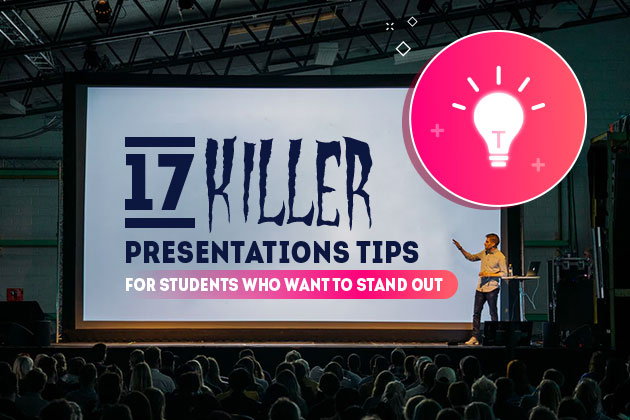
17 Killer Presentations Tips for Students Who Want to Stand out

The best presentation I ever heard was about soap.
The presenter was a big football jock and before he began speaking he pulled out a small, pink bar of soap, threw it in the air and said, “This is my favorite scent – lavender rose.” The whole room chuckled, and he proceeded, “Now I’m going to tell you how this bar of soap has destroyed society.” My jaw dropped.
As a former student who has been through many mind-numbing talks, I was shocked; this guy wasn’t boring, and he wasn’t nervous. He made presenting look like a breeze! But how did he take such a banal assignment and get the whole class glued to him like a beard on a hipster!?

What exactly made “Mr. Football Soap” stand out!? And what makes any good presenter stand out for that matter?
We remember presentations and speeches by Steve Jobs, Oprah Winfrey, and Bill Clinton because, although they may have different personalities and delivery styles – they all share the same secrets when it comes to delivering presentations. So whether you are in middle school or graduating college (or anywhere in life), follow these 17 steps and your presentation will be received with a standing ovation.
1. You Have a Personality, Show it
Conan O’Brien is notorious for making fun of himself (here’s a clip where he accepts the title as Ginger Ninja ), while Jerry Seinfeld turns ordinary situations into incredible drama. Are you goofy? Are you good at impressions? Do you have over the top energy or do you have a soft tone that can calm a crowd? Whatever you got, use it and be you!
2. Surprise them, Talk to a Cartoon
This is a pretty amazing trick I’ve used in the past and it’s bound to shock any audience. You can create a short animated video, using animation software such as Powtoon , integrate it into your presentation, and interact with an animated character. It can be a cartoon, a celebrity, an evil corporate boss or even the smiling sun! Just prepare the character to pop in from the right or left- then stand on the opposite side and interact. That’s it! You’ve added a new dimension to your presentation. Extra kudos if you take a few more minutes to add in a speech bubble or voiceover!

3. Don’t Read
PowerPoint was created to show bullets and short text. The purpose of your written words are to act as a trigger; they get you talking about each point. The rest should come from you. Spend the time choosing your keywords and not writing descriptions.
4. Improvise
No one is 100% sure what they’ll say or how they’ll say it. Take former President Bill Clinton for example; When it comes to improvisation, Clinton gets the Oscar. During his very first State of the Union address, the wrong health-care speech showed up on the teleprompter, so he relied on his memory and common sense to wing it. Clinton ignored over 20% of the initial speech! Smooth and rehearsed presentations don’t make history. So don’t be scared, pull out the unexpected!
5. Use Your Hands
Italians do it, pick up artists do it, and successful politicians do it: Move your hands! Point to a picture on the slide, add gestures, mimic a motion, and use your hands to emphasize the expressions on your face.
6. Pump Yourself Up
Pre-gaming is all about preparing for the final game. In this case, you may want to loosen nerves by jumping up and down, screaming out the title of your presentation or practicing the entire thing, one more time, in front of the mirror… Your energy level sets the bar! Yes, that exclamation mark was put there to prove a point! When you are pumped up it’s easy to extend this energy to your audience. You are not lecturing to a college class, or reading off data to your peers, you are on stage! And you are excited. Be loud, be enthusiastic, and be happy.
7. Take a Pause, Prevent ‘Ummmm…’
This is one of my favorite tricks, if you get stuck or nervous in the middle of your presentation, saying “um” or “Ah” feels good because it fills the silent room. There are 2 quick fixes: Talk slower and add pauses for emphasis.
8. Vocal Variety
Do you want to ride a rollercoaster or stare at a still river? When it comes to speech the rollercoaster is the way to go! Amazing public speakers alternate their voice and tone between loud and low, excited and serious, soft and dramatic… this is called “vocal variety” and it keeps people tuned in to what you have to say.
9. Look em’ in the Eyes!

Don’t talk at people, talk to them. Look at the students in the front row, in the middle aisle and at the back. You don’t have to consciously remember this; just integrate eye contact into your presentation by moving around! Pacing a bit or changing sides will naturally move your eyes to different areas of the room . Stop in the middle of the presentation and ask a question, look around at those who answer or agree/ disagree.
FYI: focusing all your attention on the decision maker (i.e. professor, teacher, investor) is a big mistake – You’ll get an A if you delivered your message effectively, not by selling to the teacher.
10. Let Images Take Over Your Screen
Images are powerful. Instead of using bullets on each slide to emphasize your point, you can take up the whole screen with a strong or even controversial image. Are you making a presentation on foreign language, show a confused tourist in Paris! Are you speaking about technology in third world countries? This image by Sven Torfinn is breathtaking! Allow the picture to engage for you. Check out these 11 Free and Awesome Image Resources for your next Presentation if you’re looking for an image to wow your audience.
11. Make ’em Laugh
Being professional and informative does not mean you can’t be fun! We all know humor makes everything lighter and better! And there is almost always a way to fit in into any presentation. When Steve Jobs introduced the iPhone 4 on the huge projector screen (which looked like an exact duplicate of the iPhone 3) he joked, “Stop me if you’ve seen this before.” He knew the audience anticipated a grand new design so he beat them to the punch with a short quip.
12. Tell a Story
We listen to people when we connect to them and we connect to them through telling stories . Why? Because telling stories builds trust. You are sharing a part of you that you may not necessarily share with everyone. A personal story is the fastest way to build trust, show you are human and stir emotion. The emotion can be laughter, sadness or tears, it doesn’t matter, by conveying your message through a narration you have paved the way for any subject or topic. Just ask Jacob Barnett , the 14-year-old astrophysicist who was labeled as autistic. He shows you how society can be dead wrong as he takes you along his journey from outcast to prodigy.
13. How to Pick the Story You Tell
Pick a story your audience can relate to; If you are marketing a product or advertising a service this can be difficult, but luckily you are presenting to fellow students! So put your brain in their brain.
For instance, if you are presenting to college students, what do they like, what do they fear… I can list a few now: College is when you are on your own, when you fall in love, when you gain the ‘Freshman 15’ or join your first gym. You learn about what subjects make you passionate and how exams can steal your sleep. How does one of these experiences connect to your presentation topic?
14. Aristotle’s Golden Rule of Three
This trick is taught to college freshmen in Business 101. Aristotle stated it simply in his book ‘Rhetoric’: After learning something new, people tend to remember three things. That means that your audience members will take away only three important points from your 10 or 15-minute presentation. So don’t stress on the finer details. Of course, it is important to have the right data, but your goal is simple — educate the audience on a new idea, a solution or the main research of your topic, not the fine print. You should repeat the main ideas throughout your presentation and summarize them at the end so that the important points stick!
15. Arrive Early with Technical Backup
The best way to avoid a bad situation is to take preventative measures. Check your presentation software that morning, make a backup, upload it to Dropbox and bring an MP4. Then make ANOTHER BACKUP. When you arrive at the class check that all technical items, such as the computer and projector hook up and work efficiently. This step does wonders to relieve speaking anxiety!
16. Preparation Equals Confidence
You need to research and understand your topic… and actually find something about your topic that you can connect to; Unfortunately, PowerPoint and slideshows in general, make people believe that throwing a bunch of words onto a slide makes you an expert. But, If you don’t know the information that you’re presenting, the audience will pick up on it. KNOWING YOUR CONTENT is the best pre-game confidence booster!
Try Powtoon with an EDU Account!
17. own it, pride and apologies.
You may not be the researcher who came up with the stats but you took a topic, organized it, and summarized the data… be proud. If an audience member or professor points out a mistake or asks a question you are unsure of – own it! Apologize if you are incorrect and praise the questioner! You can say, “wow, you make a good point, Thank you, I just learned something new” or “ Great question, I’m not sure of the answer I’ll look it up later and get back to you with the results.” Confidence and humility taste better than peanut butter and jelly (well, it’s pretty close).
There you have it, just follow these 17 killer presentation tips and you will surely be the student that stands out! (And by the way, the takeaway from the soap presentation was that too much cleanliness can actually make us sick… a message was presented so well, it has stuck with me ever since)!

What’s your favorite tip? Do have any additional presentation tricks that have worked for you!? We’d love to hear about it in the comments below!
- Latest Posts
Nirel Matsil
Latest posts by nirel matsil ( see all ).
- Back to Work After COVID-19: Your Video Guide to Transition Back to the Office - May 27, 2020
- 57 Totally Do-able, Off-the-Wall Mother’s Day Gift Ideas to Make your Mom Super Happy - May 5, 2020
- How to Set Up an Effective Home Workspace: 5 Useful Tips for Remote Working - March 26, 2020
- How to Inspire Your WFH Employees: 7 Examples of Animated Internal Comms Videos - March 25, 2020

Powtoon Joins Clever to Bring Video Creation to the Classroom
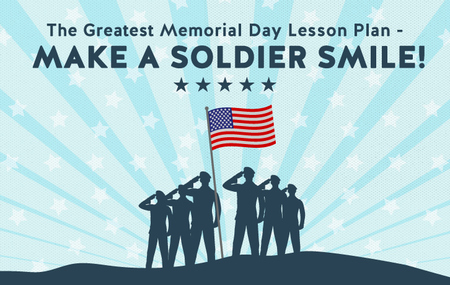
The Greatest Memorial Day Lesson Plan – Make a Soldier Smile!
School teacher to use powtoon as the go-to presentation format.

14 Ways to Win in College with Powtoon [Bonus: Student Webinar]
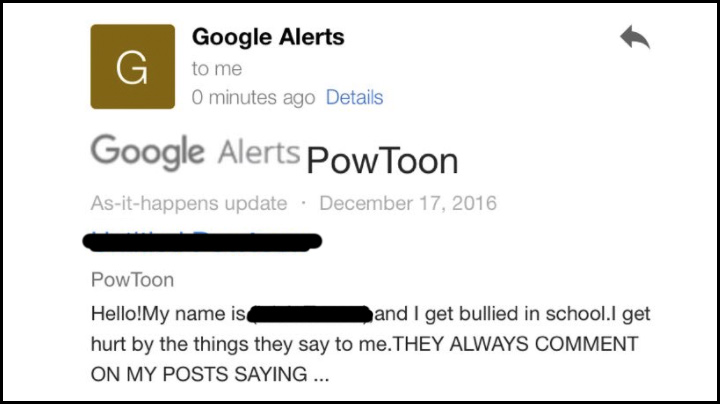
The Saddest Google Alert I’ve Ever Gotten…
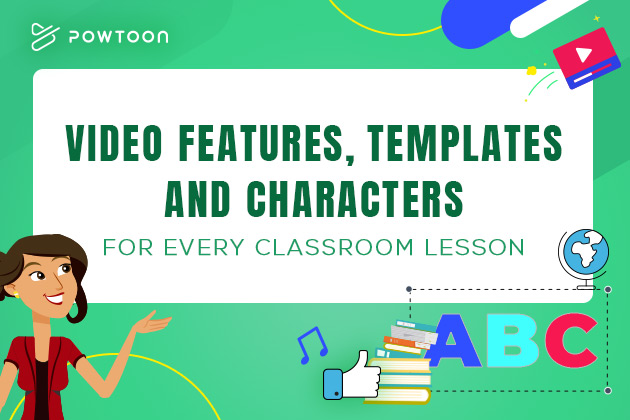
20 Best EDU Video Features, Templates, & Characters for Every Classroom Lesson

Thank you for your interest in Powtoon Enterprise!
A solution expert will be in touch with you soon via phone or email.
Request a demo
By submitting, you agree to our Terms of Use and Privacy Policy.
- Bipolar Disorder
- Therapy Center
- When To See a Therapist
- Types of Therapy
- Best Online Therapy
- Best Couples Therapy
- Managing Stress
- Sleep and Dreaming
- Understanding Emotions
- Self-Improvement
- Healthy Relationships
- Student Resources
- Personality Types
- Sweepstakes
- Guided Meditations
- Verywell Mind Insights
- 2024 Verywell Mind 25
- Mental Health in the Classroom
- Editorial Process
- Meet Our Review Board
- Crisis Support
16 Public Speaking Tips for Students
Public speaking tips for students aim to reduce anxiety that can interfere with giving presentations or speeches in class. These tips can also be helpful for those with social anxiety disorder (SAD) who have difficulty speaking in front of a group or telling a story among friends.
Public Speaking Tips
If you have SAD and need to give a speech in elementary school, high school, college, or university, it helps to be as prepared as possible . Beyond preparation, however, there are strategies that you can use to reduce anxiety and fight the urge to stay home with a fake illness.
Even great speakers practice their speeches beforehand. Practice out loud with a recording device or video camera and then watch yourself to see how you can improve. If you are feeling brave, practice in front of a friend or family member and ask for feedback.
- Talk about what you know : If possible, choose a topic for your speech or presentation that you know a lot about and love. Your passion for the topic will be felt by the audience, and you will feel less anxious knowing that you have a lot of experience to draw from when other students ask you questions.
- Concentrate on your message : When you focus on the task at hand, anxiety is less likely to get out of control. Concentrate on the main message of your speech or presentation and make it your goal to deliver that message to the other students in your class.
- Grab the audience's attention : Most of your fellow classmates will pay attention for at least the first 20 seconds; grab their attention during those early moments. Start with an interesting fact or a story that relates to your topic.
- Have one main message : Focus on one central theme and your classmates will learn more. Tie different parts of your talk to the main theme to support your overall message. Trying to cover too much ground can leave other students feeling overwhelmed.
Tell Stories
Stories catch the attention of other students and deliver a message in a more meaningful way than facts and figures. Whenever possible, use a story to illustrate a point in your talk.
Being prepared to speak in public can also be important if you have social anxiety disorder. Feeling confident and prepared to give your speech may help lessen your feelings of anxiety. Some of the things that you can do to prepare include:
- Visit the room : If you have access to the classroom where you will be speaking outside of class hours, take the time to visit in advance and get used to standing at the front of the room. Make arrangements for any audio-visual equipment and practice standing in the exact spot where you will deliver your speech.
- Rack up experience : Volunteer to speak in front of your class as often as possible. Be the first one to raise your hand when a question is asked. Your confidence will grow with every public speaking experience.
- Observe other speakers : Take the time to watch other speakers who are good at what they do. Practice imitating their style and confidence.
- Organize your talk : Every speech should have an introduction, a body, and a conclusion. Structure your talk so that the other students know what to expect.
Manage Your Anxiety
Taking steps to deal with your feelings of anxiety can also make public speaking easier. Some of the things that you can do:
- Tell someone about your anxiety : If you are speaking in front of a high school or college class, meet with your teacher or professor and describe your public speaking fears . If you're in elementary or high school, share your fears with your parents, a teacher, or a guidance counselor. Sometimes sharing how you feel can make it easier to overcome stage fright.
- Visualize confidence : Visualize yourself confidently delivering your speech. Imagine feeling free of anxiety and engaging the students in your class. Although this may seem like a stretch for you now, visualization is a powerful tool for changing the way that you feel. Elite athletes use this strategy to improve performance in competitions.
- Find a friendly face : If you are feeling anxious, find one of your friends in class (or someone who seems friendly) and imagine that you are speaking only to that person.
Press Play for Advice on Finding Courage
Hosted by therapist Amy Morin, LCSW, this episode of The Verywell Mind Podcast shares a strategy to help you find courage when you need it the most.
Follow Now : Apple Podcasts / Spotify / Google Podcasts
Maintain Perspective
Remember that other students are on your side. Think about a time when you have been an audience member and the student delivering the speech or presentation was noticeably nervous. Did you think less of that student? More likely, you felt sympathetic and wanted to make that person more comfortable by smiling or nodding.
Remember—other students generally want you to succeed and feel comfortable. If for some reason the audience is not on your side or you experience bullying or social exclusion, be sure to discuss this with a parent, teacher, or guidance counselor.
Be Confident
Sometimes just knowing what makes a good speech can help you feel more confident. Focus on some of the following elements and practice them before you have to speak in public.
- Develop your own style : In addition to imitating good speakers, work on developing your own personal style as a public speaker. Integrate your own personality into your speaking style and you will feel more comfortable in front of the class. Telling personal stories that tie into your theme are a great way to let other students get to know you better.
- Avoid filler words : Words such as "basically", "well", and "um" don't add anything to your speech. Practice being silent when you feel the urge to use one of these words.
- Vary your tone, volume, and speed : Interesting speakers vary the pitch (high versus low), volume (loud versus soft), and speed (fast versus slow) of their words. Doing so keeps your classmates interested and engaged in what you say.
- Make the audience laugh : Laughter is a great way to relax both you and the other students in your class, and telling jokes can be a great icebreaker at the beginning of a speech. Practice the timing and delivery of your jokes beforehand and ask a friend for feedback. Be sure that they are appropriate for your class before you begin.
- Smile : If all else fails, smile. Your fellow classmates will perceive you like a warm speaker and be more receptive to what you have to say.
Don't Apologize
If you make a mistake, don't offer apologies. Chances are that your classmates didn't notice anyway. Unless you need to correct a fact or figure, there is no point dwelling on errors that probably only you noticed.
If you make a mistake because your hands or shaking, or something similar, try to make light of the situation by saying something like, "I wasn't this nervous when I woke up this morning!" This can help to break the tension of the moment.
A Word From Verywell
It's natural to feel frightened the first time you have to speak in front of your class. However, if you fear continues, interferes with your daily life and keeps you awake at night, it may be helpful to see someone about your anxiety.
Try talking to a parent, teacher, or counselor about how you have been feeling. If that doesn't get you anywhere, ask to make an appointment with your doctor. Severe public speaking anxiety is a true disorder that can improve with treatment .
Spence SH, Rapee RM. The etiology of social anxiety disorder: An evidence-based model . Behav Res Ther. 2016;86:50-67. doi:10.1016/j.brat.2016.06.007
By Arlin Cuncic, MA Arlin Cuncic, MA, is the author of The Anxiety Workbook and founder of the website About Social Anxiety. She has a Master's degree in clinical psychology.

Creative Presentation Ideas for Middle School

How to Create a PowerPoint Presentation for College Class
Classroom presentations are among the most difficult tasks for middle school students, as they have to memorize information -- or at least the steps of the presentation -- and face a live audience of their classmates. The audience can quickly lose interest in an ordinary lecture, despite the fact that it is students -- not teachers -- presenting it. For this reason, students need to come up with compelling presentation ideas.
Funny Pictures
Instead of ordinary pictures, include caricatures or any other kind of funny images. Make sure they are relevant to the topic, instead of using them just for comic relief. You can find such pictures on Microsoft's Clip Art if you have Office applications. You can also download them from the Internet or even draw them yourself. Such pictures will make your classmates laugh, but will also focus them more on the presentation to learn why you included each specific picture.
Interactivity
Make the audience part of the presentation, by asking them questions and waiting for the answer that will allow you to move on. For example, when you are speaking about the United Kingdom and want to talk about the constituent countries, ask the audience if they know what those countries are. When a student mentions Scotland, start speaking about it. Separate note cards for each part of the lecture will come in handy in this type of presentation.
Instead of just speaking about cars, games consoles, clothes or anything tangible, bring them into the classroom. You can use them to show comprehensively how each object functions, or what it's made of. Your classmates can also get to hold the objects and familiarize themselves with them. When the presentation is not about objects you can have at home, such as a rocket or a spaceship, use your craft skills to create models of the objects yourself.
If your presentation is about a historical figure, make a mask of his face and speak to your classmates in the first person. Download a picture of the figure's face from the Internet, edit it to resemble your face size and then print it. Open holes for the eyes and mouth with a pair of scissors, and punch two holes on the side to tie an elastic piece of string. Your classmates will have fun fantasizing the famous person narrating his story to the class.
Related Articles

One-Minute Speech Topics

Grade 9 Speech Topics

Speech Techniques for High School

How to Talk in My First Class Seminar

Strategies for Effective Communication
How to structure a presentation, ideas for 4h posters.

Activities Teaching Kids Considerateness
Tasos Vossos has been a professional journalist since 2008. He has previously worked as a staff writer for "Eleftheros Tipos," a leading newspaper of Greece, and is currently a London-based sports reporter for Perform Sports Media in the United Kingdom. He holds a Bachelor of Arts in communication and media from the University of Athens.
👀 Turn any prompt into captivating visuals in seconds with our AI-powered design generator ✨ Try Piktochart AI!
75 Unique School Presentation Ideas and Topics Plus Templates
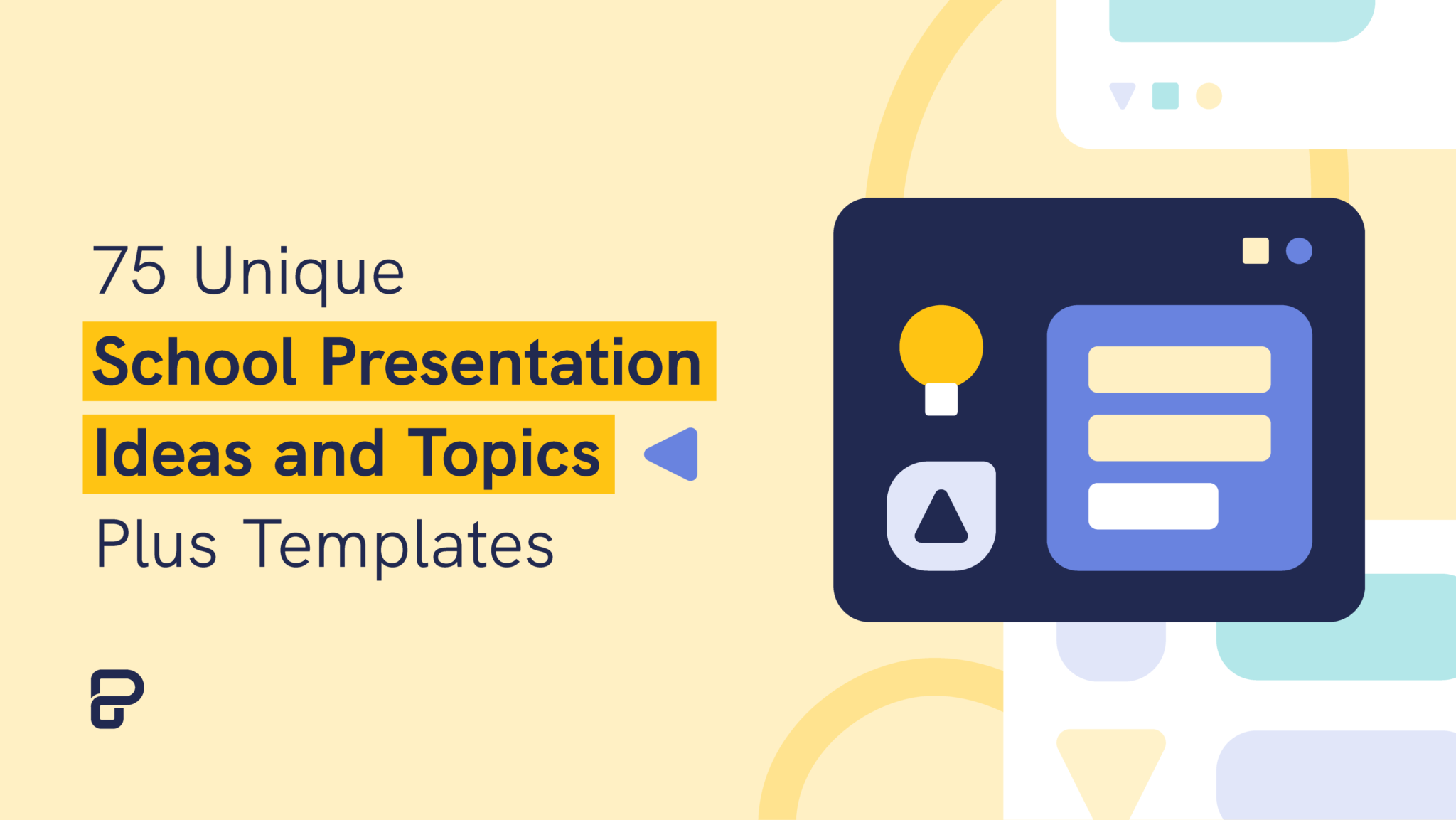
Are you tired of seeing the same PowerPoints repeating overused and unoriginal school presentation ideas covering repeated topics in your classes?
You know what I’m talking about; we’ve all been there, and sat through yawn-worthy demonstrations, slides, or presentation videos covering everything from the solar system, someone’s favorite pet, past presidents of a country, to why E=mC squared.

From grade school to university, first graders to college students, we are obligated to create, perform, and observe academic presentations across a plethora of curriculums and classes, and not all of these public speaking opportunities fall into the category of an ‘interesting topic’.
Yet, have no fear! Here at Piktochart, we are here to help you and your classmates. From giving examples of creative and even interactive presentation ideas, providing presentation videos , and suggesting interactive activities to give your five minutes of fame the ‘wow’ factor that it deserves, this article is your guide!
Our massive collection of unique school and college presentation ideas and templates applies if you’re:
- A teacher looking to make your class more engaging and fun with student presentations.
- A student who wants to impress your teacher and the rest of the class with a thought-provoking, interesting topic.
A Curated List of Interesting Topics for School Presentations
Did you know that when it comes to presentations , the more students involved improves retention? The more you know! Yet sometimes, you need a little help to get the wheels moving in your head for your next school presentation .
The great thing about these ideas and topics is you can present them either in face-to-face classes or virtual learning sessions.
Each school presentation idea or topic below also comes with a template that you can use. Create a free Piktochart account to try our presentation maker and get access to the high-quality version of the templates. You can also check out our Piktochart for Education plan .
Want to watch this blog post in video format? The video below is for you!
The templates are further divided into the following categories covering the most popular and best presentation topics. Click the links below to skip to a specific section.
- Unique science presentation topics to cultivate curiosity in class
- Engaging culture and history presentation ideas to draw inspiration from
- Health class presentation topics to help students make healthy lifestyle decisions
- Data visualization ideas to help students present an overwhelming amount of data and information into clear, engaging visuals
- First day of school activity ideas to foster classroom camaraderie
- Communication and media topics to teach students the importance of effective communication
- Topics to help students prepare for life after school
We hope this list will inspire you and help you nail your next school presentation activity.
Unique Science Presentation Topics to Cultivate Curiosity in Class
Science is a broad field and it’s easy to feel overwhelmed with too many topics to choose for your next presentation.
Cultivate curiosity in the science classroom with the following unique and creative presentation ideas and topics:
1. Can life survive in space?

2. Do plants scream when they’re in pain?

3. What are the traits of successful inventors?

4. How vaccines work

5. Massive destruction of the Koala’s habitat in Australia

6. Left brain versus right brain

7. What are great sources of calcium?

8. Recycling facts you need to know

9. Do you have what it takes to be a NASA astronaut?

10. The rise of robots and AI: Should we be afraid of them?

11. How far down does the sea go?

12. The stages of sleep

13. Will Mars be our home in 2028?

14. A quick look at laboratory safety rules

15. The first person in history to break the sound barrier

Engaging Culture and History Presentation Ideas to Draw Inspiration From
History is filled with equally inspiring and terrifying stories, and there are lessons that students can learn from the events of the past. Meanwhile, interactive presentations about culture help students learn and embrace diversity.
16. Women in history: A conversation through time

17. The sweet story of chocolate

18. A history lesson with a twist

19. The history of basketball

20. The origin of the Halloween celebration

21. AI History

22. What you need to know about New Zealand

23. 1883 volcanic eruption of Krakatoa

24. Roman structures: 2000 years of strength

25. The most famous art heists in history

26. Elmo: The story behind a child icon

27. 10 things you should know before you visit South Korea

28. 8 things you didn’t know about these 8 countries

Health Class Presentation Topics to Help Students Make Healthy Lifestyle Decisions
Want to learn how to engage students with healthcare topic ideas? Then consider using these templates for your next interactive presentation.
According to the CDC , school-based health education contributes to the development of functional health knowledge among students. It also helps them adapt and maintain health-promoting behaviors throughout their lives.
Not only will your presentation help with keeping students engaged, but you’ll also increase class involvement with the right slides.
The following examples of health and wellness interactive presentations include fun ideas and topics that are a good start.
29. How to look after your mental health?

30. The eradication of Polio

31. How to have a healthy lifestyle

32. 10 handwashing facts

33. Myths and facts about depression

34. Hacks for making fresh food last longer

35. Ways to avoid spreading the coronavirus

36. Mask protection in 5 simple steps

37. Everything you need to know about the flu

38. All about stress: Prevention, tips, and how to cope

39. The importance of sleep

40. Is milk tea bad for you?

41. How to boost happiness in 10 minutes

42. How dirty are debit and credit cards

43. Why do you need sunscreen protection

Data Visualization Ideas to Help Students Present Overwhelming Amounts of Data in Creative Ways
Data visualization is all about using visuals to make sense of data. Students need to pull the main points from their extensive research, and present them by story telling while being mindful of their classmates’ collective attention span.
As far as student assignments go, storytelling with data is a daunting task for students and teachers alike. To keep your audience interested, consider using a non linear presentation that presents key concepts in creative ways.
Inspire your class to be master data storytellers with the following data visualization ideas:
44. Are we slowly losing the Borneo rainforest?

45. Skateboard deck design over the years

46. Food waste during the Super Bowl

47. The weight of the tallest building in the world

48. Infographic about data and statistics

49. Stats about cyberbullying

50. How whales combat climate change

First Day of School Interactive Activity Ideas to Foster Whole-class-Camaraderie
Calling all teachers! Welcome your new students and start the school year with the following back-to-school creative presentation ideas and relevant templates for first-day-of-school activities.
These interactive presentations grab the attention of your students and are remarkably easy to execute (which is the main educator’s goal after all)!
51. Meet the teacher

52. Example: all about me

53. Self-introduction

54. Tips on how to focus on schoolwork

55. Course plan and schedule

Give our class schedule maker a try to access more templates for free. You can also access our presentation-maker , poster-maker , timeline-maker , and more by simply signing up .
56. Interpreting a student’s report card (for parents)

57. Introduction of classroom rules

58. Assignment schedule

59. Daily planner

60. Course syllabus presentation

61. How to write a class presentation

Topics to Teach Students the Importance of Effective Communication
Visual media helps students retain more of the concepts taught in the classroom. The following media topics and infographic templates can help you showcase complex concepts in a short amount of time.
In addition, interactive presentation activities using these templates also encourage the development of a holistic learning process in the classroom because they help focus on the three domains of learning: cognitive, affective, and psychomotor.
62. Interactive presentation do’s and don’ts

63. How to create an infographic

Recommended reading : How to Make an Infographic in 30 Minutes
64. How to improve your internet security and privacy

65. What is design thinking?

66. What are your favorite software tools to use in the classroom?

Presentation Topic Ideas to Help Students Prepare for Life After School
One of the things that makes teaching a rewarding career is seeing your students take the learning and knowledge you’ve instilled in them, and become successful, productive adults.
From pitching a business idea to starting your podcast, the following topics are good starting points to prepare students for the challenges after graduation (aka adulting 101):
67. How to make a resume

68. How to start a startup

69. Credit card vs. debit card

70. Pros and cons of cryptocurrency

71. How to save on travel

72. How to do a SWOT analysis

73. How to pitch a business idea

74. Habits of successful people

75. Starting your own podcast: A checklist

Find out how a high school teacher like Jamie Barkin uses Piktochart to improve learning in the classroom for her students.
Pro tip: make your presentation as interactive as possible. Students have an attention span of two to three minutes per year of age. To keep minds from wandering off, include some interactive games or activities in the lesson. For example, if you conducted a lesson on the respiratory system, you could ask them to practice breathing techniques.
Maintain eye contact with your students, and you’ll get instant feedback on how interested they are in the interactive presentation.
Make School Presentation Visuals Without the Hassle of Making Them From Scratch
School presentations, when done right, can help teachers engage their classes and improve students’ education effectively by presenting information using the right presentation topic.
If you’re pressed for time and resources to make your school presentation visuals , choose a template from Piktochart’s template gallery . Aside from the easy customization options, you can also print and download these templates to your preferred format.
Piktochart also professional templates to create infographics , posters , brochures , reports , and more.
Creating school-focused, engaging, and interactive presentations can be tedious at first, but with a little bit of research and Piktochart’s handy templates, you’re going to do a great job!

Other Posts

12 Graphic Organizer Examples for Teachers and Students

From Chaos to Clarity: Streamlining Your Student Life with a Schedule Builder

Resume with No Experience

Oral Presentation Checklist for Middle School
Terry mulligan.

Giving an oral presentation in middle school can be a little scary for many students. However, if you work with the checklist below, you will be well prepared to do a terrific job. Tips on preparation, presentation aids, appearance, body language and verbal skills will give you everything you need for your big day.
Explore this article
- Preparation
- Presentation Aids
- Appearance and Body Language
- Verbal Presentation
1 Preparation

The best way to give a great presentation is to make sure you know your material. Read about your subject and make notes for yourself. Then lay out your notes in an orderly manner for your presentation. An outline is the easiest format to use.
Read the notes to yourself out loud. Make changes on your outline until you have all the facts you want to present.
Make sure you know how long your presentation is supposed to be. Stand in front of a mirror to practice and time yourself. Then ask a friend or relative to listen to you for more practice.
2 Presentation Aids

When you use simple tools and visual aids, it becomes easier to give your oral presentation.
Write note cards for yourself from your research outline. It is important that you do not read from a piece of paper word for word. Break your presentation up into small pieces on your note cards as reminders of what you want to say.
Use visual aids whenever you can. If you have a product or example of your subject, bring it with you to show your audience. Prepare a Microsoft PowerPoint presentation, if allowed by your instructor.
3 Appearance and Body Language

The best way to get ready for your presentation is to make sure you show up on time and you have a clean and neat appearance. Stand straight with good posture and make eye contact with your audience to let them know you are interested in them so that they will be interested in you.
Instead of standing still in one place, move your position in the room. You can also use hand gestures and facial expressions to engage your audience.
4 Verbal Presentation

When you finalize your notes, make sure your verbal presentation has a solid opening that gets the audience's attention. Also make sure you have a closing that convinces them that you have provided valuable information.
Present facts, history and pros and cons about your subject in a conversational tone, speaking clearly with correct pronunciation. This will insure that your message will be well-received and you will have a successful oral presentation.
- 1 Microsoft Office: Create Your First Presentation
- 2 Write-Out-Loud: Diction Exercises to Make Sure They Get Your Message
About the Author
Terry Mulligan has been writing since 2007. As an accomplished artist, decorator and business professional, she enjoys covering art, decor, business management, real estate, education, computers/software/ERP, animal rescue, cooking and self-improvement. Mulligan holds an M.B.A. from the University of Phoenix.
Related Articles

How to Make a Poster Board Presentation More Interesting

English Presentation Topics

How to Deliver a Beautiful Eulogy for a Loved One

How to Give Good Speech Presentations in College

How to Do a Good English Oral Presentation

How to Write Thank You & Sympathy Cards for Donations

Postures During an Oral Presentation

How to Do a Book Report Without Reading the Book

How to Use Vocabulary Words in a Sentence

How Much Do You Tip a Limousine Driver?

How to Make an Outline for an Informative Essay

How Is Ricoh Pronounced?

How to Start an Oral Presentation

How to Overcome Fear In Teaching

How to Make an Informative Speech Longer

Three Components of a Good Paragraph

How to Format Speech Note Cards

How to Stop Outlook From Typing Over My Text

How to Write a Summary With Bullet Points
Regardless of how old we are, we never stop learning. Classroom is the educational resource for people of all ages. Whether you’re studying times tables or applying to college, Classroom has the answers.
- Accessibility
- Terms of Use
- Privacy Policy
- Copyright Policy
- Manage Preferences
© 2020 Leaf Group Ltd. / Leaf Group Media, All Rights Reserved. Based on the Word Net lexical database for the English Language. See disclaimer .
- Grades 6-12
- School Leaders
Free Attendance Questions Slideshow ✨
Ultimate Study Skills Guide: Tips, Tricks, and Strategies for Every Grade
Because they really do need to learn how to learn.
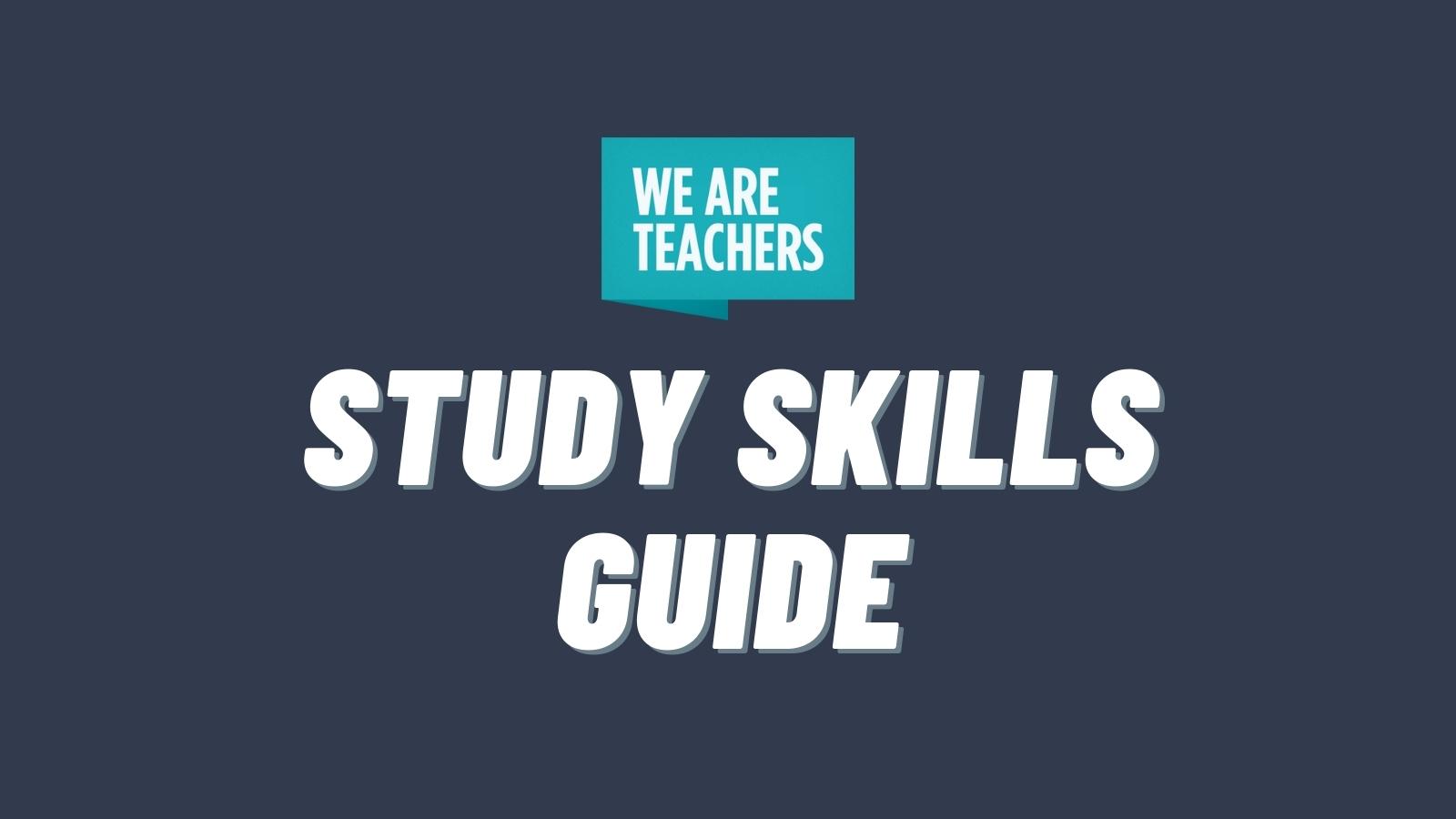
It’s not an exaggeration to say that study skills are life skills. Taking good notes, creating a focused workspace, managing distractions, making plans—any and all of these are skills people of all ages use every single day. Taking time to teach good study skills up front can equip students to succeed in school and beyond.
We’ve broken down many of the top study skills students need, including examples by grade level. Remember that there are a lot of different ways to study successfully. Offer students options and help them find the strategies that work best for them.
Study Spaces
Organization and time management study skills, learning styles, taking and using notes, effective reading study skills, completing assignments, test taking, finding help.

Choosing the right place to study is the first step to good study skills. Teach students to consider these elements.
Choose Your Space
For some students, this means a dedicated study space like a desk in their room. Others may prefer to curl up in a chair with a lap desk or work at a table in a common space. Whichever they choose, it should be an area that’s dedicated to study while they’re using it.
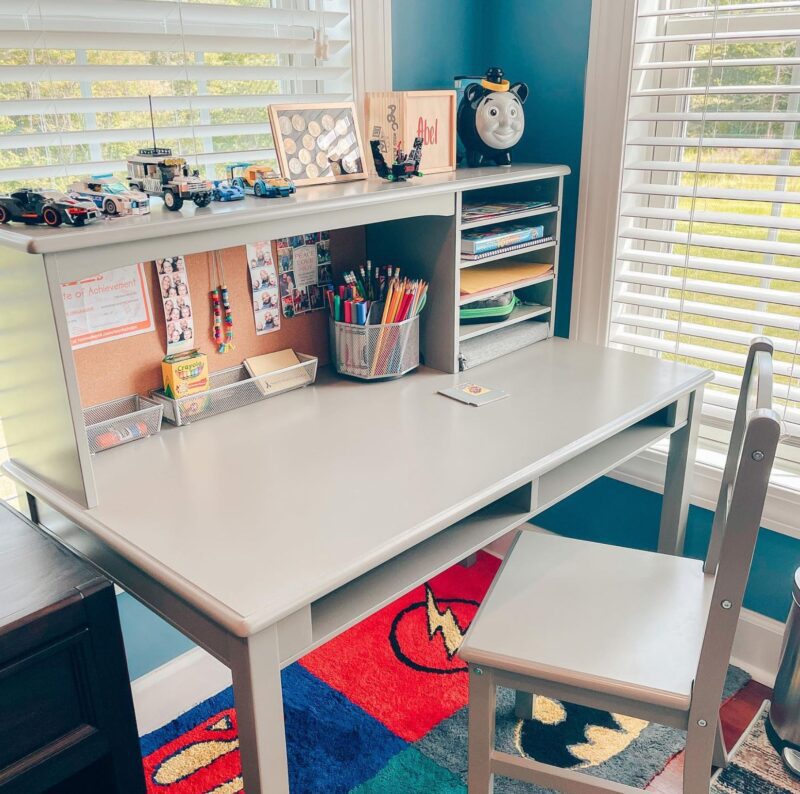
Source: organizeandarrangeit/Instagram
- Elementary School: Many students begin doing homework on the dining room or kitchen table, where parents can supervise. As students get older, encourage them to explore other spaces too, especially those where they can work independently.
- Middle School: By this age, kids will probably need a dedicated study space of their own, where they can keep supplies and works-in-progress. If that’s not possible, create a bin or box where they can store stuff while they’re not using it, then pull it out when it’s time to study.
- High School: Older students should be able to carve out a study space pretty much anywhere, since that’s something they’ll need to be able to do in the working world too. As long as they’re able to concentrate and get their work done, don’t be too picky about where they choose to do it.
Make Yourself Comfortable
“Comfortable” looks different for every person, so don’t assume all kids need to be sitting at a desk to work well. At the same time, they shouldn’t be so comfortable that they’ll fall asleep!
- Elementary School: When kids are doing independent reading, let them choose any spot they like. For other work, make sure they have a sturdy writing surface, like a table or lap desk. Ensure they have enough light to see what they’re doing, and teach them good posture if they’re sitting in a chair so they don’t develop stiff muscles.
- Middle and High School: Show them how to adjust the font size on screens so they’re not squinting to read. Encourage them to use blue light filters if they’re spending a lot of time on computers.
Manage Distractions
Learning to concentrate while ignoring distractions is a key life skill, and one that we all need to develop. Some students will have no trouble tuning things out, while others are going to need a lot of help with this one.
- Elementary School: Kids at this age are very easily distracted, so their study space should be as calm as possible. If a quiet room isn’t available, they might need noise-canceling headphones or even a white-noise machine to help them concentrate. Muting the TV isn’t enough—be sure it’s off completely. Remind friends and siblings to leave kids alone while they’re working.
- Middle School: These kids are old enough to recognize distractions but might still have trouble handling them. Encourage them to turn off phones and electronics (although some students are fine listening to music while they work). Students at this age are old enough to politely ask friends or family not to interrupt them while they work.
- High School: By this time, students know that the world is full of distractions and you can’t quiet them all. But you can teach them to mute their phone and messaging notifications, close all unnecessary windows on their laptops, and be firm about letting others know they need to be left alone to study.
Gather Your Supplies
One way to eliminate distractions is to ensure you have everything you need in place before you start. This includes books, notes, office supplies, and more. All kids should have water and some healthy snacks on hand too.
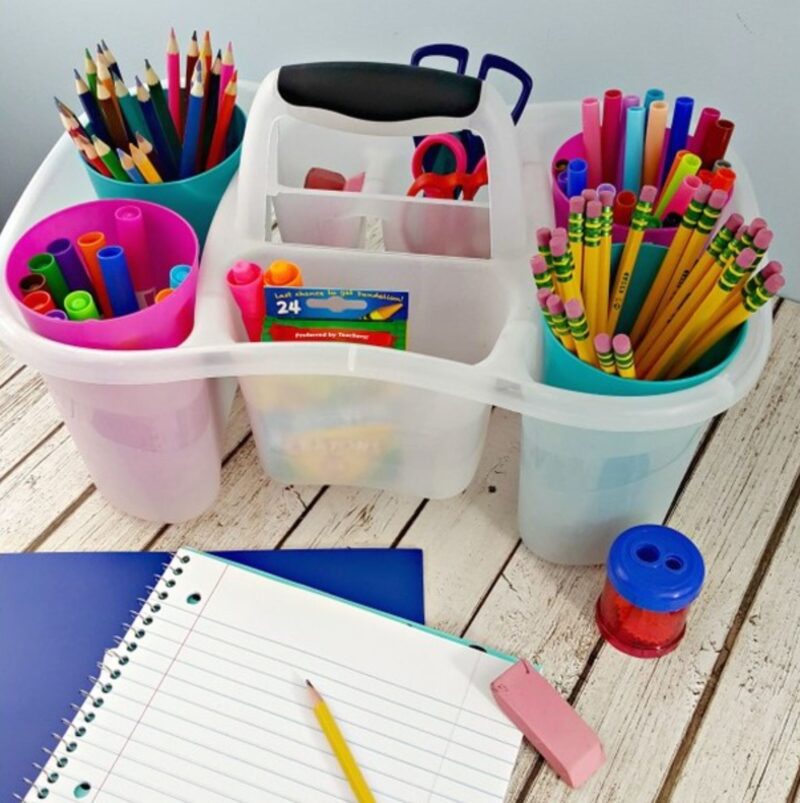
Source: jugglingactmama/Instagram
- Elementary School: Having a dedicated, well-stocked study space makes it much easier for kids to settle down to their work. Keep a supply of sharpened pencils, glue sticks, scissors, markers, and other items in a nearby drawer or a bin they can grab when they’re ready to get started.
- Middle School: Students this age likely keep just about everything they need in their backpacks, so they’ll want it nearby when they study. Remind them to restock their supplies once a week (including sharpening pencils in advance).
- High School: Depending on the assignment, these students may not need a lot of physical supplies, but they should still gather any books, notes, laptops, pens and highlighters, etc., they need before they settle in for a study session.

These two study skills are also vital life skills, so the sooner kids learn them, the better. They’ll be grateful later in life!
Use a Homework Planner
As soon as kids starting having any kind of homework, they need a planner. For younger students, this could be a daily take-home folder, while older kids will need a more sophisticated system. Either way, use it consistently so it becomes a habit.
- Elementary School: Take-home folders are perfect for organizing worksheets and other assignments. Put unfinished work on the left and finished work on the right. Use sticky notes on the worksheets or the front of the folder to write reminders about what needs to be done, including any due dates. Parents of younger students can review these folders each day, while upper elementary kids should mostly be able to keep track of things on their own.
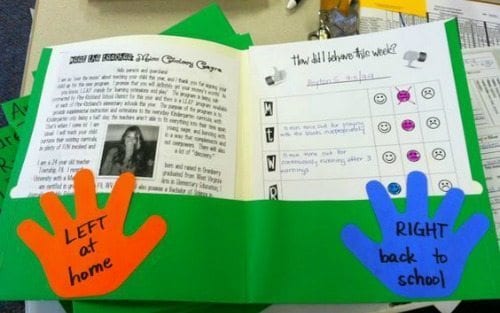
Source: Busy Classroom
- Middle School: Use a planner notebook that includes calendars to help keep track of long-term assignments, with pages for daily notes and to-do lists. Teach students to make notes in them during class or immediately after, and start every study session by reviewing any current assignments and their due dates.
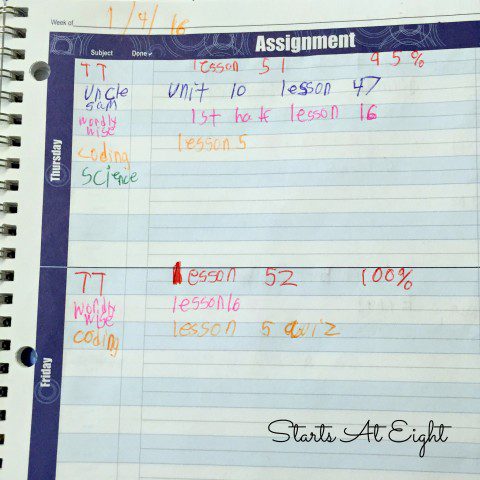
Source: Starts at Eight
- High School: Kids can continue using paper planners, or transition to online calendars or apps. Show them how to set useful reminders online, so things don’t slip through the cracks.
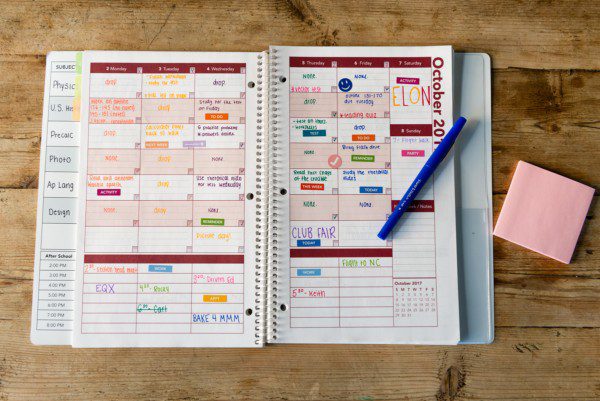
Source: LP Tutoring
Create a Daily Study Plan
When kids sit down to tackle the day’s work, encourage them to begin by making a plan. Assess what needs to be done, estimate the amount of time it will take, and decide what to do first.
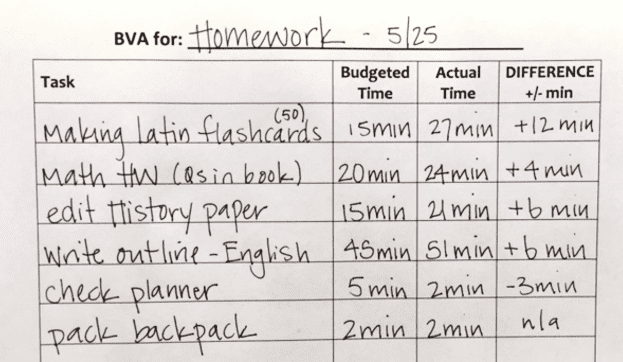
Source: Beyond Booksmart
- Elementary School: Parents and young kids should sit down together to look over the day’s assignments and talk about what to work on first. Some students might like to get easy tasks out of the way before settling in to harder ones, while others prefer to handle more difficult things first. Help them find the method that works best for them.
- Middle School and High School: This age brings a higher amount of homework, so students should always start by determining how much time they’ll need to complete it. Let them experiment a bit—do they work best by completely finishing one assignment before moving on to the next, or do they like to do a little bit of each and take some breaks in between? Over time, they’ll find the methods they like best.
Chose the Best Study Time
Kids’ days are often jam-packed with activities, leaving homework and studying to get squeezed in whenever it fits. Take time to find out what time of day kids are at their best, and prioritize that time for study. For instance, if a student seems to learn better if they do their homework right after school, try to choose extracurriculars that meet in the evenings or weekends instead. Some students might even prefer to get up early in the morning and work, and that’s OK too as long as they’re getting enough sleep.
- Elementary School: Let kids try doing their homework at different times throughout the day, and see if there are times when they’re better at concentrating. If so, teach them to schedule their schoolwork during those times, and make extracurricular choices for them accordingly.
- Middle and High School: Students probably know by now when they work best, but busy schedules can make that more difficult to accommodate. Remind them to try to make smart choices and to tackle schoolwork when they’re feeling as fresh and alert as possible.
Keep Materials Neat and Organized
Some adults thrive in messy work spaces, and that’s OK. But kids should make an effort to keep their spaces and materials organized so they have fewer excuses for not getting things done.
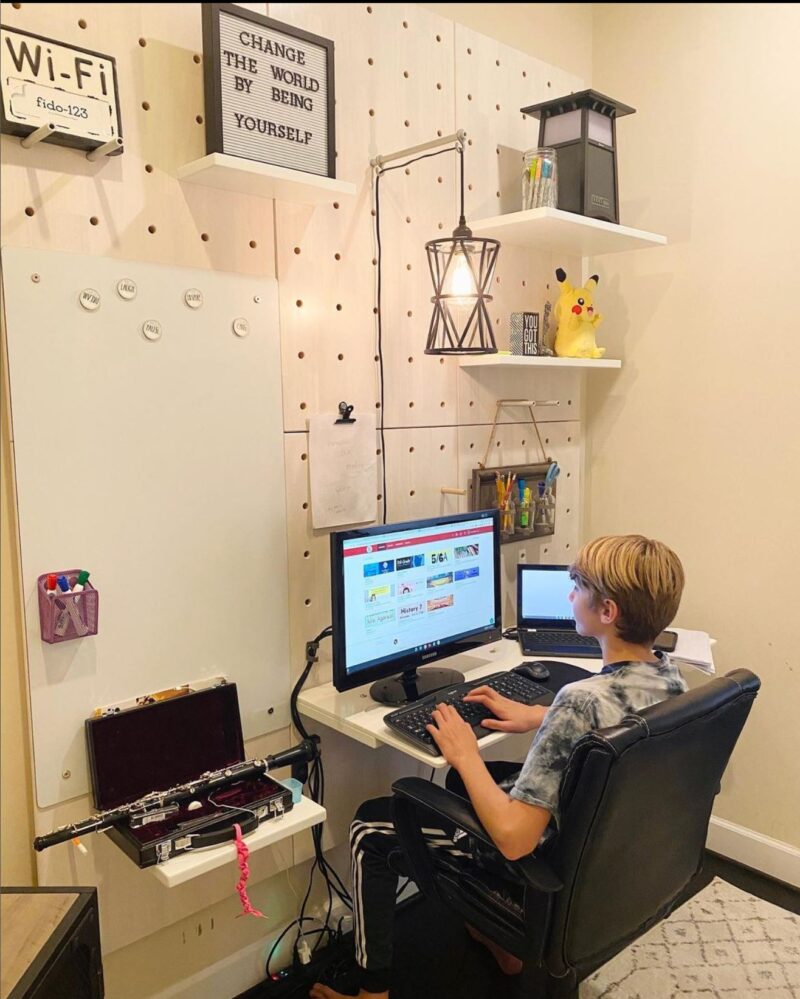
Source: mywallpro/Instagram
- Elementary School: In early grades, parents should help kids go through their backpack each night, cleaning out trash and restocking supplies. Help them set up an organization system using the different pockets. Show them how to use different-color folders and notebooks for each subject, and clean out every folder regularly. Set the backpack by the front door each night so it’s ready to go in the morning. Upper grade students should gradually do some or all of these things on their own.
- Middle School: Transition to entirely managing backpacks and study spaces on their own. Parents might check in once a week or at the beginning of a school quarter to see if students need some assistance getting organized.
- High School: In addition to managing their physical study materials, ensure kids at this age know how to keep things organized online. Show them how to use files and folders, where to back things up, and how to manage their email and message inboxes. Encourage them to set aside a regular time to make sure everything is in order, and make improvements as needed.
Take Breaks
Students need both physical and mental brain breaks while they study! Remind kids to get up and move around regularly, rest their eyes, and give their brain a break for a few minutes every so often.
- Elementary School: Younger students should be able to work for about 15-20 minutes before taking a break, with upper grades going as long as 30 minutes. They usually won’t need reminders to take breaks, but they might need some help keeping those breaks to no more than 10 minutes or so.
- Middle School: These kids can work 30-45 minutes at a time and should learn to recognize the signs of needing a break on their own. When they start to get very fidgety, feel a headache coming on, squint while they’re reading, or feel hungry or thirsty, it’s time for a short break. Teach them to set a timer to know when the break is over and they need to get back to work.
- High School: By now, students can work an hour at a time but should be encouraged to take regular breaks all the same. In fact, just like adults, they should aim to get up and move for at least 5 minutes every hour. Physical activity like stretching, yoga, or even dancing to music will help refresh them so they can get back down to it. If they have trouble remembering to take breaks, have them set a timer to remind them.

All students use different learning methods to retain and understand the same information. Some like written words, some prefer to hear it and talk about it. Others need to do something with their hands or see images and diagrams. These are known as learning styles. While it’s important not to pigeonhole students into any one style, kids should be aware of any strengths they have and use them to create strong study skills.
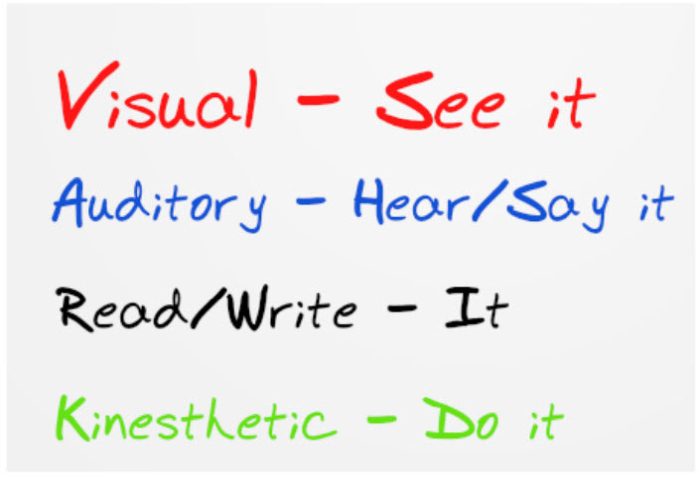
Source: Nnenna Walters
Know Your Style
There are four generally accepted styles: visual, auditory, read/write, and kinesthetic (movement). You can learn more about them here. It’s worth taking time to understand which (if any) style appeals to a student more.
- Elementary School: Most kids are exposed to a wide array of learning activities, strategies, and methods here and will slowly form preferences. If parents or teachers notice that kids aren’t learning well using one method (e.g., flash cards to learn math facts), have students try activities from different styles instead (like videos or songs).
- Middle School: At this age, students should have some idea of which study methods fit their learning styles. They should continue to experiment, especially in subjects where they struggle to master the material.
- High School: Kids in these grades who still don’t understand how they learn best may benefit from taking the VARK questionnaire . It will point them in the right direction and help them find the best study methods.
Choose Appropriate Study Materials
Here are some examples of study materials and activities that appeal to different learning styles, no matter the age or grade level.
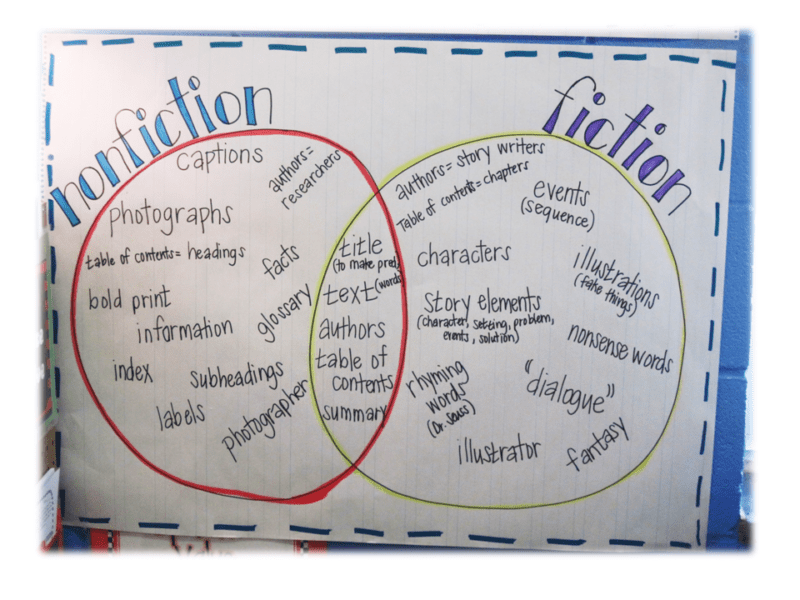
Source: Elementary Shenanigans
- Visual: Diagrams; charts; graphs; maps; videos with or without sound; photos and other images; graphic organizers and sketchnotes
- Auditory: Lectures; audiobooks; videos with sound; music and songs; text-to-speech translation; discussion and debate; teaching others
- Read/Write: Reading textbooks, articles, and handouts; watching video with subtitles turned on; using speech-to-text translation and transcripts; making lists; writing answers to questions
- Kinesthetic: Hands-on practice; educational craft projects; experiments and demonstrations; trial and error; moving and playing games while learning

Study after study have shown the importance of actively taking notes rather than passively reading a handout later on. The act of writing engages different parts of the brain, forging new pathways that help students retain information in long-term memory. Taking good notes and using them properly are study skills every student needs to master.
Learn Different Note-Taking Strategies
There are a variety of good strategies, like outlines, the Cornell Method, sketchnotes, and more. There’s no one best method; it often depends on the material and the learner.
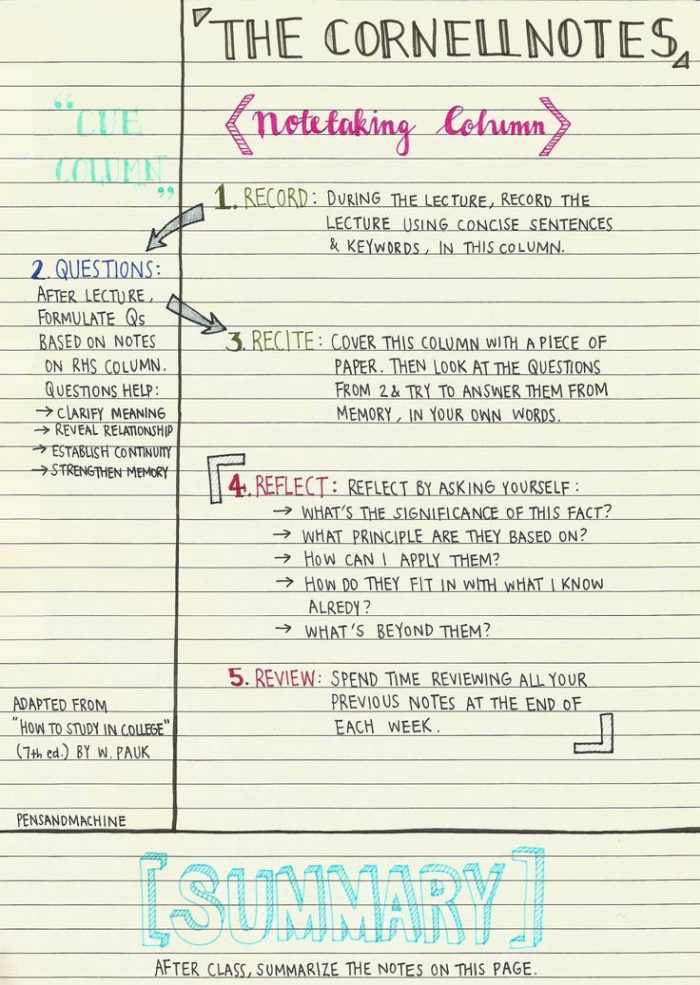
Source: Think Insights
- Elementary School: Actively teach kids how to take notes in a variety of styles. Learn about seven top note-taking strategies here , and share them with your students. Teachers can start with handouts and graphic organizers but should slowly transition to more independent methods.
- Middle School: Students should be mastering the skill of taking their own notes, choosing a style that works best for them. They may need reminders of key points to capture but should now be able to isolate the important info.
- High School: Note-taking should be automatic by now, and many students will have developed preferred styles. Teachers should not insist on a specific note-taking strategy, but should ensure kids are capturing the information they need.
Organize and Review
Taking notes is just one part of the process. Students with good study skills also know how to use them effectively.
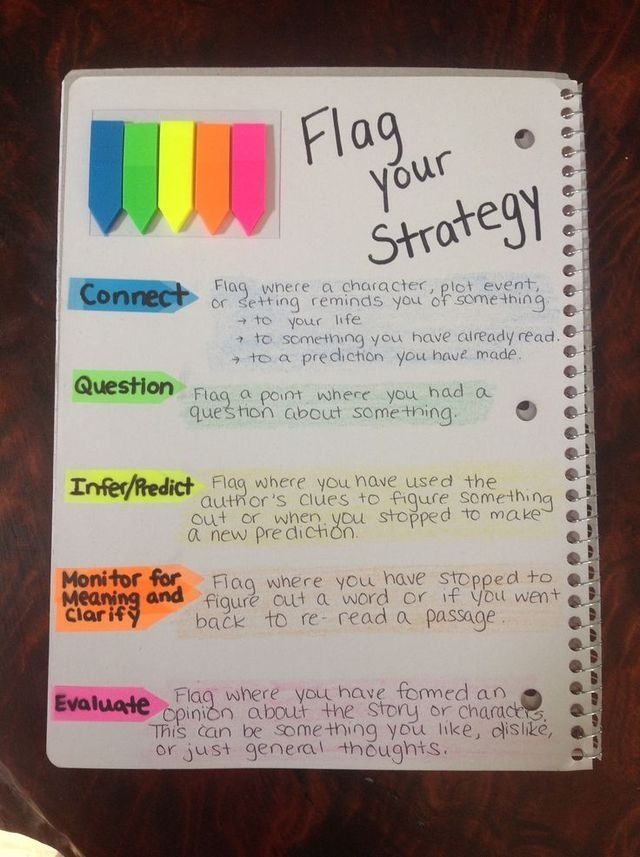
Source: The Mad Scientist
- Elementary School: Help students keep all notes from one subject or project in one notebook or folder. Show them how to place them in an order that makes sense, and use tabs, tables of contents, or other organizational methods. Encourage them to review each day’s notes when they go home at night, to reinforce the learning.
- Middle School: Students in these grades might want to reorganize their notes on their own when they get home, re-copying them or even typing them into a computer. They should be able to use effective organization strategies, to find the notes they need later on during a study session.
- High School: Students should plan to spend time after every class going over that day’s notes, reviewing and reinforcing what they learned. They should be able to rely heavily on their own notes when reviewing for a test or completing a project.

“Read chapter three for homework tonight.” Sounds simple enough, right? But there’s a big difference between skimming the material and actually learning from it. Here are the study skills students need to learn while they read.
Highlighting
Everybody loves a handful of colorful highlighters, but using them effectively is a study skill all on its own. Kids can highlight both texts and their own notes.
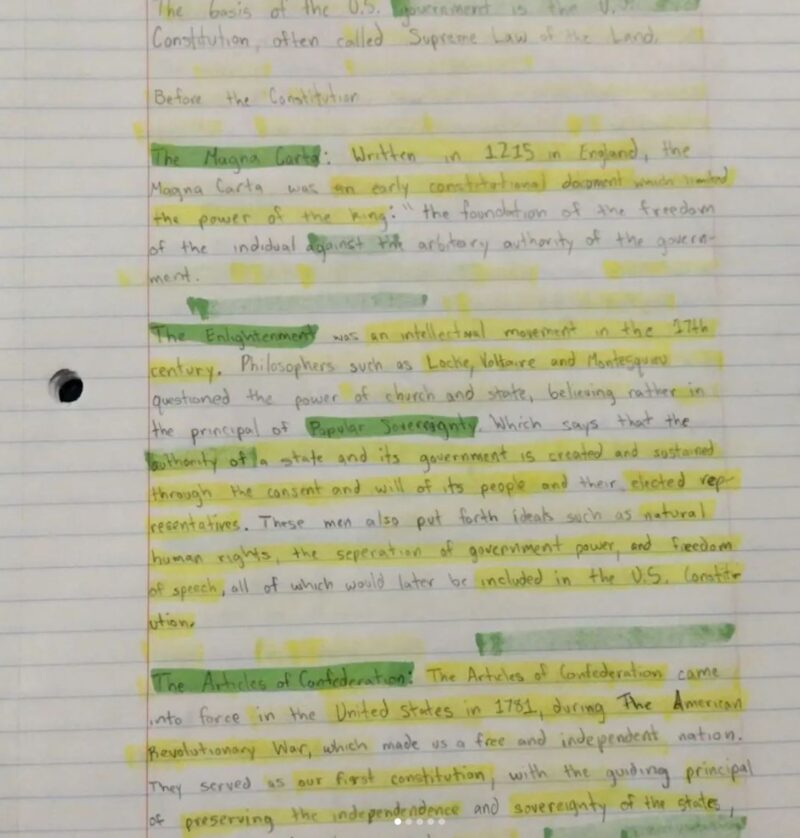
Source: cozmic_mae/Instagram
- Elementary School: Read material with students, showing them how to highlight key words and phrases instead of whole blocks of text. Show them color-coding strategies for organizing the information. Give them practice passages specifically for learning these skills.
- Middle School: Introduce students to online highlighting tools, since many of the texts they’ll be reading are digital. If necessary, they can print out reading material to highlight physically instead.
- High School: Kids should be pretty expert at highlighting by now, but watch for students who are still highlighting whole blocks without really knowing why, and show them the fundamentals.
Rereading and Taking Notes
In a lot of cases, reading something once simply isn’t enough. All students should learn to reread materials, using that time to highlight and take notes.
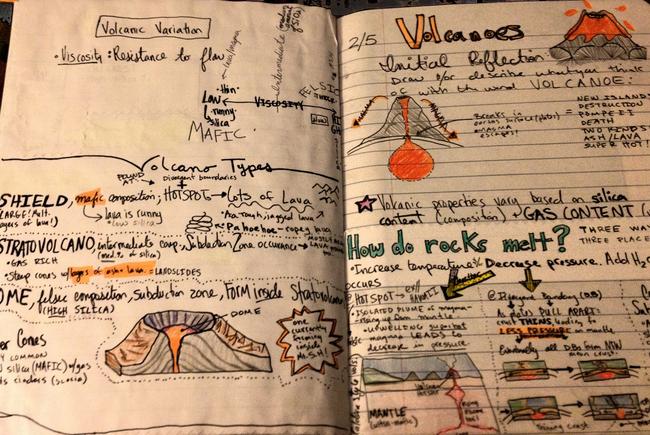
Source: SERC
- Elementary School: Reread passages together, pointing out key words, phrases, and ideas. Make notes while reading, both in the text and on separate paper. Try to complete review questions without referring to the text.
- Middle School: Students will know they’ve read thoroughly when they can complete review questions without looking back. Show students how to write their own review questions as they study (the Cornell Method of Note-Taking is perfect for this) so they’ll know they truly understand the material.
- High School: Continue to reinforce good reading study skills by giving students review questions to complete or asking them to make an outline or sketchnotes to sum up what they’ve learned.
Kids need to learn how to thoroughly complete an assignment, whether it’s a worksheet, an essay, or a term-long research project. These are the study skills they should know.
Understand the Assignment
Having a clear understanding of what’s being asked is so important. Otherwise, kids might wind up doing the wrong work, then having to tackle it all over again.
- Elementary School: Show kids how to carefully read directions at the beginning. Have them repeat back what they’re expected to do, and make notes if they need reminders. Teachers should provide instructions in writing whenever possible and make them clear and simple.
- Middle School: Encourage students to ask questions about assignments up front, or throughout if necessary. Continue to ensure they fully understand the directions before they start, especially when there are multiple steps.
- High School: By now, students should be able to make their own notes about expectations and can handle a series of more complicated steps. They should make a habit of reviewing all that information before they begin work.
Make a Plan
Once they know the expectations, students should plan how they’ll do the work.
- Elementary School: Help students evaluate the assignment and decide which parts they’ll do first. This is also a good time to estimate how long the work will take.
- Middle School: Encourage kids to think about how they like to approach assignments. Do they like doing easy problems first, then circling back around to harder stuff? Do they sometimes get stuck and frustrated? If so, how can they get “unstuck” and continue to make progress?
- High School: Many high school assignments are more complex, and students will need to lay out the steps to take. For instance, a research project might require choosing a topic, getting approval, starting research, planning a presentation, and giving the presentation, with multiple sub-steps in each. This all feels more manageable when you have a plan in place first.
Save Your Work
Such a basic study skill, and so extremely important!
- Elementary School: Help students ensure all assignments go back into the appropriate folders and all folders make it into their backpack when they’re done. Don’t leave things lying around where they can get lost.
- Middle and High School: In addition to keeping physical papers in order, be sure kids know how to save files online, including backing up their work. Many programs save automatically, but that’s not always the case. Show them how to keep backed-up files on an external drive or in the cloud, in case their hardware fails.
Review and Revise
Finishing the last problem on the page or typing the final word on a paper doesn’t mean you’re done. Good study skills means going back to review your work and make revisions.
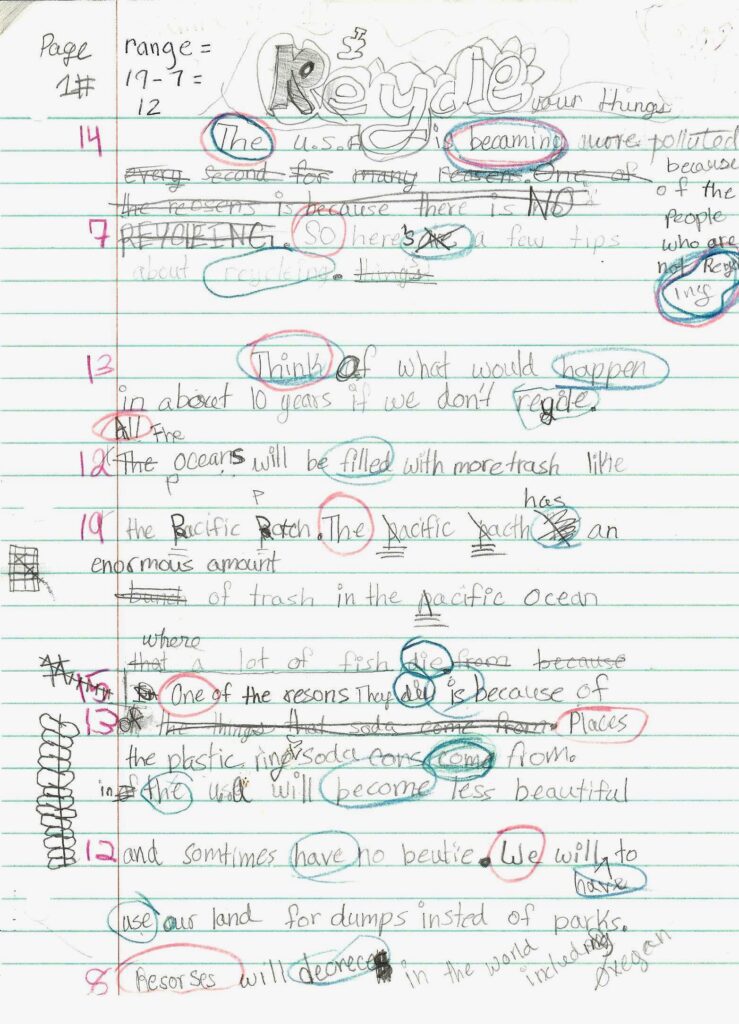
Source: EnglishWritingTeacher.com
- Elementary School: Parents and younger kids should go back over completed homework together to make sure it’s complete and correct. Perform math problems “backwards” to see if the answers make sense. As kids get older, parents should remind them to review and check their answers on their own.
- Middle School: Students should regularly remember to check their answers before turning in an assignment. Advise them to make sure they’ve done everything they’ve been asked to, to the best of their ability.
- High School: Reviewing and revising should be automatic now. Writing assignments should include plans for multiple revisions. Teach students to use spell-check and grammar-check programs as needed, and encourage them to read their writing out loud to hear how it sounds.

Some kids naturally do well on tests, but others freeze up and forget everything they’ve learned . Fortunately, test-taking study skills are something kids can learn over time.
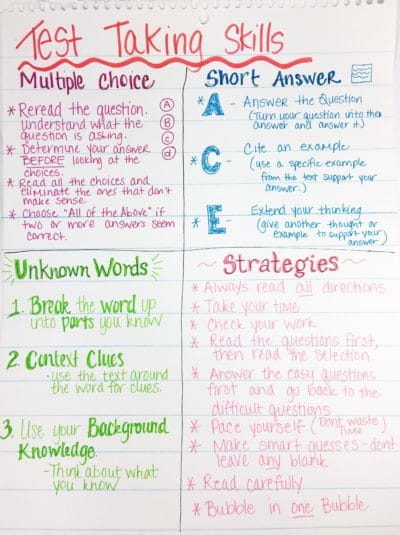
Source: Tammy DeShaw/The Owl Teacher
Review the Material
Kids should develop a variety of strategies for reviewing for a test, including review questions, flash cards, discussions, looking over notes, and more. It’s also important to follow a regular study schedule on any subject, instead of leaving all the review to the last minute.
- Elementary School: Whenever possible, adults should work with kids to help them study. Make flash cards, talk over the material together, sing spelling word songs—model good study skills for them to help them learn.
- Middle School: Help students continue to use a variety of review strategies. Teachers can provide review questions, set up study groups, and create online materials for them to use, just to name a few.
- High School: Kids should be coordinating their own review by now, whether independently or in groups. Make sure they know how to contact you if they have questions while they’re studying.
Get Rest and Eat Well
At any age, feeling your best is key to acing a test. Discourage students from staying up late to cram, and see that they have healthy meals and snacks on the day of the test. If they’re allowed, be sure they have bottled water on hand to stay hydrated before and during the test itself.
Tackle Easy Questions First
This one is especially important for students who have difficulty managing their time, or those who get incredibly nervous about tests. Focus on showing what you know, and build confidence as you go along.
- Elementary School: Teach kids to look over the entire test first so they can see what they’ll be expected to do. Tell them to ask questions right away if they have any. On the second run-through, they should answer any questions or problems they’re certain about. Finally, they can go back and handle more challenging questions, one at a time. In younger grades, practice this skill by using guided test-taking sessions.
- Middle School: Before a test, remind students of the process. Have them look the whole thing over first, and ask if anyone has any general questions before they begin. Monitor kids as they complete the test, and nudge along any who seem stuck on one particular question or section.
- High School: By now, kids should have the process down pat, but teachers should be aware of nervous test-takers and quietly remind them to focus on what they know.
Watch the Time
It’s a simple skill but a valuable one. Get kids used to glancing at the clock, but not obsessing over how much time is left.
- Elementary School: Tell kids how much time they have up front. Offer reminders several times, especially toward the end, but don’t do it in a way that amps up anxiety.
- Middle School: Make time expectations clear up front, and remind students once or twice of the remaining time as they work. Students should be glancing at the clock occasionally as they work; at the end of every page or section is a good rule of thumb. If they feel like they’re running out of time, remind them to use the “easy questions first” strategy.
- High School: Older students should be able to look over a test and compare it to the amount of time they have, so they know they’re working at the right pace. Teachers can offer a reminder halfway through and five minutes before the end.
Review Before Submitting
Just like with assignments, students should try to make time to review test answers before they turn it in. (And to make sure they put their names on their paper!)
- Elementary School: Actively ask students who are turning in their papers to go back to their seats and review their answers first. Build in a little extra test time so every student has a chance to review their work.
- Middle School: Remind students to review their work before submitting it when you pass out the tests. Offer additional reminders to those who regularly turn in work that needed another look.
- High School: Students should remember to build in time to look things over at the end as they start taking the test. The five-minute reminder toward the end is their cue to look over what they’ve done.

Even when you have terrific study skills, sometimes you need some assistance. Asking for help when you need it is something everyone needs to be able to do. While kids can’t expect adults to walk them through every step of the process, they should feel free to reach out for guidance when they need it.
Know How and When To Contact Teachers
Help students keep contact information handy and know the appropriate ways to contact their teachers as needed.
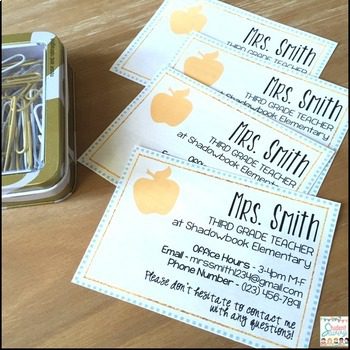
Source: StudentSavvy/Teachers Pay Teachers
- Elementary School: Most outside-school communication is between parents and teachers at this point, but kids should be encouraged to ask their own questions during the school day whenever possible. As they get older, parents should do their best to let kids take the lead.
- Middle School: Students should be almost entirely independent of parents when communicating with teachers now. They should know when teachers are available to chat in person (including before and after school, if possible). Adults can also show them how to write respectful emails or texts if teachers have made that contact information available.
- High School: At this point, students should be nearly 100% responsible for talking to their teachers when they need to. They should keep a contact list of email addresses, phone numbers, or other info. Additionally, they should recognize and respect preferred methods of contact.
Create Study Groups
While some kids work best on their own, many others thrive working with others to keep them on track and motivated. Setting up study buddies or groups enhances everyone’s study skills.
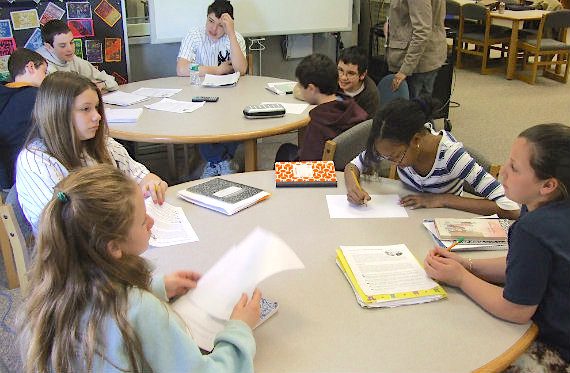
Source: MiddleWeb
- Elementary School: Parents will likely have to coordinate any in-person or online study sessions. Teachers can help by pairing students together as partners or for tutoring, and providing virtual study spaces when necessary.
- Middle School: As students get older, they should learn to seek out strong study partners. Help them recognize that their best friends may not always be the best choices when it comes to studying. Encourage them to have peers over to study, or to meet in public places like libraries.
- High School: Kids should be independently forming their own study support systems. However, they might ask teachers for help when they need one-on-one tutor recommendations. They may work together at school, at home, at the library, or online.
Use Resource Tools
There are more ways to learn and study than ever before. Help students find the right options to support their studies.
- Elementary School: Encourage students to look up answers in the right places: What does a word mean? Check the dictionary. When did the Civil War start? Here’s how to Google that. Help younger students use the resources to ensure they’re finding the information they need.
- Middle School: “Hey Google, how many moons does Jupiter have?” Kids this age know how to ask questions on the web. However, they need to learn how to make sure the answers are reliable. Teach them about primary sources (like following Wikipedia info back to its original source) and how to verify information in several different places.
- High School: A huge number of resources are online these days, so be sure students know where to find them and how to use them. Provide trusted online dictionaries and encyclopedias, show them how to seek out a thesaurus or rhyming dictionary, and guide them to video sites beyond YouTube, just to name a few.
How do you teach study skills in your classroom? Come share your ideas and ask for advice in the WeAreTeachers HELPLINE group on Facebook !
Plus, check out 15 life skills every teen should learn ..
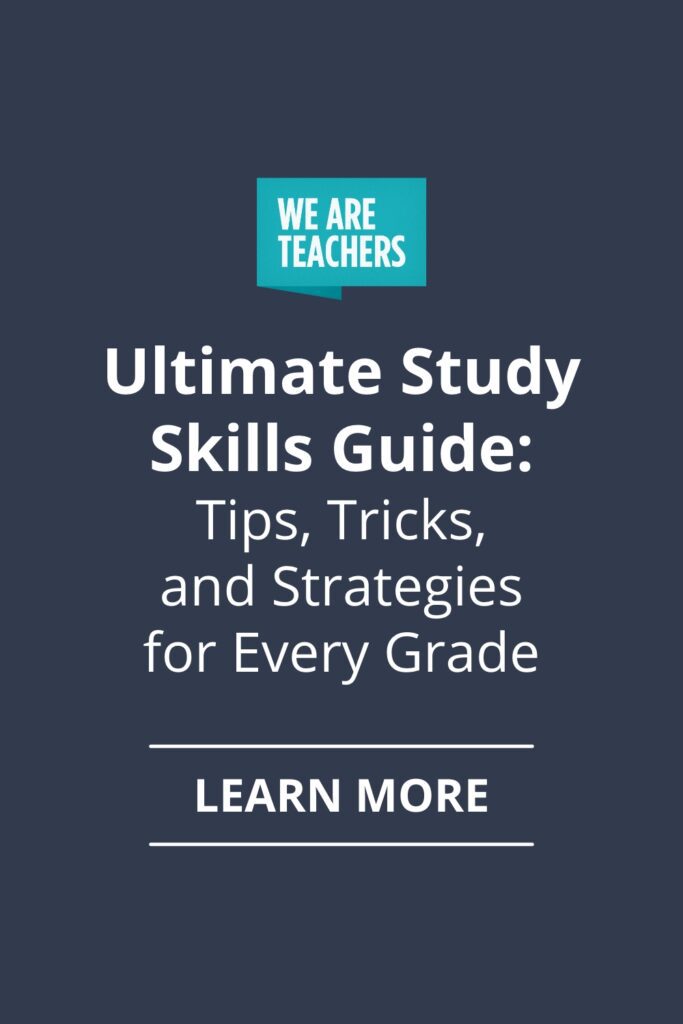
You Might Also Like
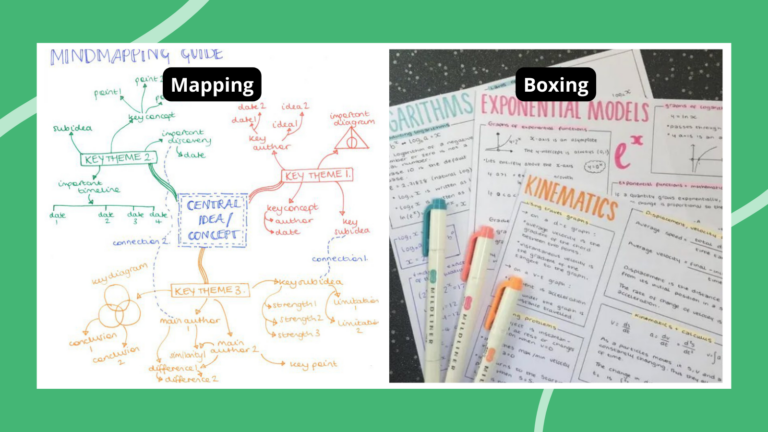
11 Helpful Note-Taking Strategies Your Students Should Know
It's a skill they can use later in life too. Continue Reading
Copyright © 2024. All rights reserved. 5335 Gate Parkway, Jacksonville, FL 32256
- Our Mission
How a Simple Presentation Framework Helps Students Learn
Explaining concepts to their peers helps students shore up their content knowledge and improve their communication skills.

A few years ago, my colleague and I were awarded a Hawai‘i Innovation Fund Grant. The joy of being awarded the grant was met with dread and despair when we were informed that we would have to deliver a 15-minute presentation on our grant write-up to a room full of educational leaders. If that wasn’t intimidating enough, my colleague informed me that he was not going to be in Hawai‘i at the time of the presentation. I had “one shot,” just a 15-minute presentation to encapsulate all of the 17 pages of the grant I had cowritten, but how?
I worked hard to construct and deliver a presentation that was concise yet explicit. I was clear on the big picture of what the grant was composed of and provided a visual of it in practice. I made sure the audience understood the “why” behind the grant. I showed how it worked, the concrete elements of it, and how they made it successful. I finished with a scaffold that would help others know how to initiate it within their context, giving them the freedom to make it authentically their own.
I received good feedback from the presentation, and more important, what was shared positively impacted student learning in other classrooms across the state.
A Simple Framework for Presentations
That first presentation took me over a month to prepare, but afterward I noticed that my prep time for presentations shrank exponentially from a few months to a few (uninterrupted) days. Interestingly enough, as a by-product of creating the original presentation, I created an abstract framework that I have used for every professional learning presentation I have delivered since then. The “What, Why, How, and How-To” framework goes as follows:
- What? What can the audience easily connect to and know as a bridge to the unknown for the rest of the experience?
- Why? Why should they care to listen to (and learn from) the rest of the presentation? What’s in it for them to shift from passive listeners to actively engaged? The audience needs to know why you believe in this so much that you are compelled to share it.
- How? What are the key elements that make it unique? How is it effective in doing what it does? What are the intricacies of how it works?
- How-to? How could they start doing this on their own? How could this knowledge serve as a foundational springboard? Connect it to “why.”
Benefits for Students
One of the best parts of presentations is that they help the presenter to improve their communication skills. The presenter is learning how to give a presentation by doing it. To prepare a presentation, the presenter must know the intricate elements of what they are presenting and the rationale for their importance. In the presentation delivery, the presenter must be articulate and meticulous to ensure that everyone in the audience is able (and willing) to process the information provided.
It didn’t take long for me to realize that preparing and delivering presentations could provide a valuable learning opportunity for my students.
I recall teaching mathematical concepts whereby students would immediately apply knowledge learned to accomplish the task in silence and without any deeper questioning. Only after I asked them to provide presentations on these concepts did they regularly ask me, “Why is this important, again?” or “What makes this so special?” My students’ mathematical literacy grew through preparing presentations with the “What, Why, How, and How-To” framework, which supported them in their ability to demonstrate content knowledge through mathematical rigor (balancing conceptual understanding, skills and procedural fluency, and real-world application).
- The “what” served as the mathematical concept.
- The “why” demonstrated the real-world application of the concept.
- “The “how” demonstrated conceptual understanding of the concept.
- The “how-to” demonstrated skills and procedures of the concept.
In addition to content knowledge, the sequential competencies of clarity, cohesiveness, and captivation ensured that the presenter could successfully share the information with their audience. When combined, these framed a rubric that supported students in optimizing their presentation deliveries. The competencies are as follows:
1. Content knowledge. The presenter must display a deep understanding of what they are delivering in order to share the “what, why, how, and how-to” of the topic.
2. Clarity. The presenter must be clear with precise, academic language. As the content they deliver may be new to the audience, any lack of clarity will alienate the audience. Providing multiple modes of representation greatly addresses a variety of processing needs of a diverse audience.
3. Cohesiveness. When making clear connections, the presenter bridges gaps between each discrete component in how they all work together as integral elements of the topic. Any gaps too large may make the elements look disjointed or, worse, the audience feel lost.
4. Captivation. The presenter must captivate the audience through any combination of audience engagement or storytelling . They make the presentation flow with the energy of a song , and in the end, they leave the audience with a delicate balance of feeling fulfilled and inspired to learn more.
Anyone can build an effective presentation with the “What, Why, How, and How-To” framework, along with competencies of content knowledge, clarity, cohesiveness, and captivation. The better we teach and coach others on how to create and deliver presentations, the more we learn from these individuals through their work.
In my class, one multilingual learner responded to the prompt “What are the non-math (life lessons) you have found valuable from this class?” with “I learn what is learning and teaching... I truly understood how teaching is actually learning when I had presentation. I found a bit of desire to being a teacher. I hope you also learned something from this class.” I always learn from my students when they present.
27 Transformative Classroom Management Strategies For Middle School Teachers
Ausbert Generoso
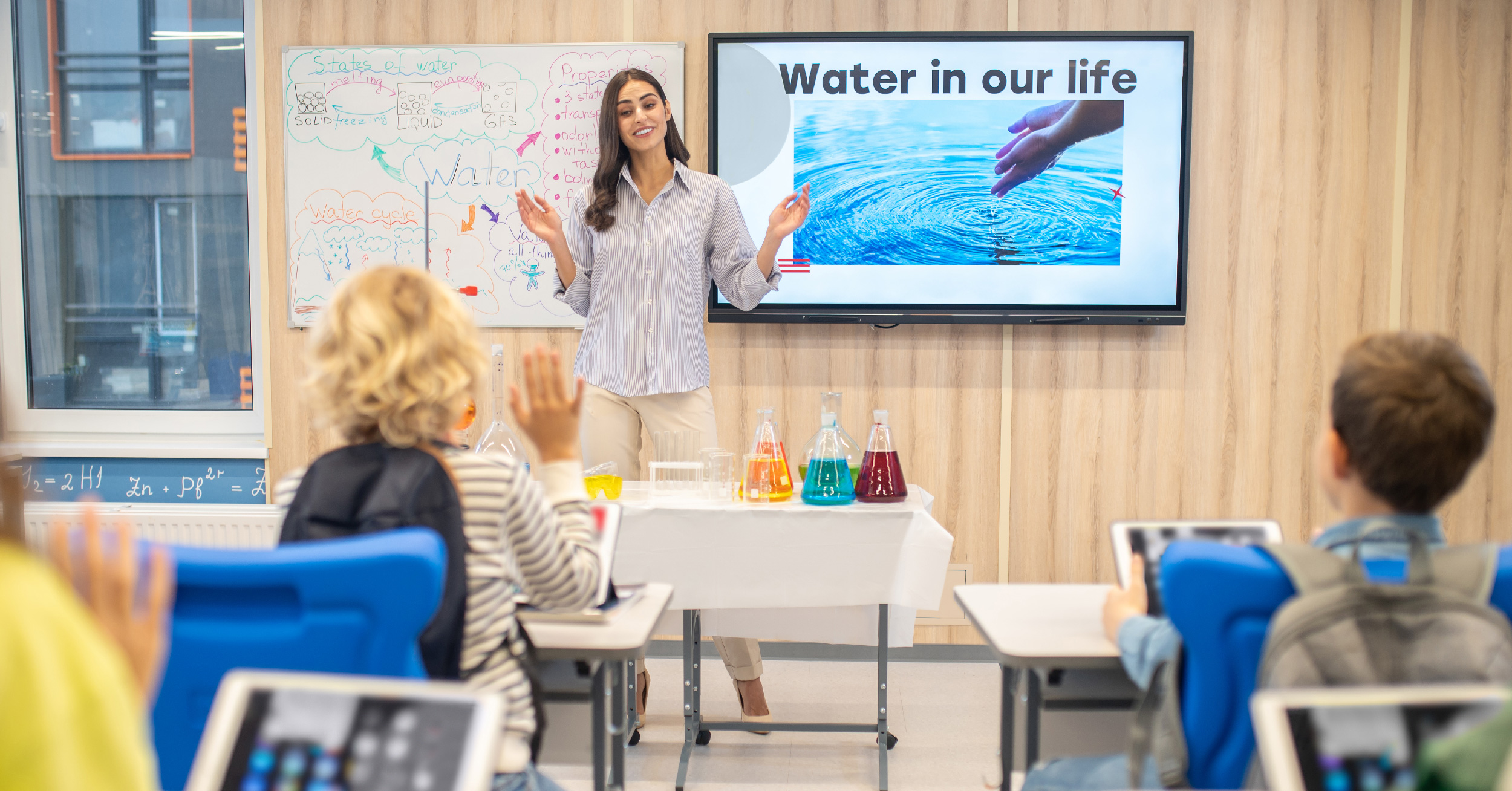
Do you ever find yourself pondering questions like:
- How can I maintain order while fostering a dynamic and enjoyable learning atmosphere?
- What are the secrets to keeping my students engaged and excited about the subject matter?
- How can I manage the challenges unique to middle school settings?
Well, you’ve landed on the right page! In this comprehensive guide, we’re going to explore proven effective, and tailor-fit classroom management strategies for middle school teachers. Whether you’re a seasoned educator seeking fresh approaches or a new teacher trying to figure out the art and science of classroom management , our aim is to equip you with a toolbox filled with practical, fun, and 100% doable strategies.
Take note: classroom management strategies for middle schoolers are very different from those employed in early education, and making a misstep can lead to undesirable consequences. So, hop along to see how you can transform your classroom into a thriving hub of motivated students in your middle school classrooms!
Why Classroom Management Strategies for Middle School Plays a Crucial Role
As educators, you’re no strangers to the incredible transformations young minds undergo during the middle school years. This phase marks a pivotal transition from childhood to adolescence , a journey filled with curiosity, self-discovery, and the quest for independence. It’s a time when students begin to test boundaries, question authority, and develop their own identities.
Here’s where classroom management strategies come in:
- Better Personal Growth : Effective classroom management provides a sense of structure and consistency to create a conducive learning environment that allows students to focus on learning and personal growth.
- Academic Progress and Excellence : Well-managed classrooms minimise disruptions and maximize instructional time, facilitating academic progress and excellence at the time when students start tackling more complex and specialised subjects.
- Development of Good Attitudes and Values : Effective classroom management sets the tone for a respectful and positive atmosphere, facilitating the development of good attitudes and values, preparing students towards the real-world.

Navigating the Adolescent Transition: A Pedagogical Challenge
The transition to adolescence is a complex and fascinating process. Middle schoolers are taking their first steps into the world of independence , and are further refining their sense of self and aspirations. This journey can be both thrilling and turbulent. As teachers, you play a crucial role in helping students navigate this transformative period.
Here’s the key:
- Transitioning adolescents are naturally inclined to test boundaries and question authority. Effective classroom management acts as a scaffolding of support, providing clear expectations and guidelines for behavior. It creates a safe space for students to explore their newfound independence while respecting the needs of the classroom community.
- Middle school students crave engagement and relevance. Effectively planned classroom management strategies for middle school students can ensure that lessons remain captivating and meaningful. This not only keeps students focused but also fuels their curiosity and love for learning.
- Soon-to-be-adolescents may not readily open up, but they long for connection and understanding. A well-managed classroom fosters positive teacher-student relationships, creating an environment where students feel valued, heard, and supported. This emotional connection can be a powerful motivator.
Benefits of Prioritizing Classroom Management for Middle School
Effective classroom management isn’t just a means to maintain order; it’s a powerful tool that facilitate teaching and support student development at the critical period. Let’s explore some of the key advantages that come with mastering this art:
For Teachers
😌 Reduced Stress and Burnout
Managing conflicts and misbehaviours in middle school can get challenging. When a classroom is well-managed, teachers experience lower levels of stress and burnout. This means you can focus more on the joy of teaching and less on managing disruptive behavior.
🍎 Enhanced Teaching Experience
Classroom management strategies create a more positive teaching environment. This positivity can translate into a more enjoyable teaching experience, which, in turn, can lead to a longer and more satisfying career in education.
💪🏻 Increased Efficiency
With effective management, you’ll spend less time dealing with discipline issues and more time on actual teaching. This increases the efficiency of your lessons and allows you to cover more teaching material, facilitating academic progress.
For Students
😇 Improved Behavior
As compared to preschoolers, middle schoolers can better understand expectations. Clear expectations and consistent management can effectively lead to improved student behavior. When students know what’s expected of them and understand the consequences of their actions, they are more likely to behave appropriately.
⏳ Increased Learning Time
A well-managed classroom maximizes learning time, which is crucial for especially when students are beginning to grasp more complex concepts and subjects. Students spend less time being distracted or disrupting others, allowing for more time devoted to actual learning and skill development.
💓 Positive Teacher-Student Relationships
Positive teacher-student relationships are important regardless of which education stage you students are at. When students feel respected and supported, they are more likely to engage with the material and seek help when needed.

🤲🏻 Enhanced Social and Emotional Skills
Social and emotional skills are among the topmost sought-after skills in the current workplace. And good classroom management often incorporates social and emotional learning components, ensuring students learn to manage their own behavior and emotions and develop these crucial life skills that extend beyond the classroom.
💼 Preparation for Real-World Challenges
Classroom management teaches students important life skills, such as responsibility, self-control, and conflict resolution. These skills are invaluable as they prepare for future challenges in higher education and the workforce.
Classroom Management Strategies for Middle School Teachers

Teaching middle schoolers can sometimes feel like riding a rollercoaster through a whirlwind of emotions and energy. But fret not; with these unique classroom management strategies, you can not only survive but thrive in this exciting journey.
1. Two-Minute Tidbits
Set aside the first two minutes of each class for students to share something exciting or interesting that happened in their lives. This personal touch not only builds rapport but also channels their morning enthusiasm positively. It helps students start the day on a bright note, reducing potential disruptions.
Why it works : Middle schoolers often come to class bursting with stories. Allowing them to share these stories channels their energy into a constructive and engaging activity.
2. Student-Generated Rules
Instead of imposing classroom rules, involve your students in creating them. Encourage them to brainstorm and discuss rules that they believe will make the classroom a better place for learning. When students have a say in the rules, they’re more likely to abide by them.
Why it works : Middle schoolers crave autonomy and respect. Allowing them to shape the rules empowers them and fosters a sense of responsibility.
3. The Power of Choice

Give students choices whenever possible. Whether it’s selecting a project topic, a reading assignment, or a group partner, choice promotes a sense of ownership and engagement. Middle schoolers appreciate having a say in their learning journey.
Why it works : Middle schoolers are developing their identities and preferences. Providing choices honors their individuality and encourages active participation.
4. Scaffolded Independence
Gradually build students’ independence by scaffolding your expectations. Start with clearly defined steps and then gradually release responsibility as they become more adept. This method helps prevent frustration and empowers students to take ownership of their learning.
Why it works : Middle schoolers are in a transitional phase where they’re seeking more independence. Scaffolding allows them to develop skills without feeling overwhelmed.
5. The Calm Corner
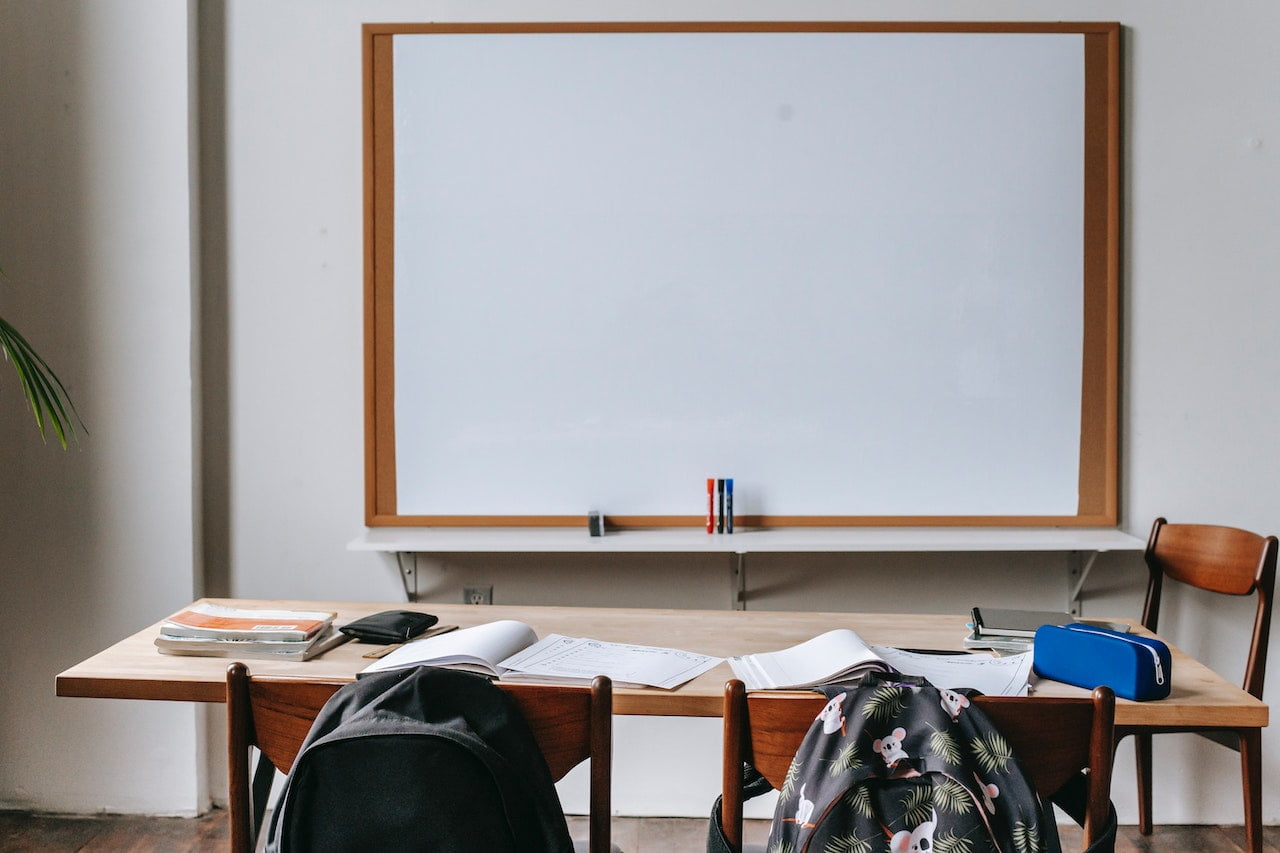
Designate a “Calm Corner” in your classroom where students can take short breaks to refocus when needed. Middle schoolers sometimes struggle with self-regulation, and this space provides them with a quiet, non-punitive area to collect themselves.
Why it works : Middle schoolers can become easily overwhelmed, and a designated calming space helps them manage their emotions and return to class ready to learn.
6. The 10-Second Reset
When you notice that the energy in the room is getting too chaotic or off-track, initiate a “10-Second Reset.” This involves everyone taking a deep breath and refocusing their attention on the task at hand. It’s a quick and effective way to regain control without interrupting the flow of the lesson.
Why it works : Middle schoolers can easily get carried away. The 10-Second Reset provides a gentle reminder to refocus and stay on track.
7. Peer Accountability Partners
Assign students as “accountability partners” for specific tasks or assignments. They work together to ensure each other’s success, fostering a sense of responsibility and teamwork. Knowing that a peer is relying on them can motivate students to stay engaged.
Why it works : Middle schoolers value peer relationships and are more likely to take responsibility when they know their peers are counting on them.
8. Mystery Student Rewards
Select a “Mystery Student” each day without revealing their identity. This student earns a reward (e.g., a small treat or privilege) if they consistently follow classroom rules and demonstrate positive behavior. It adds an element of excitement and encourages everyone to be on their best behavior.
Why it works : Middle schoolers love surprises and friendly competition. The Mystery Student concept keeps them engaged and striving for positive behavior.
9. Brain Break Bonanza
Integrate short brain breaks into your lessons, allowing students to stretch, move, or engage in quick, fun activities. Middle schoolers have energy to spare, and these breaks help them refocus and maintain attention during longer lessons.
Why it works : Middle schoolers have shorter attention spans and need periodic breaks to recharge and stay engaged.
10. Growth Mindset Celebrations
Celebrate not only academic achievements but also the effort, perseverance, and growth mindset displayed by students. Recognize and reward their commitment to improvement, which fosters a positive classroom culture.
Why it works : Middle schoolers are at a stage where they’re developing their self-concept. Recognizing effort over outcomes encourages them to embrace challenges.
11. Empathy Education
Dedicate time to teach empathy and emotional intelligence explicitly. Use stories, discussions, and role-play to help students understand and respect each other’s feelings and perspectives. This builds a more empathetic and harmonious classroom.
Why it works : Middle schoolers are navigating social complexities, and teaching empathy helps them build healthier relationships.
12. The Agenda Alliance

Encourage students to maintain daily agendas or planners to track assignments, deadlines, and important dates. This strategy promotes organization, responsibility, and accountability.
Why it works : Middle schoolers are developing organizational skills, and agendas help them stay on top of their responsibilities.
13. Catch ‘Em Being Good
Create a culture of positivity by acknowledging and praising students for good behavior and contributions. Public recognition, such as “Caught Being Good” awards, reinforces desired behavior.
Why it works : Middle schoolers respond well to positive reinforcement and appreciate recognition for their efforts.
14. Choice-Based Seating
Allow students to choose their seats within certain parameters. This choice empowers them and can reduce classroom disruptions related to seating assignments.
Why it works : Middle schoolers often seek autonomy and choice. Giving them control over their seating can lead to a more harmonious classroom.
15. Conflict Resolution Workshops
Teach conflict resolution skills through workshops or classroom discussions. Equip students with tools to resolve disputes peacefully and constructively, reducing disruptions and fostering a supportive classroom environment.
Why it works : Middle schoolers may encounter conflicts, and teaching them resolution skills empowers them to handle these situations maturely.
16. Name That Strategy
Inject creativity into your classroom rules by giving them catchy names. For instance, instead of “Raise your hand to speak,” call it “The Talk Torch.” This playful approach makes adhering to rules more engaging and memorable for middle schoolers.
Why it works : Creative names add an element of fun and curiosity to classroom expectations, making them more appealing.
17. Storyboard Reflections

Encourage students to express their thoughts and feelings through visual storytelling. Have them create storyboards to reflect on their behavior or classroom experiences. This artistic expression fosters self-awareness and creativity.
Why it works : Visual reflection offers an alternative avenue for students to communicate their emotions and experiences.
18. E xit Ticket Express
Incorporate behavior assessment into exit tickets. Include an activity where students rate their behavior during the lesson on a scale from 1 to 5. This self-assessment promotes accountability and provides you with valuable insights.
Why it works : Self-assessment empowers students to monitor their behavior and encourages responsibility.
19. Lunch Bunch Meetings
Organize occasional lunchtime meetings with small groups of students. Use this informal setting to discuss classroom behavior, challenges, and successes. It creates a supportive and open dialogue, fostering a sense of belonging.
Why it works : Informal meetings build trust, allow students to voice concerns comfortably, and strengthen the teacher-student relationship.
20. Random Acts of Kindness Challenges
Initiate challenges that encourage students to perform random acts of kindness for their peers. Create a challenge board where students can track their acts of kindness. This not only cultivates empathy but also builds a positive classroom culture.
Why it works : Acts of kindness promote empathy, cooperation, and a sense of community.
21. Classroom Roles Roulette
Rotate classroom roles such as line leader, timekeeper, or materials distributor. Use a random selection method like drawing names from a hat. This keeps students engaged, responsible, and eager to contribute.
Why it works : Rotation ensures that all students have the opportunity to take on leadership roles and actively participate in classroom management.
22. Personalized Behavior Plans
Collaborate with students to create personalized behavior plans. Allow them to set their own behavior goals and choose the rewards for meeting them. This empowers them to take ownership of their actions and behavior.
Why it works : Personalized plans increase student motivation, responsibility, and their commitment to achieving behavioral goals.
23. Thumbs-Up Thursdays

Designate Thursdays as a day for students to give a “thumbs-up” to a peer who exhibited exemplary behavior or kindness during the week. This peer recognition fosters positive social interactions and reinforces desired behavior.
Why it works : Peer recognition builds a sense of community, encourages positive behavior, and reinforces classroom norms.
24. E moji Emotions Chart
Introduce an “emoji emotions chart” where students indicate their emotional state at the start of the day or class. This provides valuable insights into their emotional well-being and allows you to tailor your teaching accordingly.
Why it works : Understanding students’ emotions enables you to create a supportive and empathetic classroom environment, reducing potential disruptions.
25. Classroom DJ
Allow students to take turns as the “Classroom DJ.” They can select background music during work periods, fostering a positive and productive atmosphere. Encouraging them to create playlists can also be an engaging activity.
Why it works : Music enhances focus, motivation, and a sense of ownership over the classroom environment.
26. Goal-Oriented Challenges
Set class-wide behavior challenges with specific goals. For instance, if the class achieves a predetermined number of behavior points, they earn a special reward or privilege. This approach promotes teamwork and motivation.
Why it works : Goal-oriented challenges encourage cooperation, teamwork, and a sense of accomplishment.
27. Behavior Bingo
Create a “Behavior Bingo” card featuring various positive behaviors (e.g., helping a classmate, participating actively). When students achieve a line or pattern on their Bingo card, they earn a reward. This gamified approach keeps behavior expectations engaging.
Why it works : Behavior Bingo transforms positive behavior into a game, making it enjoyable and rewarding.
Bonus: Best Practices to Successfully Implement Classroom Management Strategies For Middle School

🎵 Harmonious Routines
Like a symphony, maintain consistent rhythms in your classroom activities. These routines help students know what to expect, allowing them to focus on learning instead of anticipating disruptions.
🚧 Crystal-Clear Boundaries
Paint your classroom rules on the canvas of clarity. Craft straightforward expectations that leave no room for guesswork, ensuring everyone knows the melody of behavior.
🔄 Adaptability Alchemy
Be a maestro of adaptability. Flexibility, like a skilled improvisation, allows you to fine-tune your strategies according to the ever-changing dynamics of your classroom.
☀️ Radiate Positivity
In your classroom, be the sun that brightens the day. Shine positivity on your students, nurturing an environment where rays of encouragement and praise overshadow shadows of negativity.
🌱 Relationship Gardens
Cultivate connections like a seasoned gardener. Nurture relationships with your students, tending to their growth and well-being like precious blooms.
👂 Listen Actively, Empathize Deeply
Tune your ears to the symphony of your students’ voices. Practice active listening and empathetic understanding to harmonize with their needs and emotions.
📊 Strategy Assessment Expedition
Embark on regular journeys of strategy assessment. Evaluate the effectiveness of your methods, adjusting your course to navigate uncharted waters with wisdom.
🎶 Student Voice Symphony
Be the conductor of collaboration, and your involve students in the creative composition of your classroom management. Let their voices harmonize with your strategies for a symphony of success.
🔄 Reflection Odyssey
Take introspective voyages into your teaching experience. Reflect on the crescendos of achievement and the gentle decrescendos of challenges, constantly learning from each note.
🏝️ Self-Care Oasis
Amidst the whirlwind of education, create an oasis of self-care. Replenish your spirit, ensuring you remain a radiant lighthouse guiding your students through the seas of knowledge.
Middle school represents a critical transition phase between early education and tertiary education. You will almost certainly be presented with a new set of challenges and opportunities each day.
However, we trust that the classroom management strategies for middle school we are sharing will prove invaluable. And a gentle reminder to all middle school teachers: continue learning alongside your students so you can stay attuned to the evolving needs of your students as they grow and mature into young adults.
May your commitment to effective classroom management continue to provide structure and support for your students, creating an environment where learning thrives. With each passing day, you contribute to the growth and development of the next generation. 💪🏻
About Ausbert Generoso
Try classpoint for free.
All-in-one teaching and student engagement in PowerPoint.
Supercharge your PowerPoint. Start today.
800,000+ people like you use ClassPoint to boost student engagement in PowerPoint presentations.
- Presentation Ideas for Students: Easy and Unique Topics
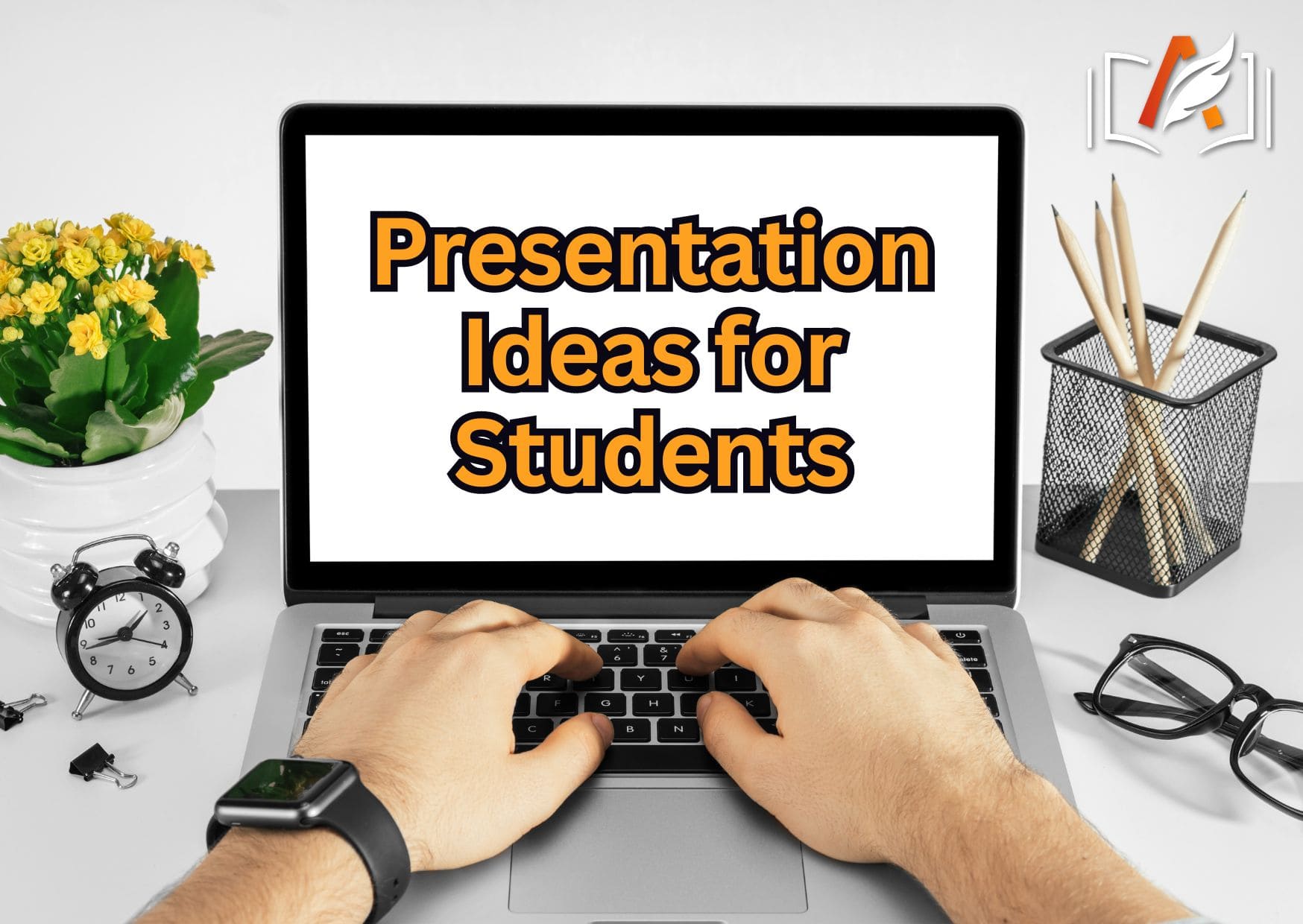
Presentations at school are not just an everyday task: they are your chance to show you are a bright student and demonstrate your vision. Adding some creativity and your personal touch to your presentations will provide an extra level of interest and help your presentation remain in people’s memories.
You don’t need to be a techie, either. Software packages such as PowerPoint, Google Slides, and Canva are easy to use and provide many colorful devices to make your ideas visually striking.
To create this article, we invited experienced presentation designers and effective presenters to share tips and original ideas for presentations that will help students succeed. So, choose an interesting topic from our list and create a presentation using the tips from our experts!
List of Topic Ideas for Different Categories
As you already know, the right topic needs to appeal to you, fit the occasion, and hold the interest of your audience. Here's a more detailed checklist of the characteristics of the best presentation topics:
- Engaging: Captures and holds the audience’s interest throughout the presentation.
- Relevant: Relates to trends and topics in your field of study or work.
- Researchable: Information and resources are available to support your claims and arguments.
- Brief and Concise: Easily understood by the target audience with no convoluted ideas or overused terminology.
- Original: Offers a fresh perspective or approach, distinguishing it from common topics.
- Appropriately Scoped: Well-suited for the allotted presentation time; not too broad or too narrow.
Thus, when selecting presentation topics for students, consider these factors to create an excellent presentation. You can also explore what a good essay topic looks like to get more inspiration and ideas for your presentation.
So, check out our list of 100 PowerPoint presentation topics for students, which has been thoroughly structured to make it easier for a school or university student to choose a topic!
10-Minute Presentation Ideas
You must pick your subject carefully if you have 10 minutes to make an impression. It has to be brief and compelling. Here are ten short and memorable ideas for presentation topics:
- The Future of Renewable Energy Sources
- The Psychology Behind First Impressions
- The Rise of Artificial Intelligence in Everyday Life
- Minimalism: More Than Just Decluttering
- The Impact of Social Media on Mental Health
- Brief History of the Internet
- How to Start a Small Business
- The Basics of Personal Financial Management
- The Importance of Voting in Democratic Societies
- The Benefits of Daily Physical Activity
If you need help creating a great topic, consider consulting expert writers. The PowerPoint presentation writing service can provide engaging presentation examples for students. Moreover, experienced authors will help you with any part of your presentation if required.
Good Higher School Presentation Ideas
School presentations for high school students can be a perfect way to introduce exciting topics and help them broaden their educational horizons. Here are ten PowerPoint presentation topics for higher school students:
- The Effects of Global Warming on Our Planet
- The Evolution of Pop Music
- Understanding the Stock Market
- The Science of Habit Formation
- Exploring Career Options in Technology
- The Role of the United Nations in World Peace
- The Influence of Advertising on Consumer Behavior
- Teenage Mental Health: Understanding and Support
- The History and Impact of Comic Books
- Cybersecurity: Protecting Yourself Online
Business Topics for Presentation at University
Business presentations must be informative, explaining industry trends, strategies, and innovations. Here are the ten most impressive business slideshow ideas for students:
- The Impact of E-commerce on Traditional Retail
- The Role of Social Media in Modern Marketing Strategies
- Startup Culture: Evolution and Impact
- Corporate Social Responsibility: Examples and Outcomes
- The Future of Work: Remote vs. In-Office
- Blockchain Technology in Business
- Global Economic Trends and Their Impact on Local Businesses
- Customer Relationship Management: Best Practices
- Business Ethics in the Age of Technology
- Mergers and Acquisitions: Strategy and Outcomes
>> Find more business research paper topics for presentation at StateOfWriting!
Medical and Nursing Topics for Presentation
Medical and nursing presentations usually focus on today's issues, innovations, and new or best practices. This list covers ten interesting topics for presentation for healthcare professionals and students:
- The Role of Telemedicine in Modern Healthcare
- Advances in Robotic Surgery
- The Impact of Mental Health on Physical Well-being
- Ethical Dilemmas in Nursing Practice
- The Importance of Patient Education in Chronic Disease Management
- Breakthroughs in Alzheimer's Disease Research
- Handling Medical Emergencies in Remote Areas
- The Evolution of Nursing Roles in Healthcare
- Strategies to Combat Antibiotic Resistance
- Patient Safety and Quality Improvement in Hospitals
Unique Management Topics for Presentation
Good management is at the heart of a successful enterprise. The following ten creative presentation ideas explore leadership, strategy, and operational effectiveness:
- Leadership Styles and Organizational Impact
- Change Management: Strategies for Successful Implementation
- The Importance of Emotional Intelligence in Leadership
- Project Management Techniques for Efficient Workflow
- Cross-Cultural Management and Its Challenges
- Corporate Governance and Accountability
- Managing Remote Teams: Tools and Tips
- Innovation Management in Companies
- Crisis Management: Case Studies and Lessons Learned
- Performance Management and Employee Development
Interesting Psychology Topics for Presentation
Psychology is a human science that seeks to understand the mechanics of our minds and behaviour. Here are ten topics to do a presentation on psychology that are sure to captivate and educate any audience:
- The Psychology of Motivation and its Impact on Success
- Cognitive Biases and Decision-Making
- The Effects of Stress on Mental and Physical Health
- Child Development: The Role of Nature vs. Nurture
- The Influence of Personality on Lifestyle Choices
- Psychological Techniques in Pain Management
- The Impact of Social Media on Teen Self-Esteem
- Memory Formation and the Mechanisms of Forgetting
- The Role of Therapy in Treating Anxiety Disorders
- The Psychological Effects of Color on Mood and Behavior
Best Biology Topics for Presentation
Life comes in many forms, and biology is the science that explores them all. Here are ten easy topics for presentation on biology:
- The Genetic Basis of Inherited Diseases
- The Role of Microbiomes in Human Health
- Conservation Strategies for Endangered Species
- The Process and Implications of CRISPR and Gene Editing
- Plant-Animal Interactions and Their Ecological Impact
- Marine Biology: Deep Sea Ecosystems and Their Mysteries
- The Biology of Aging and Longevity
- Biotechnology in Agriculture: Innovations and Ethics
- Behavioral Ecology and Animal Communication
Good Physics Topics for Presentation
Physics helps people understand the general laws of the Universe. Here are ten unique topics for presentation in college:
- The Theory of Relativity and Its Applications
- Quantum Mechanics: Principles and Paradoxes
- The Physics of Black Holes and Neutron Stars
- Advances in Particle Physics and the Large Hadron Collider
- The Role of Physics in Renewable Energy Technologies
- Nuclear Fusion: The Future of Energy?
- The Science of Thermodynamics and Its Modern Applications
- Astrophysics: Exploring the Composition of the Universe
- The Physics of Sound and Music
- Fluid Dynamics in Nature and Technology
Chemistry-Related Topics for Presentation
Chemistry is central to many innovations around us and our daily experiences. Let’s explore ten presentation topic ideas explaining chemistry from practical applications and theoretical research:
- The Chemistry of Everyday Life: Soaps and Detergents
- Organic Chemistry and Pharmaceutical Development
- Nanotechnology in Chemistry: Materials and Applications
- The Role of Chemistry in Environmental Conservation
- Catalysis and Its Importance in Industrial Processes
- The Future of Materials Science with Polymers and Composites
- Biochemistry: Proteins and Enzymes at Work
- The Chemistry of Food and Flavor
- Electrochemistry and Its Applications in Energy Storage
- Chemical Safety and Toxicology in the Modern World
Tips for Creating Powerful Presentations
Shaping the perfect presentation is vital to persuade the audience to listen. Mastering the art of presentation can impact your success. Our experts have kindly provided basic advices for a successful presentation:
- Know your Audience: Match the content to your audience's interests, level of knowledge, and expectations.
- Lead with a Hook: The story or compelling start that helps you capture attention and achieve the tone you want for your presentation.
- Use Visuals Wisely: Relevant visuals can support and enhance your message – but must never overshadow it.
- Practise Makes Perfect: Rehearse your speech beforehand many times to deliver it more fluently and confidently.
- Make Your Presentation Interactive: Add questions, interactions, and active engagement with your audience to keep them interested.
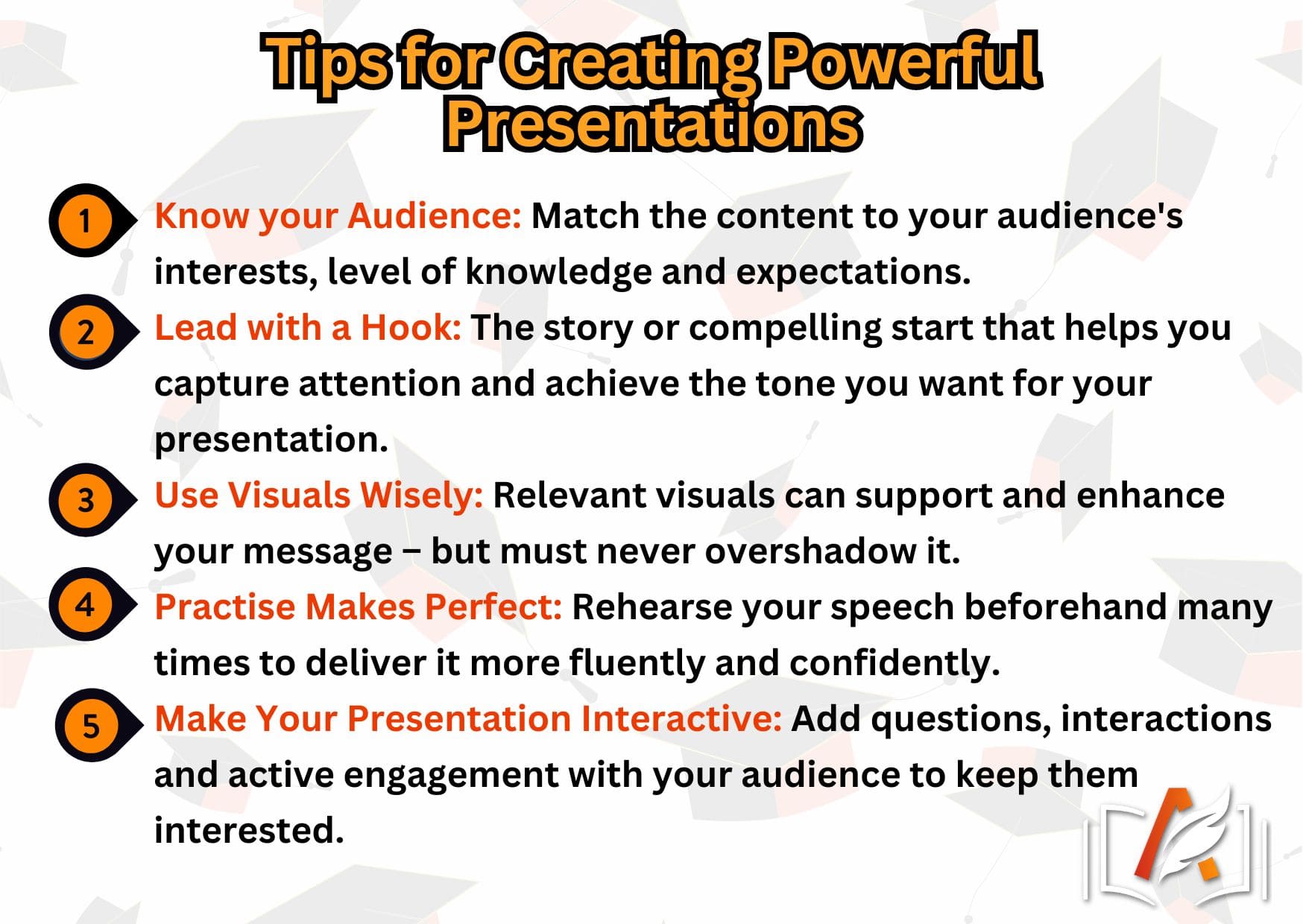
To be effective with presentations, you must know your audience, have a killer beginning, use stage-appropriate visuals, practice, and use a strong engagement hook.
Elevate Your Presentation to Leave a Lasting Impression
To sum up, picking interesting presentation ideas for students and adding a touch of creativity to them can turn school assignments into memorable experiences. You can also use visual aids or UK writing service to make your presentation eye-catching and showcase your unique perspectives and insights. Your efforts will impress and inspire those who listen.
- How to Write a Lab Report: Tips from Academic Researchers
- 6 Tips For Finding The Best Essay Topics
- Business Research Topics: Selected by Experts
- Unique Discursive Essay Topics To Try In 2024
Writers are verified and tested to comply with quality standards.
Work is completed in time and delivered before deadline.
Wide range of subjects and topics of any difficulty covered.
Read testimonials to learn why customers trust us.
See how it works from order placement to delivery.
Client id #: 000229
You managed to please my supervisor on the first try! Whoa, I've been working with him for over a year and never turned in a paper without having to rewrite it at least once, lol I wonder if he thinks something's wrong with me now.
Client id #: 000154
Your attention to details cannot but makes me happy. Your professional writer followed every single instruction I gave and met the deadline. The text itself is full of sophisticated lexis and well-structured. I was on cloud nine when I looked through it. And my professor is satisfied as well. Million thanks!
Client id #: 000234
I contacted their call-center to specify the possible custom deadline dates prior to making an order decision and it felt like they hadn't even considered a possibility of going beyond the standard urgency. I didn't even want an additional discount for the extended time, just want to make sure I'll have enough time for editing if necessary. Made an order for standard 14 days, we'll see.
Client id #: 000098
I have no idea how you managed to do this research paper so quickly and professionally. But the result is magnificent. Well-structured, brilliantly written and with all the elements I asked for. I am already filling out my next order from you.
Essential Study Skills for Middle School Students
Middle school is a unique transitional period for students, with growing responsibilities and new academic challenges compounding during the two to three year period. During this time, it’s particularly important for students to refine their study skills to prepare for high school and a postsecondary education. Unfortunately, many middle school students are already behind when it comes to developing their study skills.
Let’s break down the most essential study skills every middle school student should learn, why they matter, and what can be done during this critical educational period.
The Importance of Middle School Education
During middle school, students begin to learn more complex subjects and are encouraged to think about their future in academics and beyond. For many students, middle school will be the first time they take classes with many different teachers, who typically will not schedule their projects, homework, and exams with consideration to when other teachers do.
This means some middle school students will realize for the first time that they have to adapt to a changing schedule, the different expectations for each teacher, and to have the mental flexibility to shift between expectations many times a day.
During this time, it becomes apparent when a student lacks important study skills, as they have to balance and prioritize a bigger workload. Middle school students are expected to take more responsibility for their grades than they did in earlier grade levels, which can also reveal areas of weakness in their academic routines.
If students fall behind in middle school, they may enter high school lacking confidence and becoming disinterested in taking their educational opportunities seriously. By developing important study skills in middle school, students can build momentum toward their future while honing helpful life skills like perseverance, a growth mindset, and grit.
How Study Skills Change in Middle School
Middle school is full of changes. Students will see their academic workload increase—but they will also see it begin to look different. A typical middle school curriculum introduces students to more academic independence, since they become more responsible for organization, self-management, and prioritization, all of which are essential study skills .
In elementary school, students are more closely supervised by teachers who often provide supportive study tools. Middle school students must navigate learning how to study on their own. When students receive poor test and quiz grades, they are often told to study more, which is difficult if they really don’t know how to study at all. Students can take advantage of being familiar with different study skills by beginning to learn what does and does not work for them and identifying areas of weakness.
Executive Function Skills for Middle School Students
Executive function refers to the set of cognitive skills that allow a person to plan and complete tasks. These skills affect every part of our lives but can be especially important when it comes to education.
Executive function skills are expected to develop fully between the ages of 13 and 25, so middle school is a crucial time for students to begin to develop strong executive function. Strong executive functions support better study skills, as many executive functions, like time management, are directly applicable to studying and other academic activities.
9 Key Study Skills for Middle School Students
Organization.
With more classes than in elementary school, middle school students have an increased number of materials, assignments, and environments to track. If a student forgets to bring the right book home, they may not be able to study or complete an assignment. If they fail to fill out their planner, they may be caught off guard and unprepared for an important test.
In many situations, teachers post assignments on the learning management systems differently. Systems like Google Classroom, Schoology, and Canvas are designed to have a uniform method of communicating assignments to students, but that does not always happen. Often students spend significant amounts of time looking for assignments online. We call this assignment hide and seek—not necessarily a great use of their time but a necessary one.
During their middle school years, students should practice resource management and organizational skills in order to learn what works best for them, since their workload will only increase when they reach high school. Organizational skills allow students to map out their study plan and give themselves plenty of time to prepare. Organization exists in binders, backpacks, lockers, online calendars, and several other places and can be viewed as a form of self-care.
For middle school students who struggle with this essential study skill, we recommend a dedicated executive function planner , which features step-by-step instructions for forecasting and goal setting as well as tab divider sets that are organized from the student perspective. Keep in mind that organization is a discipline that requires practice and time set aside each week to implement. The more a student practices organizing themselves, the easier it will become.
Note-Taking
For many students, middle school will be the first time they have to take notes without supportive documentation or worksheets. Good notes are essential for studying, yet it can be hard to know where to start. Middle school students should test out different note-taking strategies and methods in order to build this study skill and to find out what works best for them.
One popular note-taking method students can try is the Cornell method , which involves creating two columns, a Cue column and a Notes column. Some students may prefer concept mapping or charting, which involves organizing and connecting facts visually as notes are taken. Middle school serves as a great time for students to explore which note-taking method fits their needs.
Metacognition
Students can feel confident they know a topic well when they can teach that topic to others, but how do they determine what they know and don’t know? Furthermore, if a student stumbles in a specific subject, are they learning from that setback? Do they have a prescriptive way to evaluate their past preparation steps to determine whether it yielded the outcomes they expected?
Mistakes are fantastic opportunities from which to learn if framed correctly. Self-evaluations like those found in the Effective Student Method gives students the opportunity to evaluate themselves in key skill areas creating a degree of curiosity and awareness as they self-assess.
When asked, students often report that no one has ever inquired as to their opinion of themselves as a student. Given they are often judged by their performance and motivated by successes and struggles, engaging students in a realistic dialogue about their feelings enables them to be part of the academic solution. This is the difference between adult-dictated solutions versus collaborative adult/student-built solutions.
Teaching Others
Teaching others is the pinnacle of demonstrating mastery over specific content. But how do students determine if they’re ready to do so?
Fortunately, teachers provide many of the instructional resources online, so students can compile these in a central location. If a teacher has provided a study guide and or practice exercises, students can use the instructional resources to complete the study guide as an answer key. Ensuring the student has the correct responses is a critical aspect of this study skill. Students can also compare the answers or discuss with a peer, thus fortifying or correcting their understanding as needed.
Students can implement this study skill by teaching a parent, a pet, or even an empty room. When teaching the topic, students are able to identify areas where they are unsure or less confident about the subject matter, noting that for further research. Similarly, students can practice retelling what they have learned as a story.
Self-Testing
Self-testing stands out as a popular study technique. Also called retrieval practice, is a study skill supported by science in the book, Make It Stick: The Science of Successful Learning . This book explains, “Practice at retrieving new knowledge or skill from memory is a potent tool for learning and durable retention” (Brown, Roediger and McDaniel).
Many students are familiar with the practice of creating and going through flashcards or practice tests in order to evaluate their knowledge ahead of an exam. Self-testing through flash cards can help students identify what they do not know well and build confidence ahead of a test, helping to mitigate test anxiety.
To make self-testing study skills easier to implement, we recommend students make two or more copies of study guides, maps, and diagrams. The first time the student goes through the tool, they are building an answer key, making sure they have the correct answers for reference. In subsequent attempts, the students use these blank sheets as practice tests, correcting themselves and identifying what they know and don’t know.
This is another form of metacognition—thinking about their thinking. Students can then focus on what they missed rather than what they already know.
Goal Setting
Practical goals give students a clear path forward, allowing students to develop academic independence and to envision their academic future. During middle school, students should set goals appropriately and practice following through on those goals.
As a study skill, goal setting helps students identify what they will accomplish and when they will accomplish it. These goals should be measurable and realistic, thus resulting in a real sense of accomplishment upon completion. SMART goals are often recommended, but we shouldn’t overlook our audience because some goals are as simple as, “I want to be in control of myself,” or, “I would like my parents to leave me alone about schoolwork.” Being knowledgeable and accepting of our students’ goals can make adults a welcome partner.
Building a Routine
A strong study routine can make all the difference when it comes to middle school success. By knowing when to study and where to study, students can find it easier to actually start studying, as the activity becomes familiar and consistent. With a strong study routine in place, students can identify when a project or other activity will require a change in routine or additional dedicated time.
Outlining and Active Reading
Middle school students will have to do more independent reading, with less support from teachers to ensure they are processing the information properly. When reading, it’s easy for a student’s mind to wander, and, before they know it, they’re three pages on without being able to recall a single fact. To succeed at reading and to utilize it as a study skill, students should leverage active reading, which is the practice of critically engaging with a text to evaluate its meaning and better understand it.
Active reading can include annotating, breaking down into smaller sections, and summarizing into notes and visual aids. We recommend starting with a strong outline that includes categories and subcategories, so students see how material is grouped and relates to one another and can discriminate between two similar categories.
Active reading is an important study skill for middle school students, as it gives students the opportunity to spend time with a topic and interpreting its meaning. Students can be tasked with summarizing a paragraph into one or two short phrases, practicing finding the main idea of the paragraph and creating a succinct take away. This study skill grows increasingly important as students move up to high school and receive more challenging and lengthier reading assignments.
Time Management
The study skill of time management gives middle school students the power to appropriately plan ahead and give themselves enough time to study before a test. Most students are unaware of how much time they have, how they spend their time, and how to plan ahead successfully.
With strong time management study skills, students can balance all of their homework, studying, and other activities without feeling overwhelmed or unable to get started. Time management goes hand-in-hand with organization, routine building, and other middle school study skills.
If you’re interested in the first step in developing successful time management study skills, try our free My Available Time exercises here .
Emotional Self-Regulation
Emotional self-regulation may not initially seem like a study skill, but it can be essential for middle school success. School (and life) can be highly stressful for middle school students, and these elevated emotions can make it challenging for students to focus on their workload and envision themselves as successful students. In fact, when a student is elevated or anxious, they are neurologically less able to problem solve.
Self-regulation is an important study skill because it allows students to handle big emotions and overcome any associated anxiety with schoolwork. Self-regulation also allows students to calm themselves when feeling frustrated with a subject, thus preventing them from giving up at the first sign of an obstacle. Self-regulation can work well with the practice of self-care . Taking healthy breaks like walks, exercising, and listening to music can help students reset and re-engage.
Preparing Middle School Students for High School
By the time students begin high school, they are expected to have basic study skills in place, yet many students never experience a dedicated study skills curriculum. Without strong study skills in middle school and high school, students can underperform academically or disengage from the learning process, negatively affecting their future opportunities for postsecondary education.
Middle school students who can implement study activities to develop strong skills and learn to succeed academically have better prospects for college. According to a study by the University of Chicago, “A 3.5 middle school GPA was found to give students about a 50 percent chance of college success.” They also found that “a one point difference in GPAs in eighth grade corresponds to a 20 percentage point difference in the likelihood of passing ninth-grade math.”
At the end of the day, parents may want to ask themselves, does my student need an academic coach or a tutor to develop these study skills? At Effective Students, our goal is to engage students in learning through a partnership with an academic coach , so they can ultimately become a tutor for themselves.
Coaching and Courses for Essential Study Skills from Effective Students
At Effective Students, we focus on the process of learning, including those essential study skills students need in middle school and beyond. Our programs are designed to work alongside students to help them acquire and develop the tangible skills and educational independence to succeed.
Our one-on-one coaching sessions are our top recommendation for building essential middle school study skills. We also offer the supplemental Effective Student™ course, which teaches some of the essential skills our academic coaches teach in an accessible format.
For teachers, we created the Instructor Course , which brings together everything educators need to teach the executive function skills that support strong study skills. The program includes instructional videos, classroom exercises, lesson plans, student materials, and additional resources.
If you’re ready to find the right option for you and your student, contact our team to learn more.
You might also like
- Student Readiness Survey
- How it helps?
Atlanta 3225 Cumberland Blvd SE, Suite 100 Atlanta, GA 30339 470-243-0374
Charlotte 1515 Mockingbird Lane, Suite 400 Charlotte, NC 28209 470-243-0374
- Testimonials
- Meet the Team Atlanta
- Meet the Team Charlotte
- Terms and Conditions
- Privacy Policy
Sorry. This form is no longer accepting new submissions.

Blog » Best Posts , General
9 Career Day Speech and Presentation Ideas (2024)
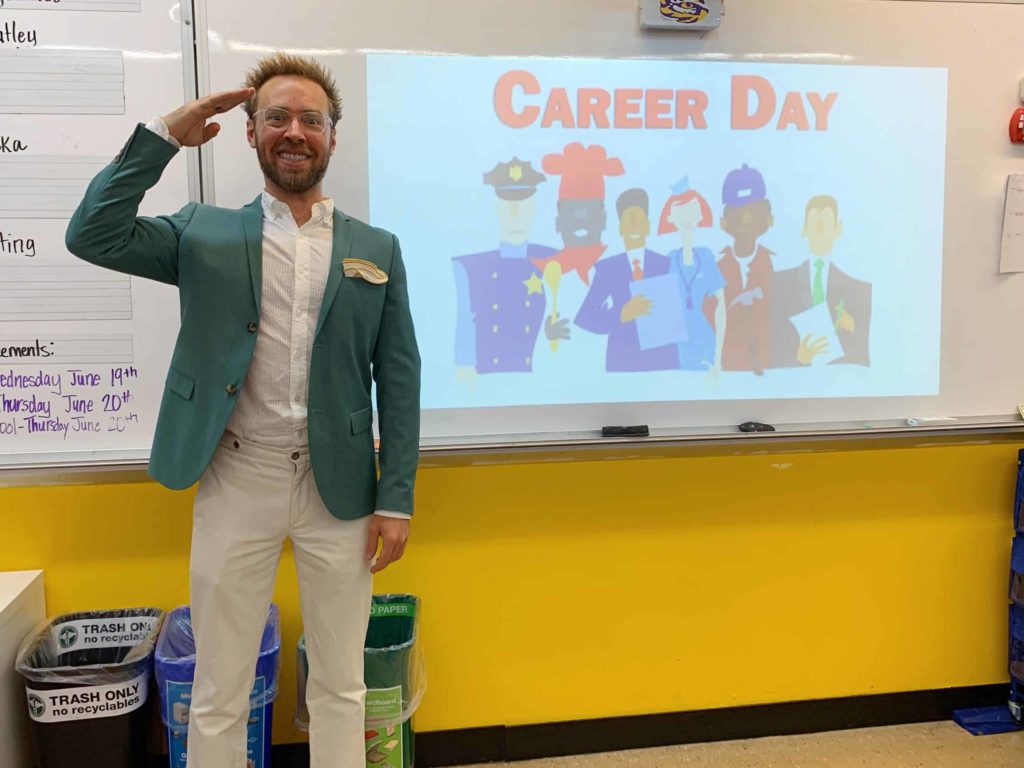
Last updated: May 28, 2024
I was a speaker at an elementary school career day. When I received the invite, I had no idea what to talk about.
What should I say? What questions should I ask?
How should I structure my speech? What were some presentation ideas?
Now I know. And I will tell you everything that I learned.
These are the best tips, tricks, and advice for speakers at an elementary school career day.
The speech and presentation ideas are collected from educators, colleagues, friends, and my own experience. You’ll read in this article about my learnings from hosting a career day, including:
- How to write your speech
- What things to bring (props)
- How to interact with the kids, and more.
Table of Contents
Introduction
My girlfriend invited me to speak to her 2nd grade class at their Career Day.
I immediately thought: How do I speak to children? What do elementary school kids want to hear at a Career Day?
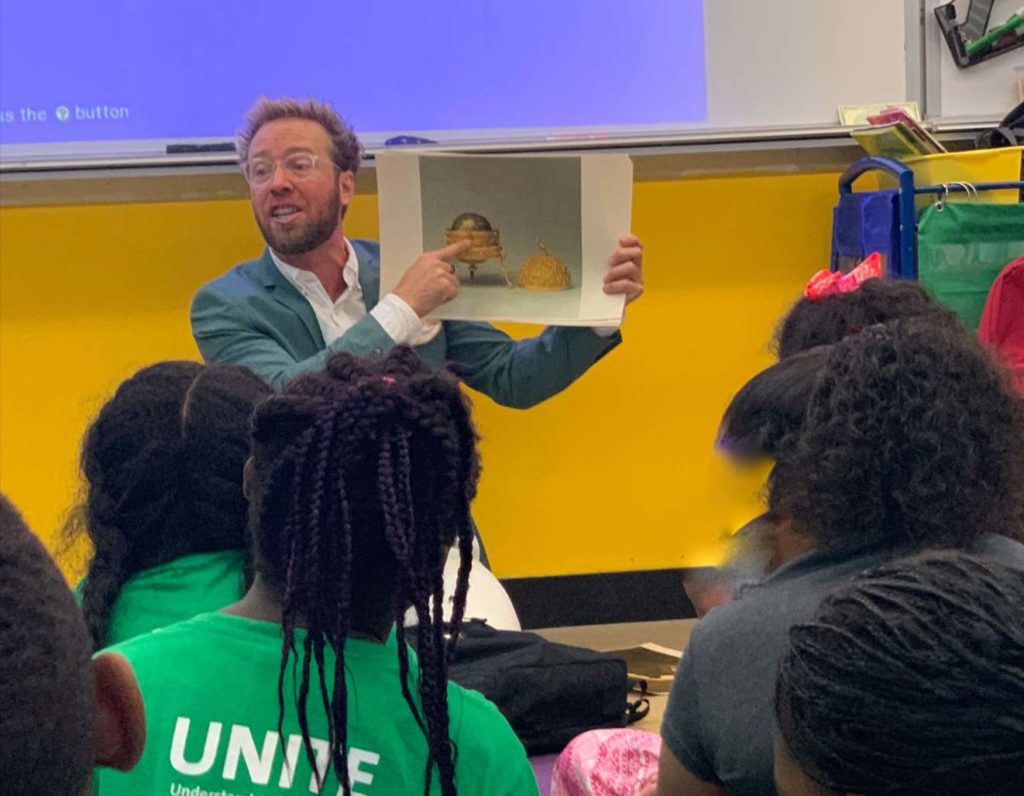
What I learned is that there are many differences in speaking to kids compared to speaking to adults .
You should be aware of the following:
- The kids were very participative. They gave many more questions and interactions and interruptions than I’ve ever had with an adult audience.
- If I was asking a question to the audience and getting answers from multiple people, I had to remind each student of the question. In a presentation to adults, if I ask a question, I can just point at different adults and quickly get multiple answers around the room. Today I found that I had to repeat the question each time I pointed at a new student in order to help them remember what I was specifically asking for.
- The kids all sat on the floor. To raise engagement levels, it was helpful for me to also sit on the floor or in a small chair.
Best Career Day Tips
Here are my best tips that you can use when writing your speech or presentation.
Write your speech with simple language
But don’t “talk down” to the kids in class, even at an elementary school.
Be prepared to answer questions.
The students will be very curious! They had a LOT of questions for me.
Have Good Stories Ready
You should also have good stories that you can tell about situations at work which describe your daily duties.
I received lots of tips and advice for my own talk from my network. Here at the best tips that I used:
- Sit At Their Level
Sit at their level. Either on a little chair or on the floor. Grownups can be scary! — Jason Hackett
- Bring Props
My friend Jarrod suggested that I bring some props. I brought large printed examples of some objects at the museum.
Props are a great way to keep the students engaged and allow them to look at and fiddle with something while they’re speaking with you. — Ecka
- Have High Energy / Be Excited
I think my girlfriend told me this: Get excited! Kids can feel the energy. Be animated and expressive with my body and face.
My friend Danielle said: “Be silly, yet firm.”

Ask the Students Questions
This was one of the best pieces of advice, and a lot of people suggested it.
Make sure there is a back and forth. Ask them questions, encourage them to ask questions. — Sarah Marsom
Ask tons of questions. I start by asking them if they have ever been on a field trip and then explain that I plan field trips for adults. — Theresa
Ask questions throughout!!! It will empower them to feel like they are part of the conversation and promote active listening throughout!!! — Camellia
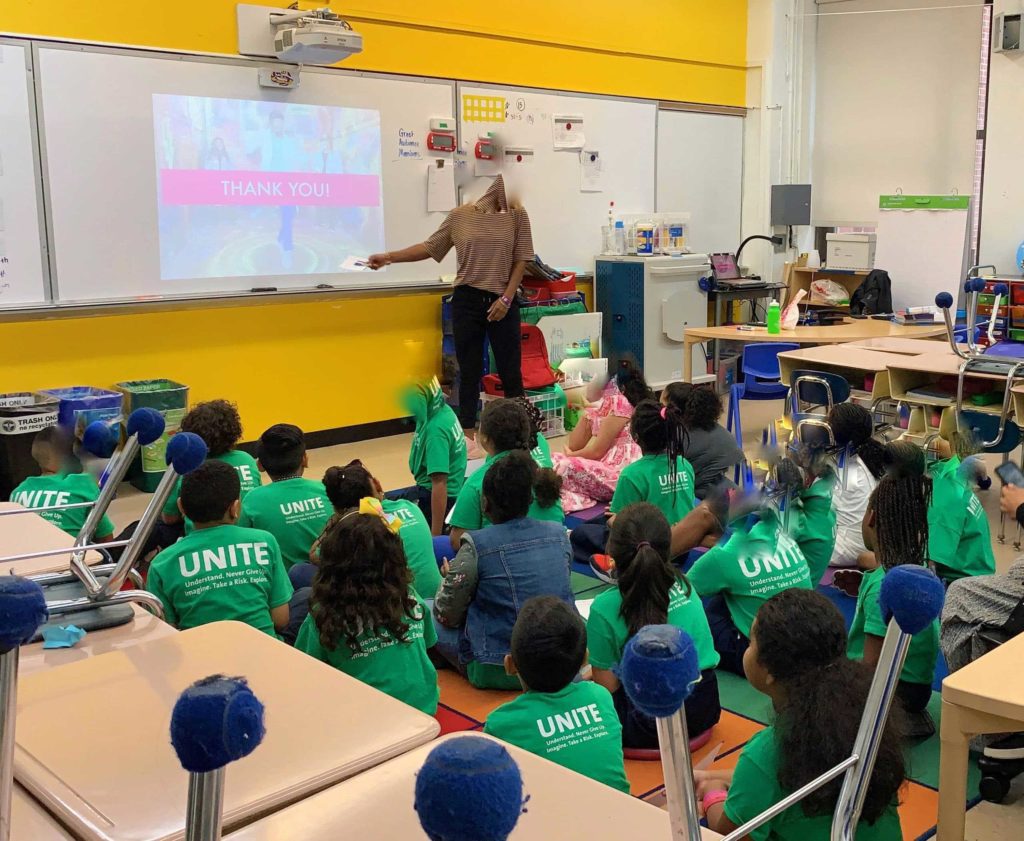
Questions That I Asked
- Who here has ever been to a museum? (raise your hand)
- Who can name a museum in New York City?
- What are some things that you find inside of a museum?
- Entrepreneurship: If you were going to sell something to your friends, what would you sell and why?
- Interactive Play
Think about a game or activity about your job. Allow the children to role play as if they are in a day of your career.
- Bring a Box of Snacks
Check with the teachers beforehand to get approval or dietary restrictions, but this can be a big win! Kids love snacks.
Tell a lot of stories about your job
Kids also love stories. Imagine you’re telling a bedtime story: how would you talk about your career? What is one of your favorite memories from work? What was it like when you first started your job?
Give the students examples
One of the things kids can relate to is toys. Bringing up one of the best toys like SLIME can surely make the whole class excited! Ask them what type of slimes would they like to put if they have a Slime Museum?
Give out handouts or prizes
Do you have any brochures from your job that you can pass around, ideally with photos?
Are there objects that you could pass around the room?
Bring those to your career day speech to make it more interactive.
Sample Career Day Speech
Here’s what you could say for a sample career day speech. It is based on my own presentation to a group of 2nd graders when I introduced myself as a museum tour guide.
Hello everyone! My name is Nick Gray and I am a museum tour guide. Who here has ever been to a museum? Raise your hand if you’ve ever been to a museum before. My job is to be a museum tour guide. That means I walk people around as a guide at an art museum. I tell them about the works of art. Who has ever seen a paining before? Raise your hand if you have ever seen a painting. Keep your hands up. I am going to call on someone now to ask you about what painting you saw, or what you remember. (ask a few students about any painting they have seen before, and what they liked about it) The times that I work for my job are 10AM to 6PM every day. Sometimes I even have to work on Saturday and Sundays, because those are very busy days at the museum. Do you think you would want to work on the weekend? My favorite parts about my job are meeting new people, and doing research about the new works of art. To do my job, you have to be very good at talking to people. Who here likes talking to people? Raise you hand if you like talking to people.
Presentation Feedback
In two of the classes that I spoke to, I asked the teachers to fill out these “Comment Cards” for my career day presentation. I love to get feedback whenever I speak.
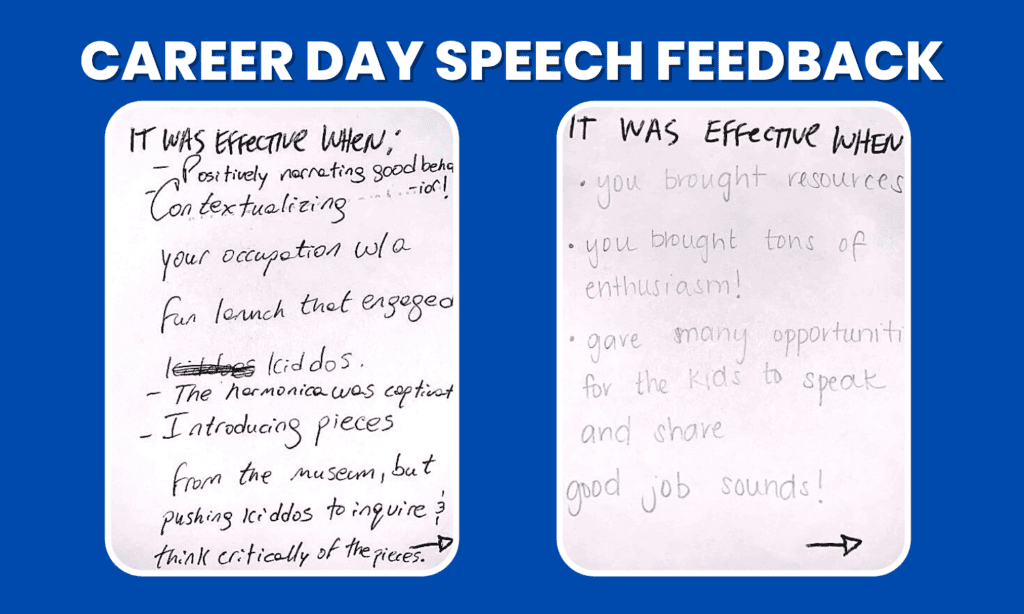
Class 1 — It was effective when:
- Positive narrating good behavior.
- Contextualizing your occupation with a fun launch that engaged kiddos.
- The harmonica was captivating!
- Introducing pieces from the museum, but pushing kiddos to inquir & think critically of the pieces.
Class 2 — It was effective when:
- You brought resources.
- You brought tons of enthusiasm!
- Gave many opportunities for the kids to speak and share.
- Good job sounds! (That was when I played my harmonica.)
Areas for improvement:
- Limiting students called on for each question in the interest of time (time conflicts that are not your fault, though). Nick’s note: I can certainly improve a lot here. There were just SO MANY kids wanting to participate. I didn’t want to make kids feel left out by not calling on them, so I think I tried to call on everyone. This wasted a lot of valuable time.
- I have lots more things that I could improve on! But the teachers were too nice not to critique me more.
Presenting at Career Day as an elementary school speaker was challenging, rewarding, and fun.
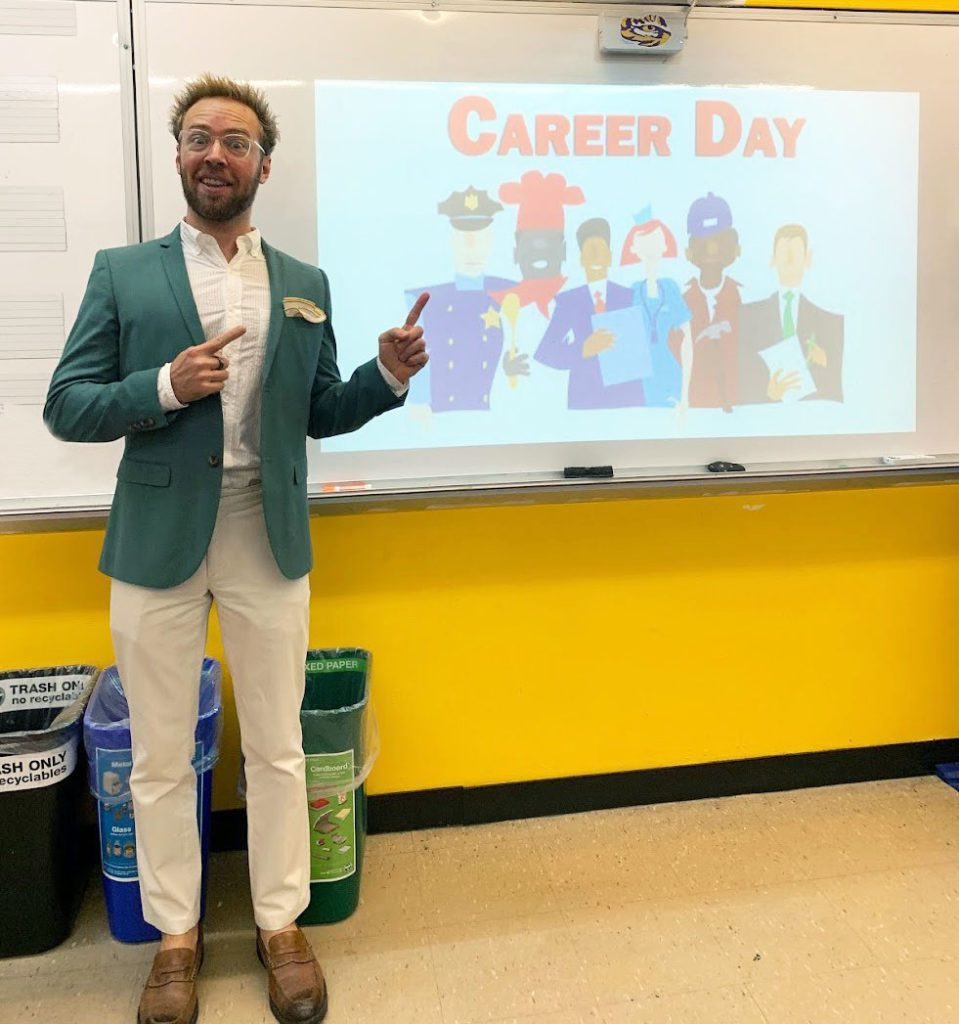
In summary, my best advice for career day speakers is:
- Ask Them Questions
- Tell A Lot Of Stories
- Give The Students Examples They Can Relate To
- Give Out Handouts Or Prizes
I have a newfound respect for teachers at all grade levels. To deal with so many active students for hours every day… wow. It was tiring after one hour and I can’t imagine a whole day of being “on” like that.
What advice do you have for someone who is presenting to elementary school kids on Career Day? Send me an email and let me know.
Thank you to KIPP Infinity in Harlem for inviting me to speak, Zach for organizing and managing the morning, Rachel for proof-reading this post and inviting me, and all my friends on my private Facebook who gave tips and advice.
Video Example of Teaching Style
This is the best video I found online showing classroom management by a teacher. It was helpful to watch and try to emulate some of these things when I presented to the students for Career Day.
What you should do next...
1. subscribe to my free friends newsletter ..
You'll get exclusive life hacks, business research, top tech gadgets, and see new productivity tips. See why 18,000 people say it is one of their favorite emails.
2. Get your 2-page Party Checklist from my book, The 2-Hour Cocktail Party
With over 19 things you can do right now to improve your next party. Plus an Executive Summary of the key lessons inside my book.
3. Read this list of my 39 Best Travel Items.
These are my battle-tested travel items. From electronics, batteries, and adapters to toiletries, organizers, my favorite backpack, and more.
4. Follow me on my social media.
Leave a comment cancel reply.
Save my name, email, and website in this browser for the next time I comment.
Got any suggestions?
We want to hear from you! Send us a message and help improve Slidesgo
Top searches
Trending searches
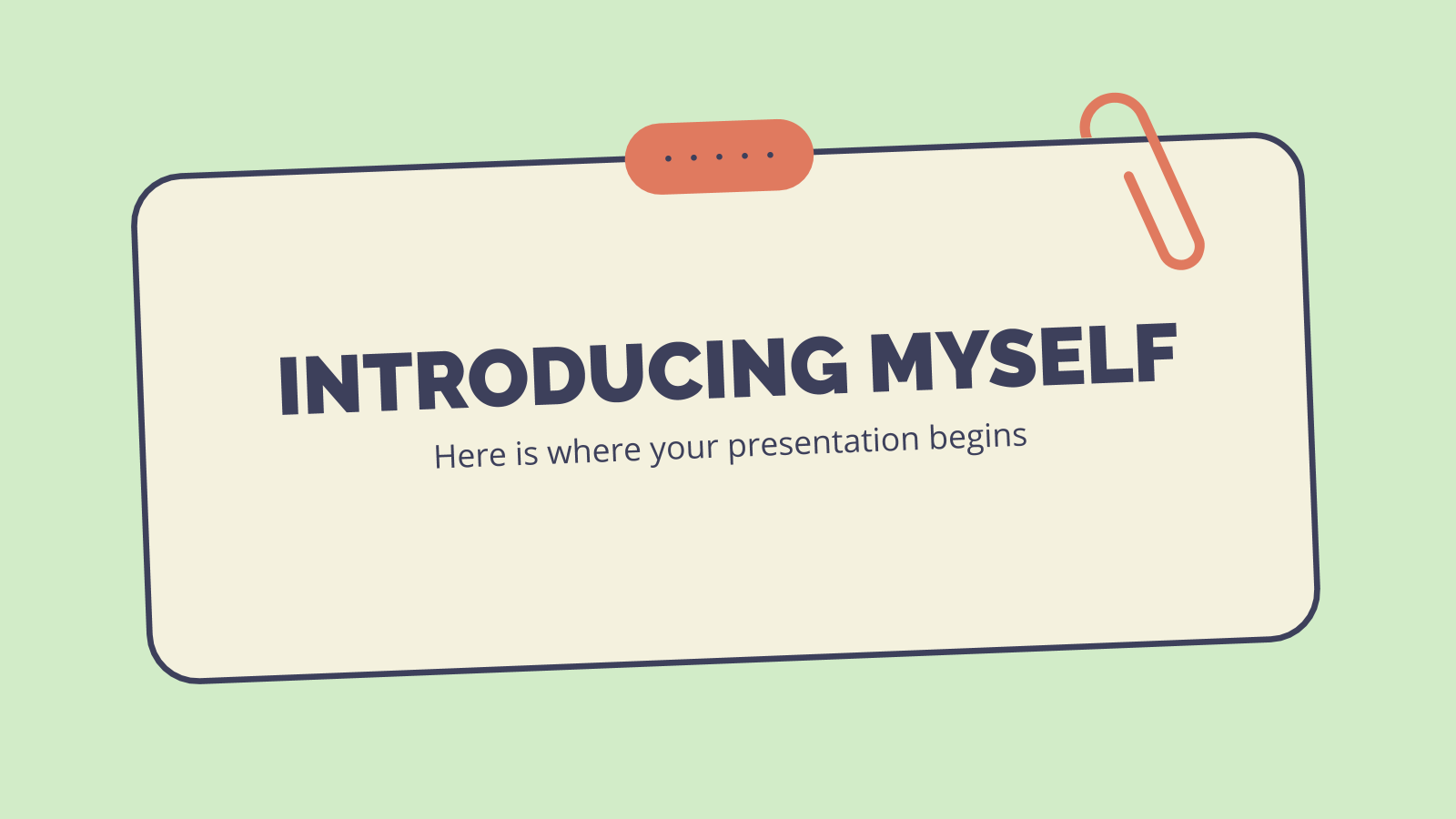
178 templates

pink flowers
255 templates

115 templates

64 templates
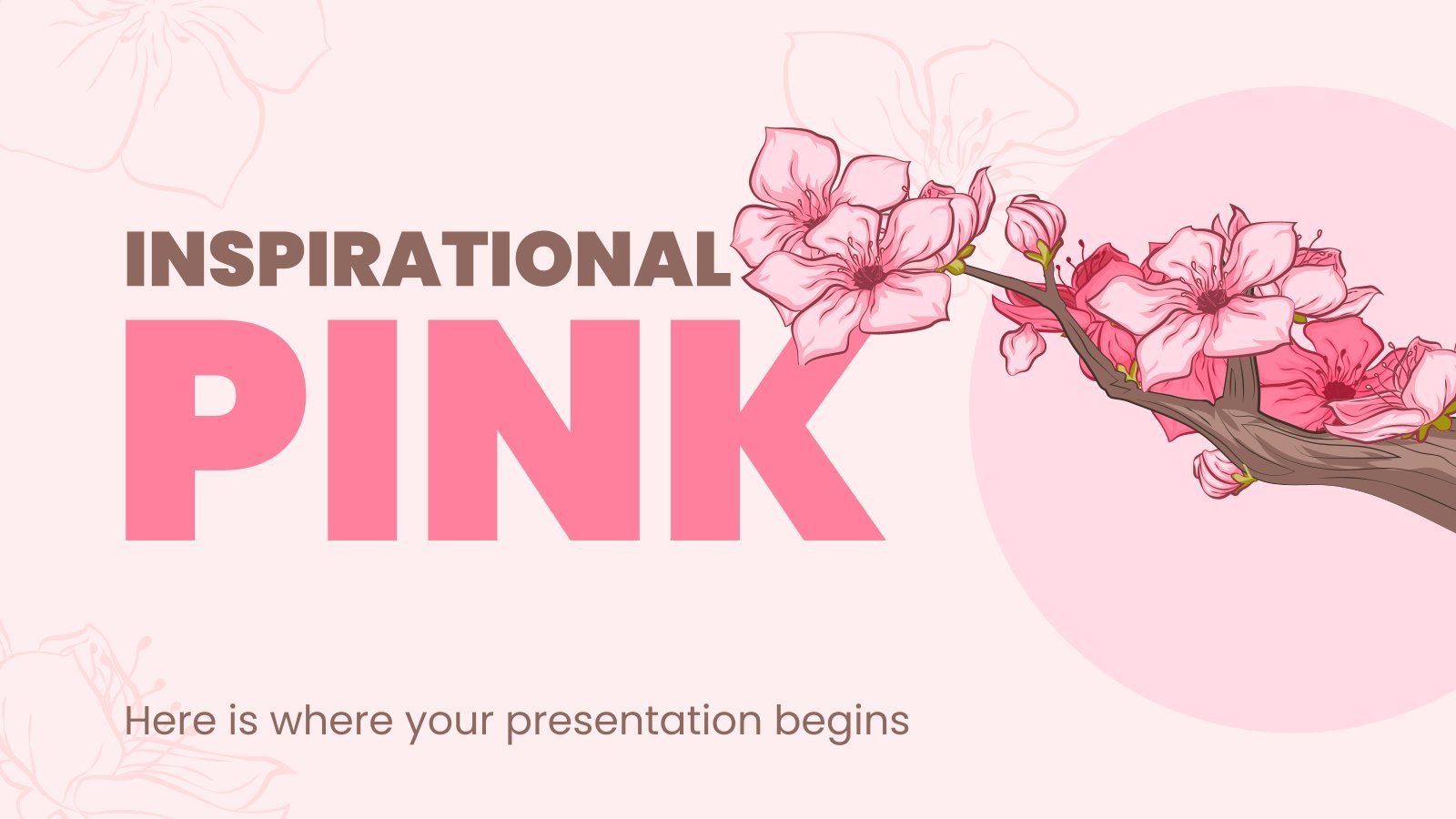
15 templates

62 templates
Interactive Lesson for Middle School
It seems that you like this template, interactive lesson for middle school presentation, premium google slides theme, powerpoint template, and canva presentation template.
Middle school can be quite a challenge, with various courses and subjects to navigate through. But interactive lessons can make the journey much smoother and even a little fun. And we know a lot about how to create fun presentations! This template is interactive, as it contains clickable buttons and examples of questions that redirect to other slides depending on the answer chosen. It's also quite colorful and varied, so it's a matter of you being patient and giving your all when editing this design.
Features of this template
- 100% editable and easy to modify
- 39 different slides to impress your audience
- Contains easy-to-edit graphics such as graphs, maps, tables, timelines and mockups
- Includes 500+ icons and Flaticon’s extension for customizing your slides
- Designed to be used in Google Slides, Canva, and Microsoft PowerPoint
- 16:9 widescreen format suitable for all types of screens
- Includes information about fonts, colors, and credits of the resources used
What are the benefits of having a Premium account?
What Premium plans do you have?
What can I do to have unlimited downloads?
Don’t want to attribute Slidesgo?
Gain access to over 29600 templates & presentations with premium from 1.67€/month.
Are you already Premium? Log in

Register for free and start downloading now
Related posts on our blog.

How to Add, Duplicate, Move, Delete or Hide Slides in Google Slides

How to Change Layouts in PowerPoint

How to Change the Slide Size in Google Slides
Related presentations.

Premium template
Unlock this template and gain unlimited access
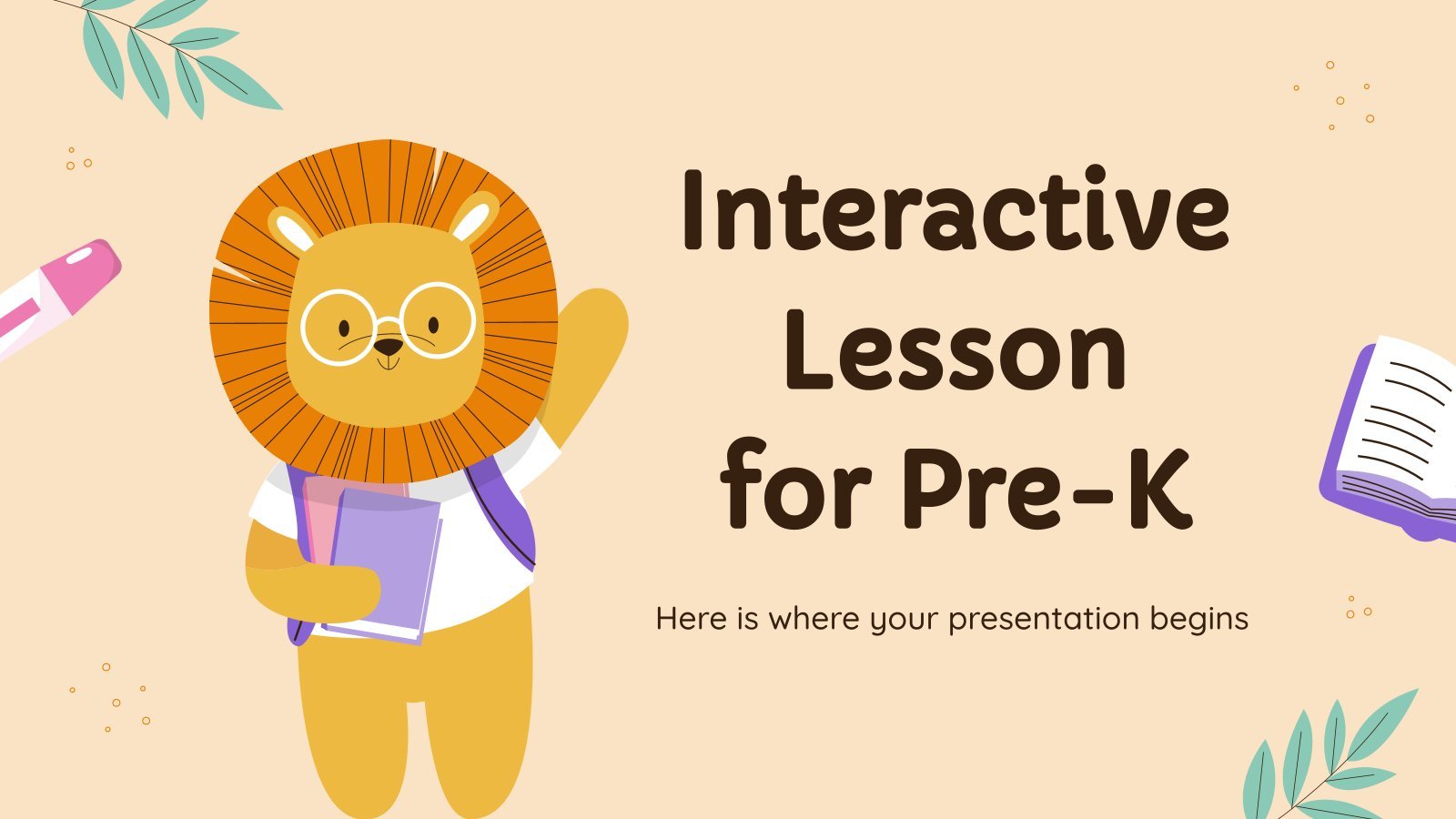
Back-to-school: Tips for families heading into middle school
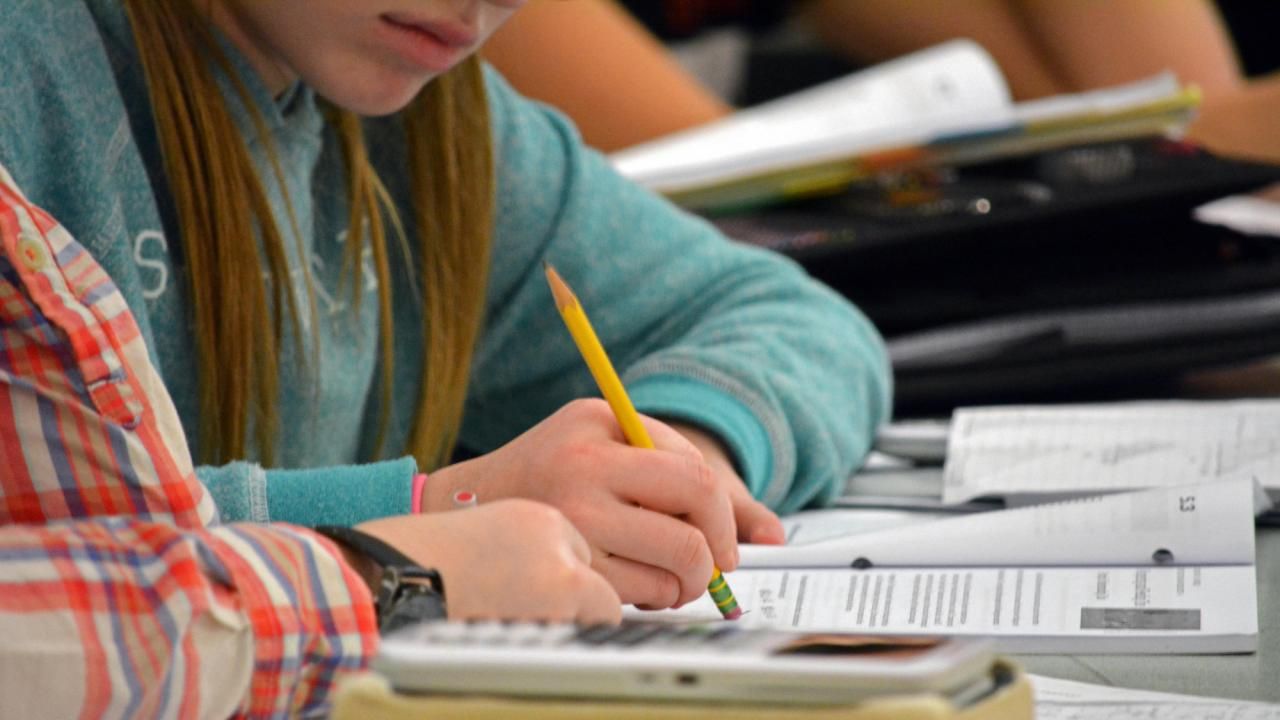
A trial for high school
Finding their 'thing', nc students would start career planning in middle school, under proposed bill, educational, social hurdles for teens and tweens, middle school standardized tests in north carolina: what to expect for your child, what parents can look out for, more on this, ask an expert: back-to-school tips for middle school and high school families, sharing lessons about mind, body, self: counselor focuses on empowering middle school girls, nc state aims for cfp spot: wolfpack must elevate from good to great under dave doeren, courage will celebrate olympians at match sept. 1, manny diaz enters first year at duke: can he build on mike elko's success, panthers, jets scuffle in joint practice, unc football: can the tar heels be better without drake maye.

WRAL Late News

WRAL WeatherCenter Forecast

Evening Pick 3 Pick 4 and Cash 5

Battery maker bringing more than 1,000 jobs, $1.4 billion plant to Edgecombe County

How to protect yourself from identity theft
- Investigates
- Houston Life
- Newsletters
WEATHER ALERT
89 advisories in effect for 23 regions in the area
Safety tips for se texas students walking to, from school in sizzling heat.
Daji Aswad , Meteorologist / Reporter
HOUSTON – Temperatures are continuing to sizzle students for the start of the school year. The National Weather Service issuing a Heat Advisory for all of SE Texas.
If you walk to school, the morning time is the easy part compared to the evening.
Compare Wednesday morning temperatures at 8 a.m. were 84 with a feels-like temperature of 94. By evening, the air temperature reached 99 with feels-like temperature over 108!
SEE ALSO: Athletic trainer tells us how Houston-area athletes beat the Texas heat
So here is a reminder on how to keep the kiddos safe on their journey to and from school.
It starts in the closet – loose-fitting shirts and pants. Let them pick out their favorite cap or hat that will shade their face. After finding the perfect outfit, head to the kitchen and grab a water bottle and even an electrolyte drink. Make sure they drink and refill throughout the day to stay hydrated.
RELATED: Staying hydrated in the summer heat
Before heading out to the door, apply sunscreen and map out a walking route that has more trees that will keep you shaded.
It is also important to talk to your children about what heat exhaustion feels like, so they can get help.
Heat Exhaustion symptoms include:
- Muscle cramps
- Nausea or vomiting
- Clammy skin
Feels-like temperatures will remain in the triple digits this week.
Copyright 2024 by KPRC Click2Houston - All rights reserved.
About the Author
I am grateful for the opportunity to share the captivating tales of weather, climate, and science within a community that has undergone the same transformative moments that have shaped my own life.
Recommended Videos
- - K-town Now
- Asia-Pacific
- - Storm Tracker
- Middle East
- Map of Memorials
- Entertainment
- - Video Games
- Europe Travel
- - Quick Trips
- - After Hours
- Pacific Travel
- The Meat and Potatoes of Life
- U.S. Travel
- Storm Tracker
- Rewards for readers
- Get Stripes
- Stripes Lite
- Archives/Library
- Special Publications
- Mobile Apps
- Email Newsletters
- Digital Access
- Home Delivery
- Marine Corps
- Coast Guard
- Space Force
- Archive photo of the day
- - Schedules Europe
- - Scoreboards Europe
- - Schedules Pacific
- - Scoreboards Pacific
- - Pacific Sports Blog
- - WW II Podcast
- - Military Matters
- - Force for Hire
- Out of Uniform
- - WW II Videos
- Communities
- Stripes Europe
- Stripes Guam
- Stripes Japan
- Stripes Korea
- Stripes Okinawa
- Our Other Websites
- In Memoriam
- Month of the Military Child
- Best of Germany
- Best of the Pacific
- Letters to Santa
10 ways parents can help their kids get back into school mode
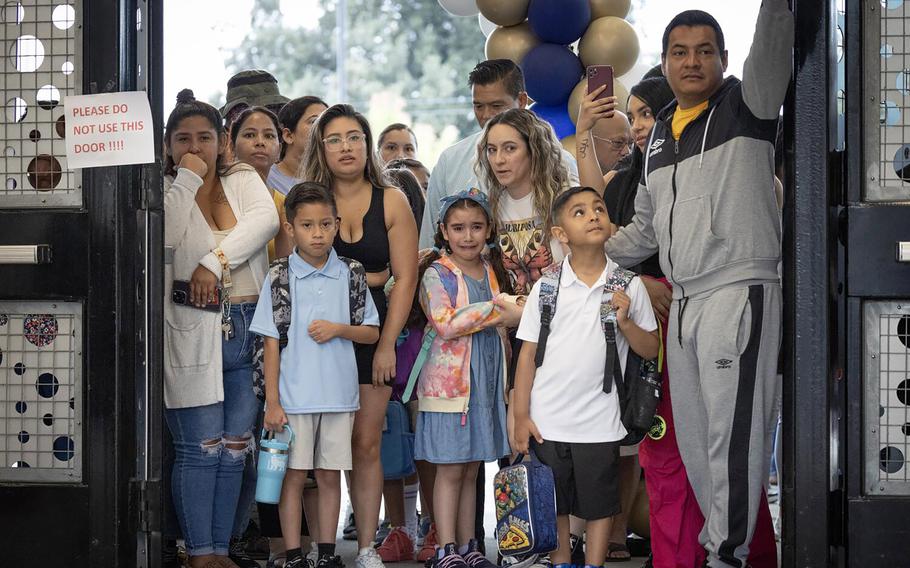
A child weeps with her parent before joining her classmates on the first day of school for the Anaheim Elementary School District at Roosevelt Elementary in Anaheim, Calif., Aug. 10. (Allen J. Schaben, Los Angeles Times/TNS)
LOS ANGELES — In a matter of days, the easygoing vibe of summer break will be replaced with the rigid schedules of a new school year.
The transition isn’t always easy, even for kids who are eager to return to the classroom. And if children are nervous about a new teacher, new school, or the prospect of making new friends, things can be even more fraught.
With summer break drawing to a close, The Times spoke with psychologists about how parents can help their children embrace a back-to-school mindset. Here’s their advice:
Don’t wait until the last minute to talk about the new school year
Instead of having one big conversation, make the transition a little at a time in the final week or two of summer break, said Samantha Sweeney, a licensed psychologist in Washington. You might spend a few hours gathering school supplies; another day, you can plot out what to pack for lunches. Activities like these provide opportunities for kids to talk about how they’re feeling about the upcoming year.
“If you bring it up all at once, you get freaked out all at once,” she said. “Doing it gradually is usually easier for kids.”
If your child is anxious about going back to school, don’t try to talk them out of it
It’s important to acknowledge their feelings and make them feel heard, experts say.
“If you say, ‘No no no, school is great and it’s going to be wonderful,’ they’ll say, ‘You don’t get it,’ or ‘You don’t understand,’” said Sweeney, co-author of “Working With Worry: A Workbook for Parents on How to Support Anxious Children.”
Trying to convince a kid to feel a certain way is likely to backfire, said Eileen Kennedy-Moore, a clinical psychologist in Princeton, N.J., who specializes in parenting and child development. “The harder we argue, ‘It’s going to be great!’ the harder they’ll insist, ‘It’s going to be terrible!’”
Don’t give false assurances
It’s risky to tell your child that everything will be just fine, or that school will be the same as it was last year, because that might not turn out to be true, Sweeney said.
Instead, boost their confidence by reminding them of past successes, like their track record of making new friends. You can also tell them you’ll be there to support them if they need help.
Try to pinpoint the source of their concern
Are they nervous because they don’t know what to expect from a new teacher? Will they be using a locker for the first time and they’re worried about forgetting the combination for their lock?
Once you have a better idea of what you’re dealing with, you and your child can work together to brainstorm a solution, experts said. Get the ideas flowing by reminding them of times they’ve overcome similar problems in the past.
“You’re guiding them but you’re not giving them all the answers,” said Mary Alvord, a cognitive behavioral psychologist in Rockville, Md., and co-author of “The Action Mindset Workbook for Teens.” “My goal with parents is to teach kids how to be more proactive, how to take initiative. It builds resilience.”
Consider a dress rehearsal of the first day of school
This isn’t necessary for everyone, but if a child is worried about how they’ll get to campus or where to find a bathroom, a dry run may allay their concerns.
“Knowing what to do can help kids feel more confident that they can cope,” said Kennedy-Moore, creator of the Kids Ask Dr. Friendtastic podcast.
The school may even allow your child to meet their teacher while they’re setting up their classroom, said Sweeney, who has worked as a school psychologist.
“When they walk in the door on the first day and see a familiar face, that can make a big difference,” she said.
Talk through worrisome scenarios
“It’s impossible to anticipate every possible problem, so an important question to have your child consider is, ‘Who could help you if you need help?’ Kennedy-Moore said.
You might be able to solve some problems in advance. For instance, if your child is concerned about having someone to sit with at lunch, encourage them to make a plan with a friend.
A conversation may also help your child realize that the things they’re afraid of are very unlikely to happen. If they’re scared that no one will pick them up and they’ll have to spend the night at school, ask if that’s ever happened to them, or to anyone they know personally.
Encourage kids to reconnect with their friends
Kids may be nervous about seeing some of their classmates for the first time in months. Smooth the way by arranging a playdate or two before school starts. Older kids might prefer to break the ice by reaching out with a text or via a social media app, Sweeney said.
Another way to help settle a child’s nerves is having them practice what they’ll do when they see their peers at school. Kennedy-Moore suggests they look the friend in the eye, smile and say “Hi,” along with the friend’s name. Follow up with a sincere compliment — “Cool backpack!” — or a question that starts with “how” or “what.”
To further put a child at ease, rehearse how they’d respond to a likely question. If asked, “How was your summer?” a child can reply “Great,” followed by a fact like “We went to the beach with my cousins,” Kennedy-Moore said.
Give your kids time to adjust their sleep schedule
Moving it gradually will make for an easier transition, experts say. Wake them up 15 or 30 minutes earlier each morning and encourage them to get dressed and eat breakfast to establish a routine. If the earlier start makes them tired, that will help them fall asleep earlier too.
Getting enough rest is an important factor in school success, said Alvord, adjunct professor at George Washington University’s School of Medicine and Health Sciences.
“A lack of sleep interferes with emotion regulation and with clarity of thought,” she said. “When you’re tired, everything seems much worse.”
But if the new sleep schedule doesn’t stick before school starts, don’t panic. Just keep their after-school schedules open to facilitate earlier bedtimes.
“Your kids will get over the jet lag from the schedule shift in a few days,” Kennedy-Moore said.
Don’t pass your own anxieties on to your kids
Children often look to adults for cues about how to respond in unfamiliar or unusual situations, Kennedy-Moore said.
“If we, as parents, are calm and generally positive about school, it makes it easier for kids to have positive expectations,” she said.
That may be easier said than done. When it comes to their children, parents tend to worry about the worst-case scenario and see things in all-or-nothing terms, Alvord said. If they can learn to recognize and adjust their thinking patterns, they can help their children to do the same, she said.
Focus on the positive
If the first day of school puts your child through the wringer, praise them for sticking it out.
“Say, I’m so proud of you; we’re getting ice cream,’” Sweeney said. “I have a personal philosophy that ice cream fixes everything.”
Sign Up for Daily Headlines
Sign up to receive a daily email of today's top military news stories from Stars and Stripes and top news outlets from around the world.
Sign Up Now
Staunton City School Board discusses update on Shelburne Middle School
STAUNTON, Va. (WHSV) - The Staunton City School Board discussed the Shelburne Middle School renovation project at its Monday meeting .
Superintendent Garret Smith delivered the updates on the renovation project with the aid of Shelburne Middle School Principal Lisa Warren. The main goal of the presentation was to request funding for phase II of the project.
The update mentioned phase I of the project is underway. This phase involved removing the division’s maintenance department from the basement of Shelburne Middle. The department moved into a more suitable leased facility last year but still needs a permanent home, which is what phase III focuses on. Superintendent Smith mentioned during Monday’s meeting that the maintenance department has been in the basement for 50 years.
Phase I also includes enhancing the school’s career and technical education (CTE) and STEM labs and classrooms, adding classroom space and reconfiguring administrative offices for improved flow and security. Phase I is expected to be completed in September.
The superintendent mentioned the need for $6 million to complete the renovations in phase II. The board is requesting bond financing, which allows the contractors to remain on site for the remainder of the year, if approved by the Staunton City Council. Phase II of the project involves a multi-tiered addition with collaboration space and seating for up to 350 people. It also offers community recreational and event space, collaborative learning spaces, accessible seating and improvements to storage areas and the performance stage in the Hern Gym.
The cost of Phase III of the renovation is to be determined, but the project involves acquiring and developing real property to consolidate the maintenance and transportation departments into one operations facility.
Copyright 2024 WHSV. All rights reserved.

W.Va. State Police prepares to close Cassie Sheetz case with no charges filed, pending DNA results

5 people, including 2 doctors, charged in connection to Matthew Perry’s death, authorities say

Baby at center of Va. Beach AMBER Alert dies in Maryland crash

Sheriff working to identify skeletal remains found in Frederick County

Dozens of candy and snack products sold at Walmart, Target, Dollar General recalled for possible salmonella contamination

Juvenile arrested in connection with deadly shooting

Former pharmacist-in-training accused of stealing pills from Walmart

Amazon delivery driver causes damage to Staunton man’s home, no fix 8 months later
Latest news.

Gov. Youngkin visits Shenandoah Valley to sign bills and give donations

Will Kayla be "baaack" at the Fair next year?

Rockingham County Fair: 8-year-old Jack on why farming is important
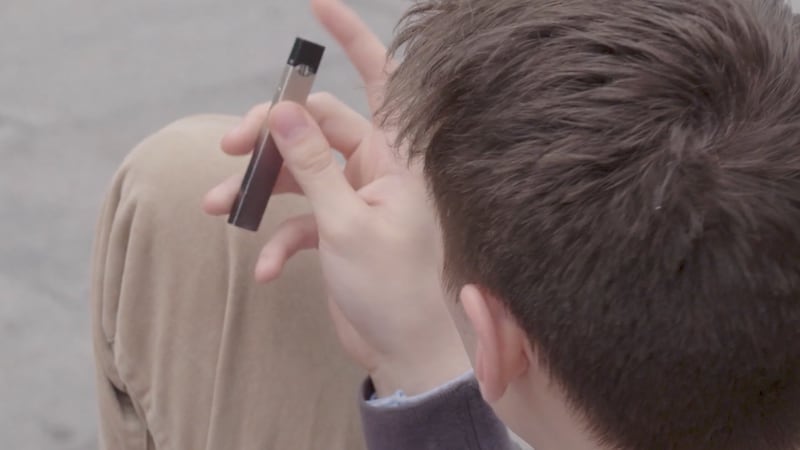
Harrisonburg Police Department warns about vape products targeting kids

Countdown to EndZone: Strasburg

Harrisonburg Police Department warns against vaping devices targeting kids

JMU volleyball tabbed favorites in Sun Belt East Division

IMAGES
VIDEO
COMMENTS
These are some of the memorable presentation elements that students have included to teach character growth or themes: Dramatic scene reenactments. Character letters, emails, interviews, or journals. Sketches and artwork. Selections that relate to particular characters or themes. Q and As with audience participation.
2. Use the right number of slides. Class presentations in high school and college will likely be 5 minutes or less. Follow your teacher's guidelines, of course, but generally, students will use 1-2 slides per minute. (That would be 5-10 slides for a 5-minute presentation.) 3.
Page numbers in slides really don't provide any useful information -- they just remind your students how long they've been watching. 5. Go BIG. Pursuant to tips #1 and #2, you're not going to win awards by cramming the most content on the fewest slides. Make text and visuals as large as you can.
Discover five presentation ideas that you can use the next time you're presenting in class! Get high-quality infographic templates https://www.easel.ly/inf...
General Tips: • Middle school classes are either on a "regular schedule", meaning they have seven 45 to 50 minute class periods per day, or on a "block schedule", meaning they have four 90-‐minute class periods per day. You should plan on having your presentation run for about 40 minutes, leaving a few minutes for questions.
Navigating school presentations can be daunting, but mastering presentation skills for students is vital for success. In this video, we'll delve into five es...
1. An Introduction to Microsoft PowerPoint. A smart way to introduce middle school students to Microsoft PowerPoint is by sharing example scenarios of when someone may use it. Then, transition to showing PowerPoint at the front of your class and highlighting what makes PowerPoint unique.
Be loud, be enthusiastic, and be happy. 7. Take a Pause, Prevent 'Ummmm…'. This is one of my favorite tricks, if you get stuck or nervous in the middle of your presentation, saying "um" or "Ah" feels good because it fills the silent room. There are 2 quick fixes: Talk slower and add pauses for emphasis. 8.
Practice being silent when you feel the urge to use one of these words. Vary your tone, volume, and speed: Interesting speakers vary the pitch (high versus low), volume (loud versus soft), and speed (fast versus slow) of their words. Doing so keeps your classmates interested and engaged in what you say.
Role-Play. If your presentation is about a historical figure, make a mask of his face and speak to your classmates in the first person. Download a picture of the figure's face from the Internet, edit it to resemble your face size and then print it. Open holes for the eyes and mouth with a pair of scissors, and punch two holes on the side to tie ...
In addition, interactive presentation activities using these templates also encourage the development of a holistic learning process in the classroom because they help focus on the three domains of learning: cognitive, affective, and psychomotor. 62. Interactive presentation do's and don'ts. Get this template. 63.
Giving an oral presentation in middle school can be a little scary for many students. However, if you work with the checklist below, you will be well prepared to do a terrific job. Tips on preparation, presentation aids, appearance, body language and verbal skills will give you everything you need for your big day.
Teaching Presentation Skills to Middle Schoolers. Matt has degrees in Journalism and Business and has taught a variety of courses at high schools and universities around the world. Presentation ...
Tips for speaking with confidence. Have you ever been nervous about giving a presentation in middle school or speaking to a large group of people? Tips for speaking with confidence.
Elementary School: Whenever possible, adults should work with kids to help them study. Make flash cards, talk over the material together, sing spelling word songs—model good study skills for them to help them learn. Middle School: Help students continue to use a variety of review strategies.
When combined, these framed a rubric that supported students in optimizing their presentation deliveries. The competencies are as follows: 1. Content knowledge. The presenter must display a deep understanding of what they are delivering in order to share the "what, why, how, and how-to" of the topic. 2.
Download the Science Subject for Middle School: Magnetic Force presentation for PowerPoint or Google Slides. If you're looking for a way to motivate and engage students who are undergoing significant physical, social, and emotional development, then you can't go wrong with an educational template designed for Middle School by Slidesgo!...
Why it works: Middle schoolers are in a transitional phase where they're seeking more independence. Scaffolding allows them to develop skills without feeling overwhelmed. 5. The Calm Corner. Designate a "Calm Corner" in your classroom where students can take short breaks to refocus when needed.
Here are ten PowerPoint presentation topics for higher school students: The Effects of Global Warming on Our Planet. The Evolution of Pop Music. Understanding the Stock Market. The Science of Habit Formation. Exploring Career Options in Technology. The Role of the United Nations in World Peace.
According to a study by the University of Chicago, "A 3.5 middle school GPA was found to give students about a 50 percent chance of college success.". They also found that "a one point difference in GPAs in eighth grade corresponds to a 20 percentage point difference in the likelihood of passing ninth-grade math.".
These are the best tips, tricks, and advice for speakers at an elementary school career day. The speech and presentation ideas are collected from educators, colleagues, friends, and my own experience. You'll read in this article about my learnings from hosting a career day, including: How to write your speech. What things to bring (props)
Tips for Career Day Presenters (Speaking to Students about Your Career) Here are some suggestions to help make your Career Day presentations a success. Each career and industry is unique, so plan what works for you and your area of expertise. Keep in mind that your audience is 14-16 year old high school students. For many
Contains easy-to-edit graphics such as graphs, maps, tables, timelines and mockups. Includes 500+ icons and Flaticon's extension for customizing your slides. Designed to be used in Google Slides, Canva, and Microsoft PowerPoint. 16:9 widescreen format suitable for all types of screens. Includes information about fonts, colors, and credits of ...
Ask an expert: Back-to-school tips for middle school and high school families null MINS AGO Sharing lessons about mind, body, self: Counselor focuses on empowering middle school girls
Middle school can be a challenging time for parents and students alike. These expert-backed strategies will steer your middle schooler through academic challenges and social hurdles to come out ...
Ramsey shared her tips for teens trying to navigate middle school and high school. The life coach's popular book, "I AM TEEN," helps kids celebrate their own uniqueness. She hopes to help ...
Board Meeting Presentation August 14, 2024 Superintendent's Report: Please click on link below to view presentation: https://5il.co/2tsnz. Find Us . Domingo Treviño Middle School 301 S. Inspiration Blvd. Alton, Texas 78573 Phone: (956) 323-2810 Fax: (956) 323-2811. Stay Connected .
If you walk to school, the morning time is the easy part compared to the evening. Compare Wednesday morning temperatures at 8 a.m. were 84 with a feels-like temperature of 94.
A child weeps with her parent before joining her classmates on the first day of school for the Anaheim Elementary School District at Roosevelt Elementary in Anaheim, Calif., Aug. 10.
he Staunton City School Board met Monday evening to discuss the Shelburne Middle School renovation project. The main goal of the presentation was to request funding for phase II of the project.